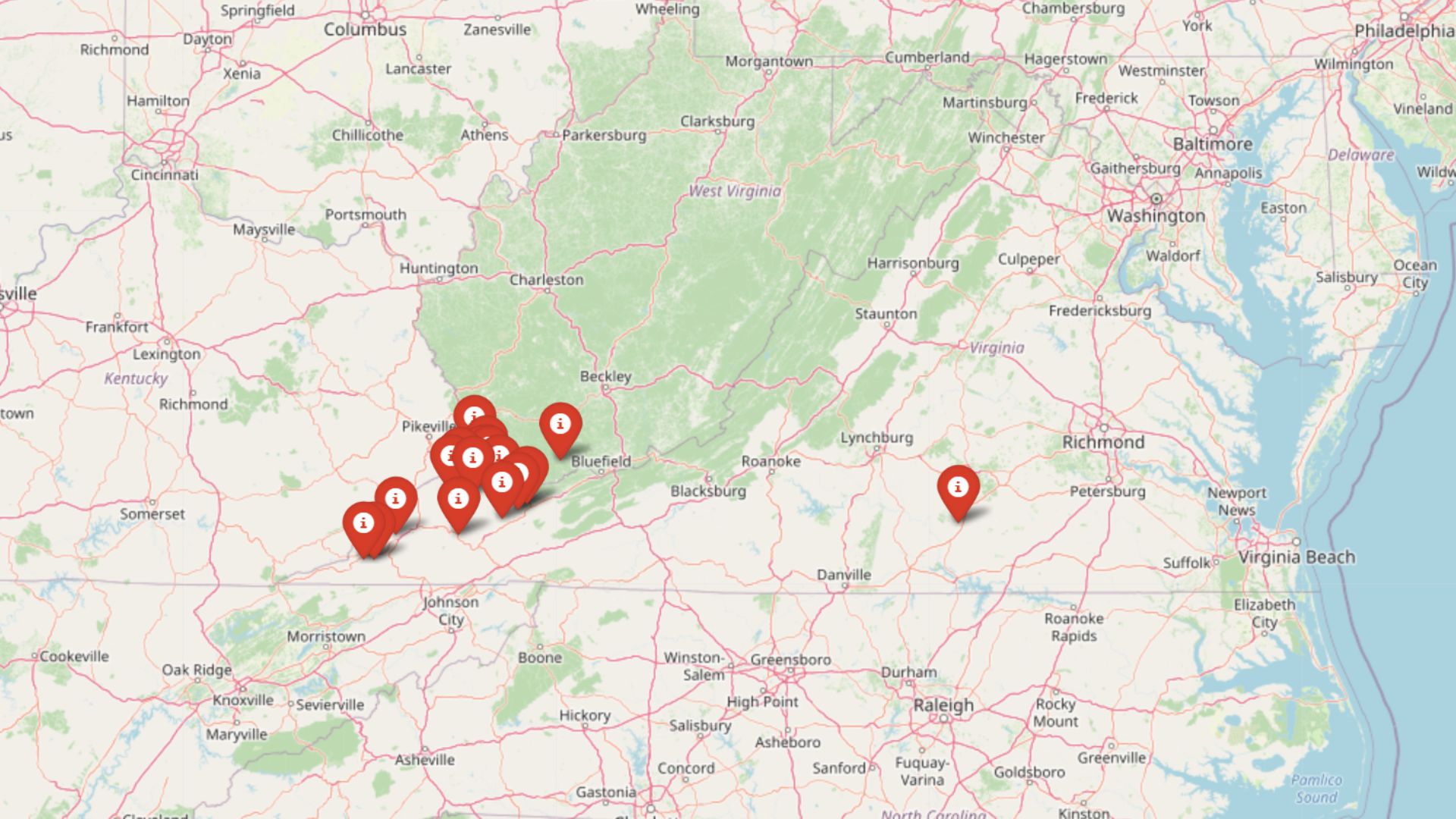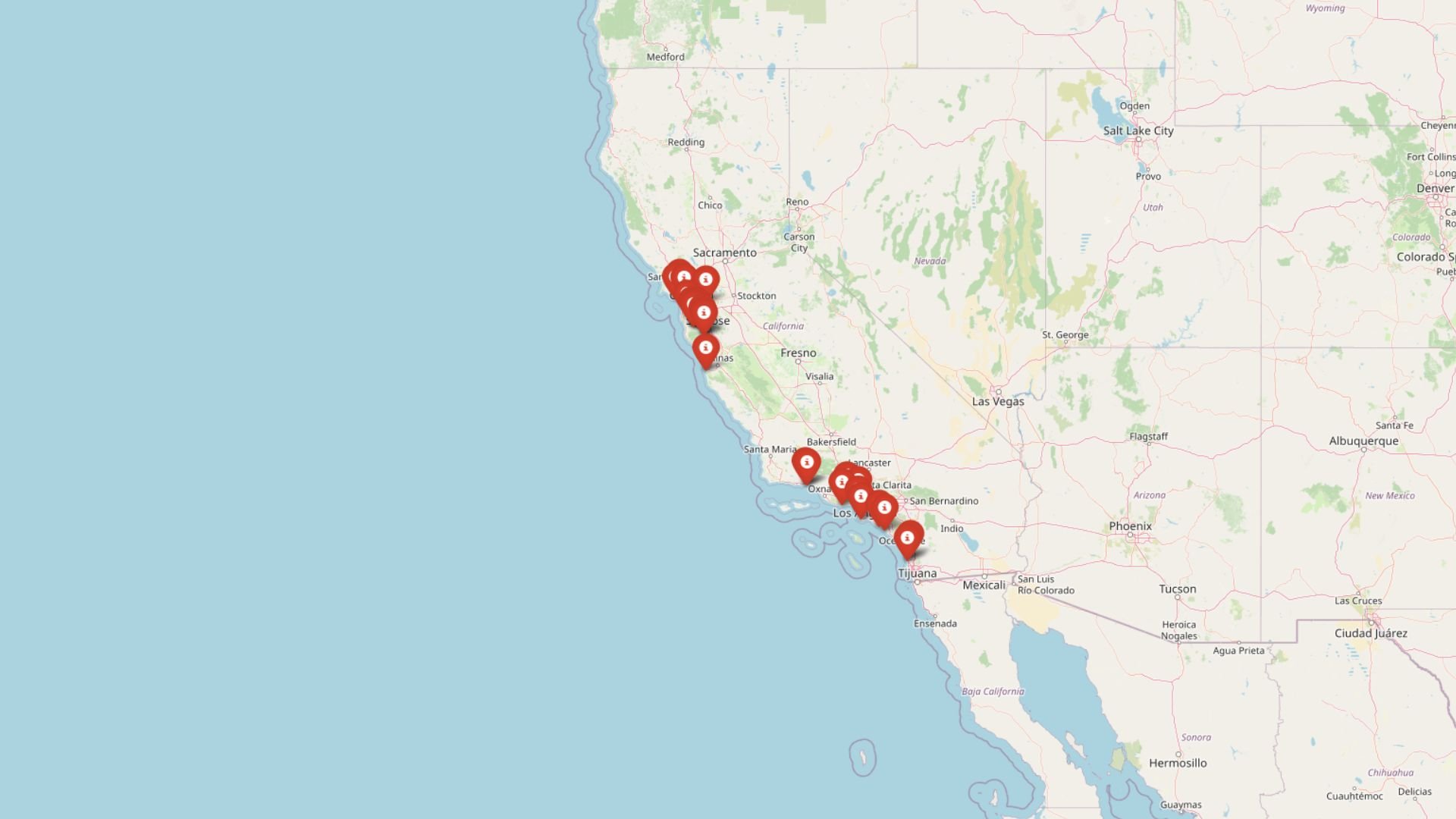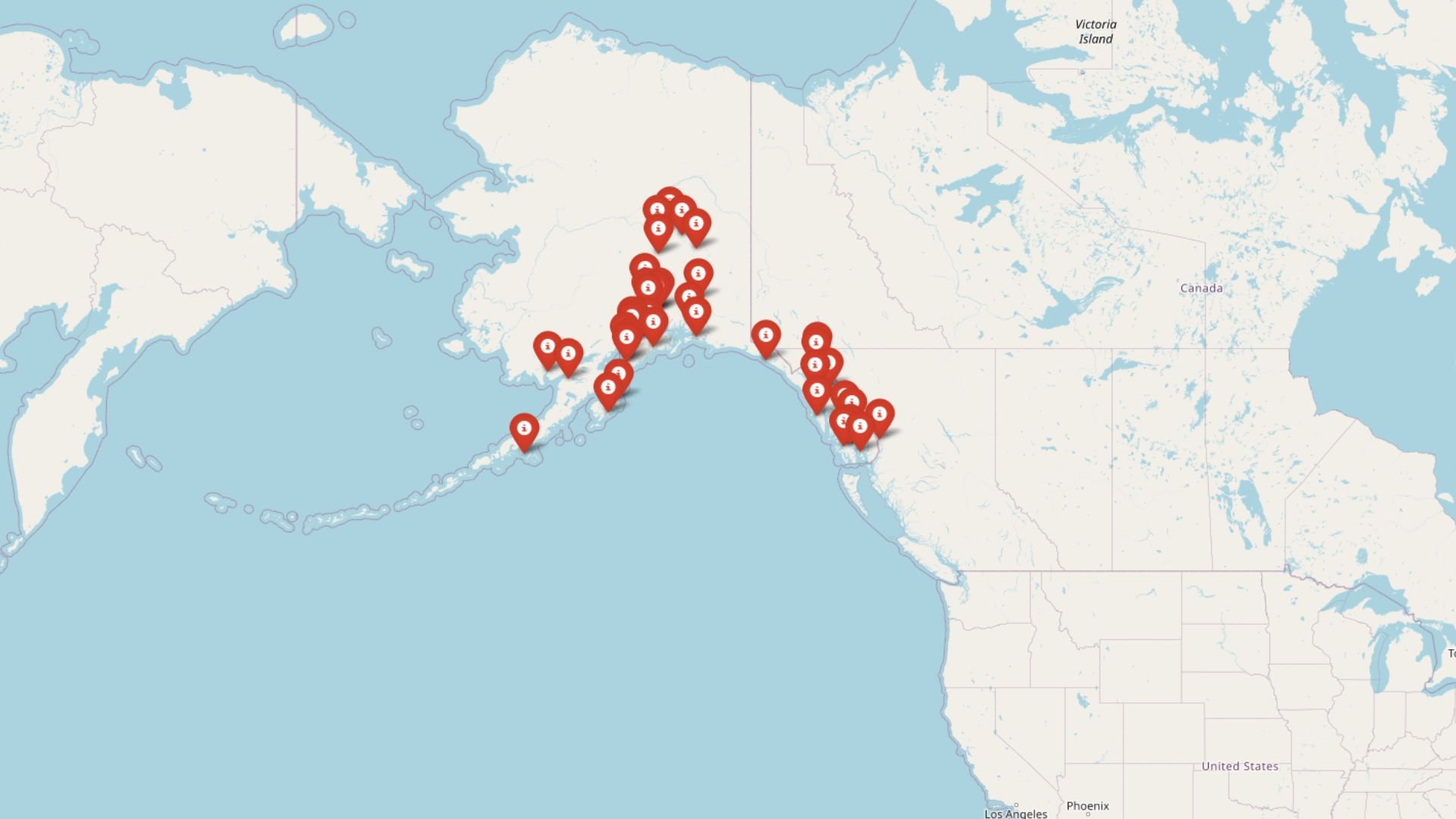
Alaska might be wild, but retirement here doesn’t have to be. We ranked 40 towns across the state using Overall Retirement Scores to find places that combine quiet living, natural beauty, and day-to-day comfort. Whether you’re drawn to laid-back lake towns like Big Lake or rugged coastal outposts like Kodiak, these spots show just how varied — and surprisingly livable — retirement in Alaska can be. Some offer unmatched scenery, others bring more services, and a few manage to balance both.
40. Big Lake — Wake to Mist on the Water
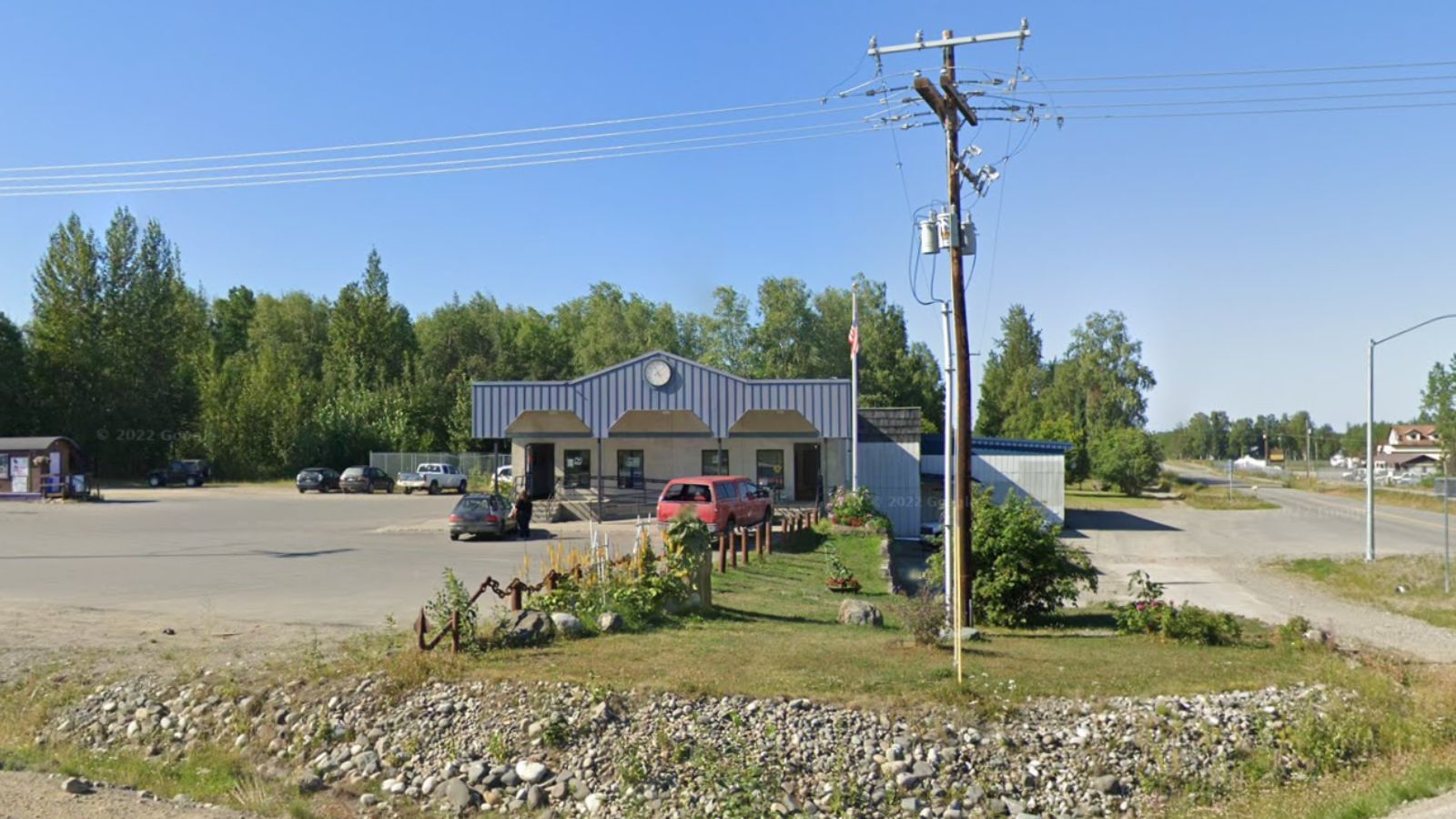
Some mornings in Big Lake begin with a soft grey mist drifting off the water, the only sound a loon calling across the still surface. This community hugs the lake’s southern shore, where retirees can swap the city’s pulse for ice fishing contests and paddleboard sunrises just 50 miles from Anchorage. A volunteer fire department, small convenience stores, and lakeside picnic shelters give you everything you need for peaceful living.
Homes here list at about $509,500 as of June 2025 (Realtor.com), many with private docks and wooded backyards. Summer brings community potlucks by the water’s edge, while winter hosts ice‑fishing derbies that draw friendly competition. For anyone craving quiet mornings on a private dock, Big Lake is a serene jumping‑off point.
Big Lake — ORS 51.85
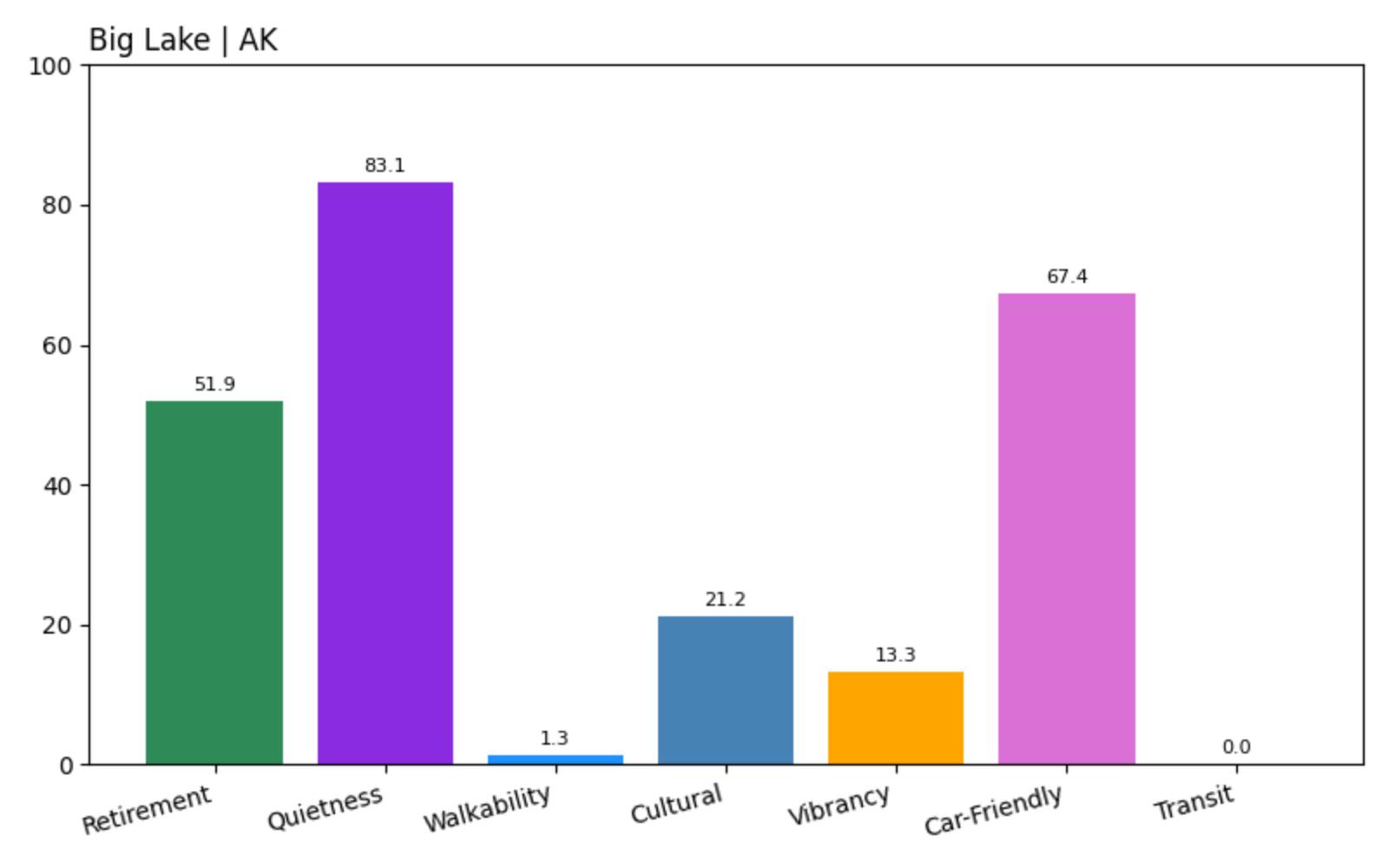
- Overall Retirement Score: 51.85
- Quietness: 83.14
- Walkability: 1.26
- Cultural amenities: 21.17
- Vibrancy: 13.28
- Car‑Friendliness: 67.42
- Transit‑Friendliness: 0.00
With an ORS of 51.85, Big Lake shines for peace but needs a car for errands. Cultural life is minimal, so it’s perfect if you want lakeside calm over downtown buzz.
39. Kasilof — Salmon Runners on the Riverbanks

Each summer, silver salmon pulse upstream in the Kasilof River, and retirees line the banks with rods and nets. Tucked on the Kenai Peninsula, this fishing village offers cozy riverside cabins and a seasonal farmers’ market where fresh salmon shares the table with garden berries. A handful of cafes, a historic post office, and quiet trails complete the picture.
Median homes in Kasilof go for about $350,000 as of June 2025 (Realtor.com), many boasting river views and forest edges. The town began as a late‑1800s trading post and still feels grounded in tradition—ideal if you prefer cast lines over crowded boardwalks.
Kasilof — ORS 52.11
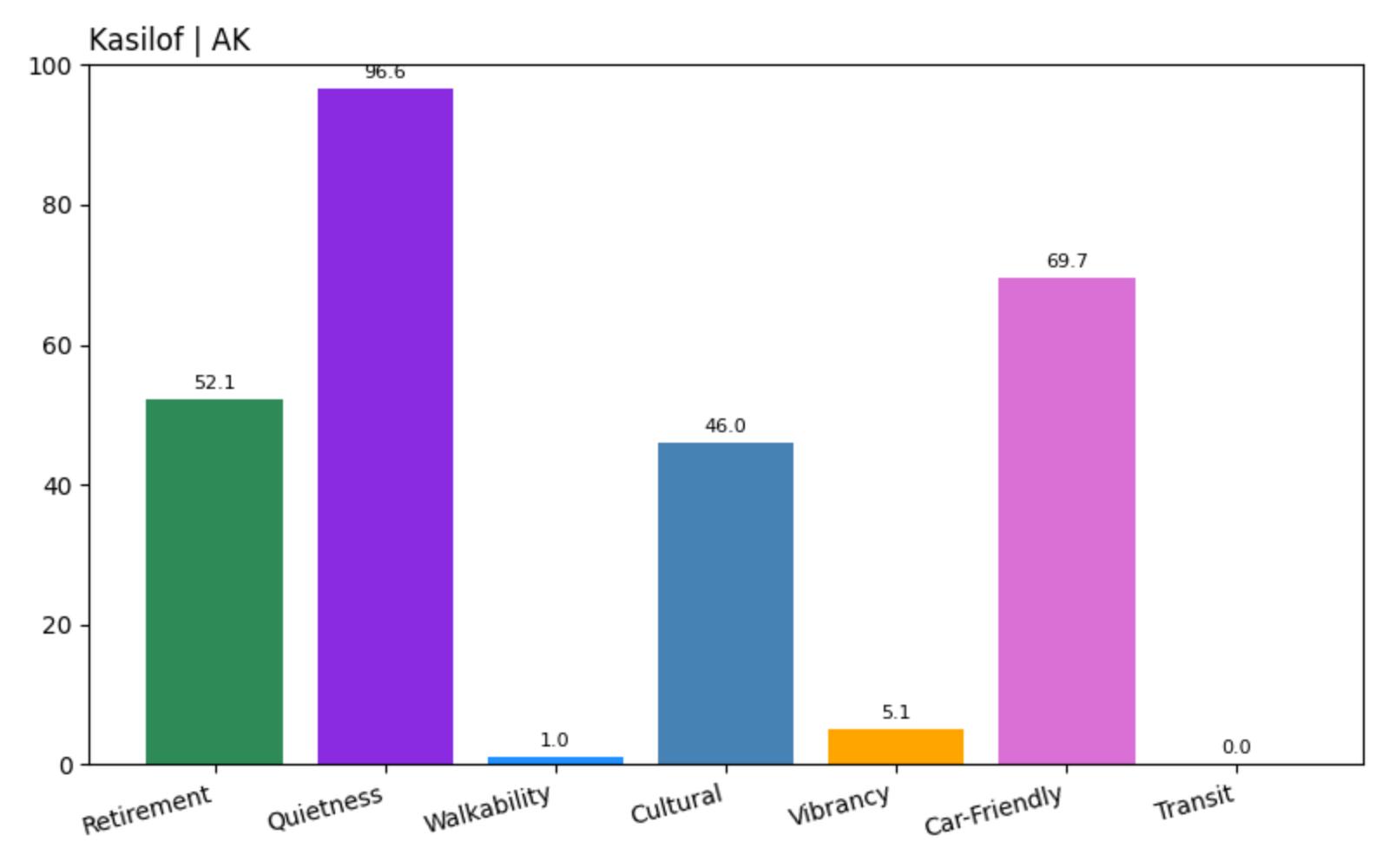
- Overall Retirement Score: 52.11
- Quietness: 96.59
- Walkability: 1.01
- Cultural amenities: 46.05
- Vibrancy: 5.14
- Car‑Friendliness: 69.66
- Transit‑Friendliness: 0.00
A 52.11 ORS highlights Kasilof’s hushed river life—but you’ll need wheels for groceries. It’s a top pick if the pull of salmon runs beats crowded sidewalks.
38. Kodiak — Sea Breeze and Island Services

Feel the salt‑tinged air of Kodiak every time you step outside: fishing boats creak at the docks, and sea otters bob offshore. As the island’s main city, Kodiak combines coastal living with hospital wings, college courses, and a lively harborfront market. Native‑art galleries and waterfront trails give retirees plenty to explore without sacrificing modern comforts.
In June 2025, median listings hovered around $485,000 (Realtor.com), many within walking distance of shops and cafes. Founded in 1792, Kodiak’s Russian‑influenced streets still buzz with festivals celebrating sea lions and salmon—a fine trade‑off for island isolation.
Kodiak — ORS 53.34
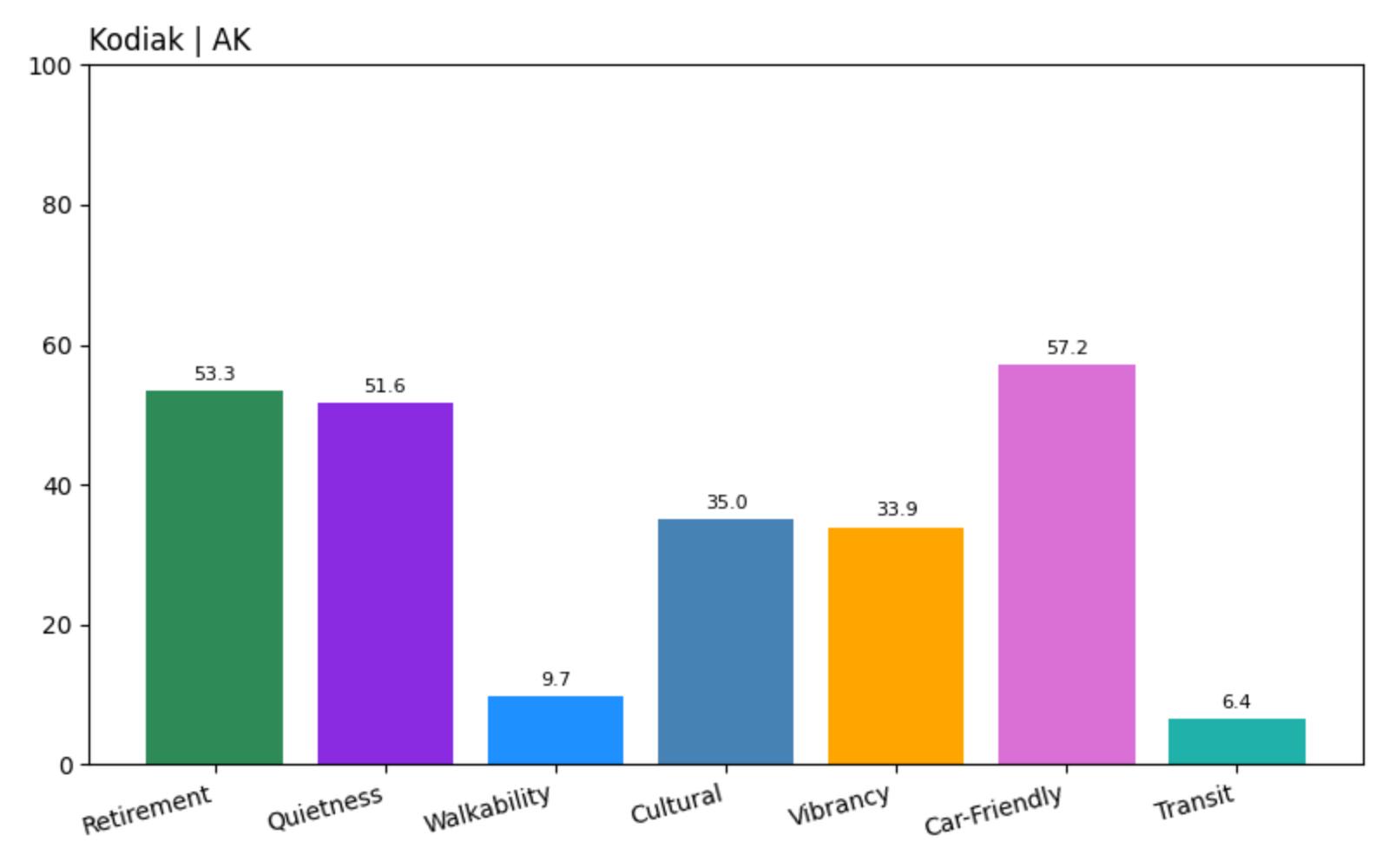
- Overall Retirement Score: 53.34
- Quietness: 51.64
- Walkability: 9.70
- Cultural amenities: 34.97
- Vibrancy: 33.94
- Car‑Friendliness: 57.20
- Transit‑Friendliness: 6.43
Kodiak’s mid‑50s ORS reflects a busier town vibe: moderate noise, decent walkability, and ferry‑style transit. Ideal if you want island life plus hospitals and galleries.
37. Soldotna — Where Creek Meets River

At the junction of Soldotna Creek and the Kenai River, retirees find fish‑filled waters and riverside parks just a few minutes from borough services. Soldotna hosts a hospital, a university extension, and a library, so you’re never far from a book, lecture, or lab test. Summer farmers’ markets and winter sled dog meets round out the calendar.
Homes here average around $443,800 in June 2025 (Realtor.com), many within easy reach of downtown trails. Born in 1967, Soldotna has grown up around its medical center and campus—perfect if you prefer a small‑town pace backed by full‑service support.
Soldotna — ORS 55.14
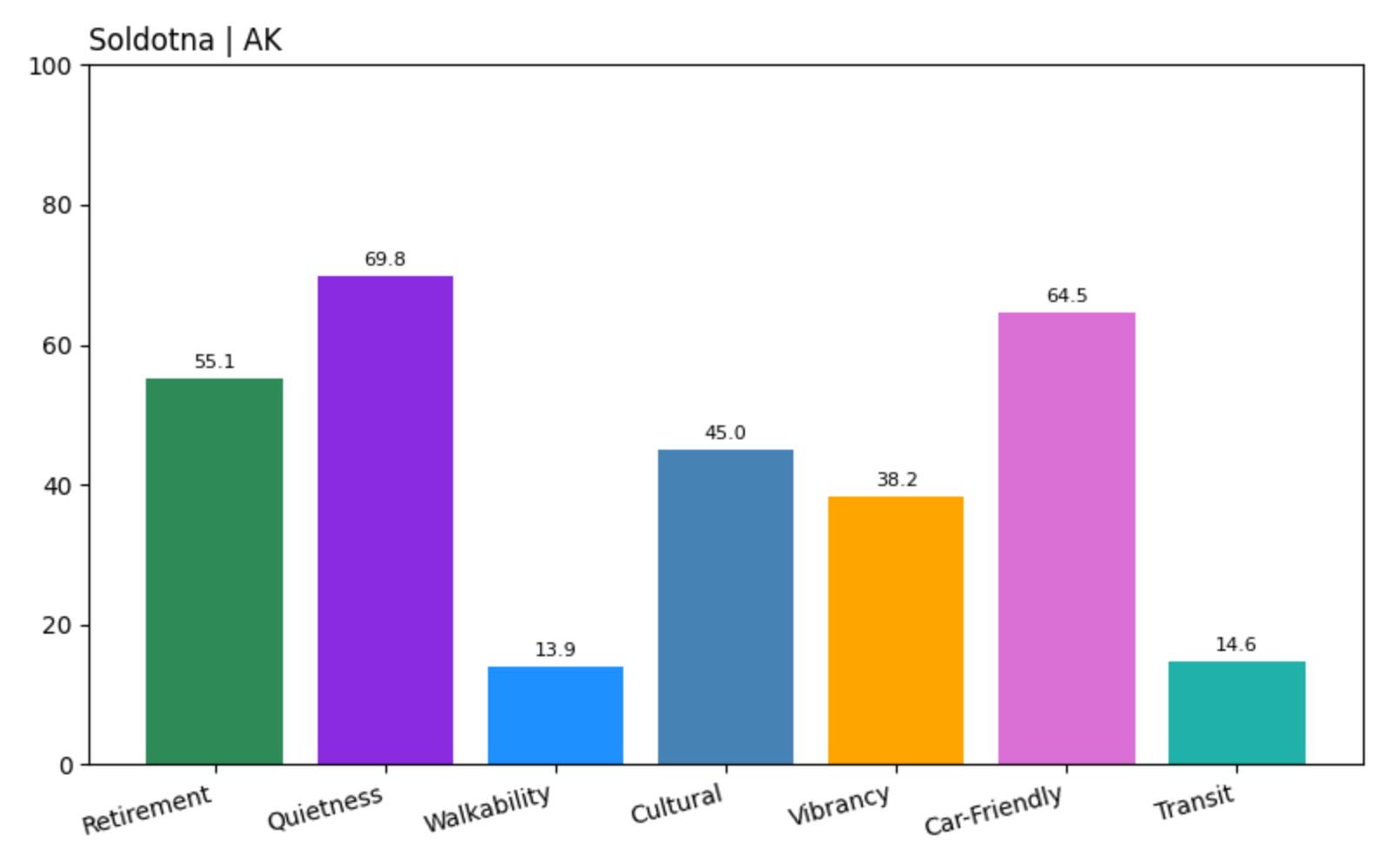
- Overall Retirement Score: 55.14
- Quietness: 69.75
- Walkability: 13.89
- Cultural amenities: 44.97
- Vibrancy: 38.21
- Car‑Friendliness: 64.50
- Transit‑Friendliness: 14.63
A 55.14 ORS shows Soldotna blending borough comforts with quieter roads. Walkable trails and some transit ease errands, making it a balanced retiree pick.
36. Palmer — Giant Vegetables and Valley Views

Every August, Palmer bursts into giant‑vegetable competition at the State Fair, where cabbages can outweigh a toddler. Nestled in the Matanuska Valley, retirees can stroll farm stands, sample homemade pies, or take berry‑picking excursions with mountain panoramas. Clinics, an arts center, and grocery stores fill out the calendar.
June 2025 listings averaged about $510,000 (Realtor.com), ranging from historic homesteads to modern valley‑view homes. Settled by New Deal farmers in the 1930s, Palmer still honors its agricultural roots—ideal if you want farmland charm without losing health services.
Palmer — ORS 57.32
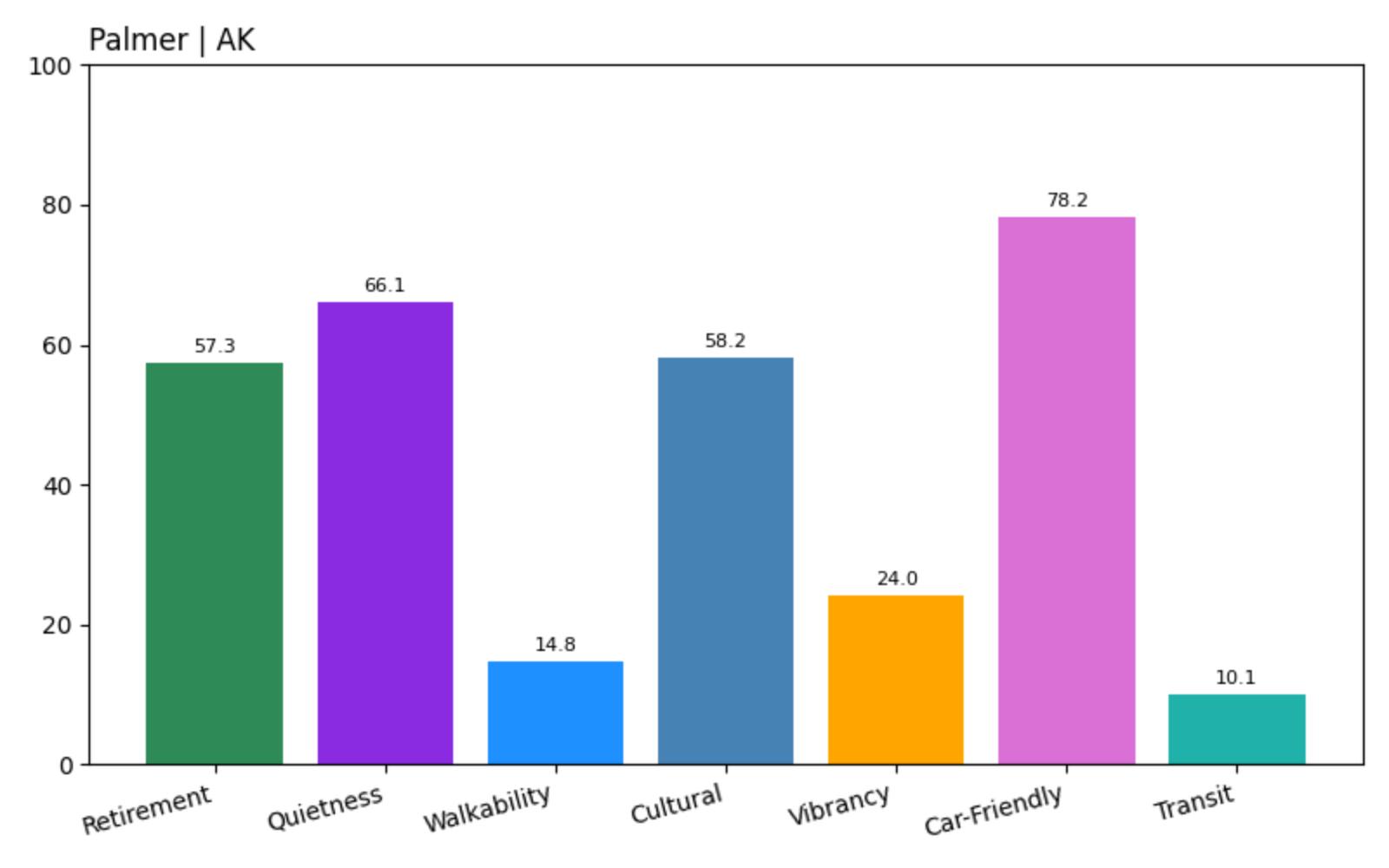
- Overall Retirement Score: 57.32
- Quietness: 66.06
- Walkability: 14.80
- Cultural amenities: 58.20
- Vibrancy: 24.03
- Car‑Friendliness: 78.24
- Transit‑Friendliness: 10.10
With a 57.32 ORS, Palmer mixes modest quiet with strong cultural draws—from fairs to museums. Better walkability than most and some transit make it a pleasant valley‑life spot.
35. Skagway — Historic Gold Rush Charm Meets Cruise-Ship Crowds
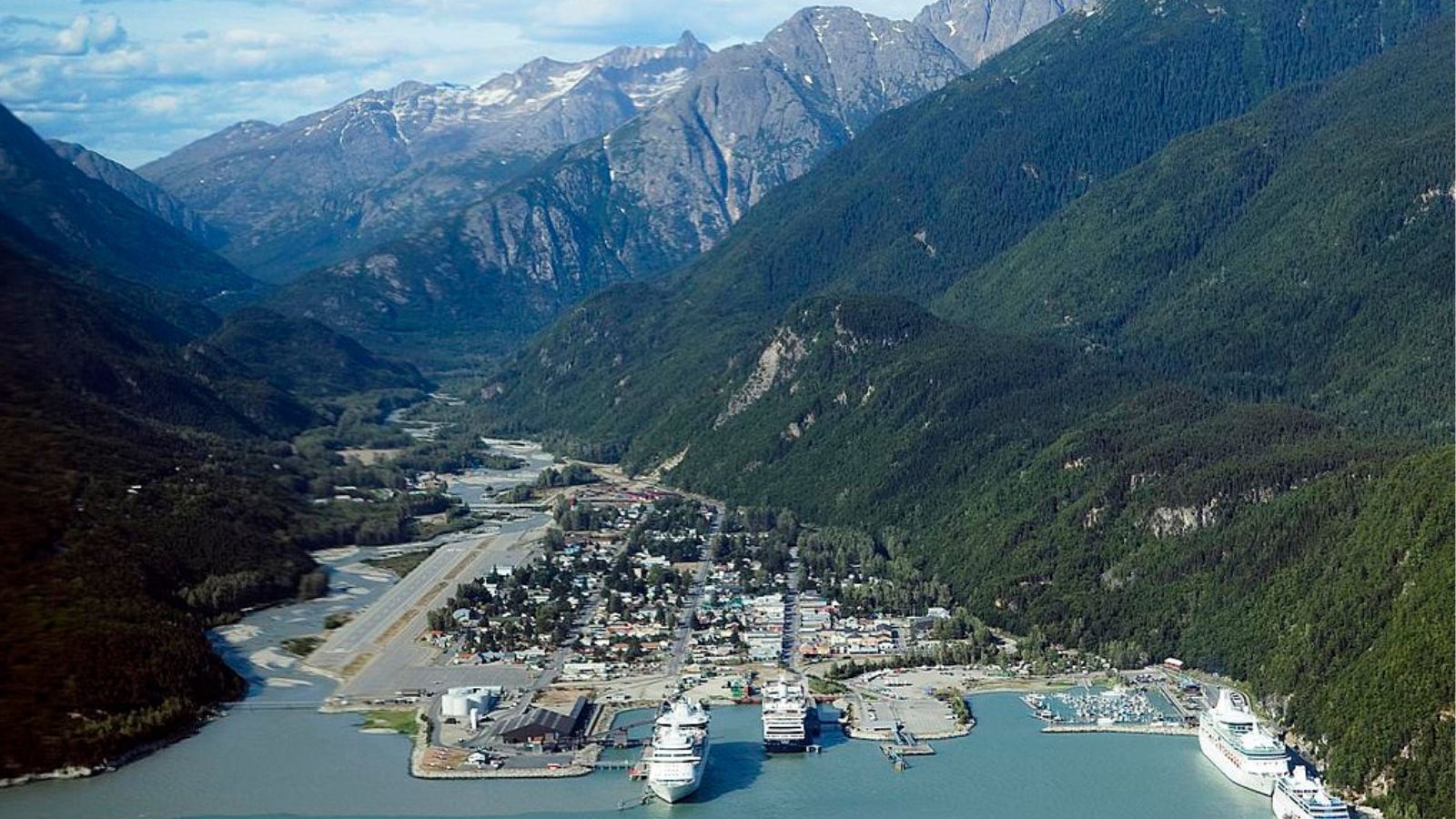
Skagway’s sheer cliffs and wooden boardwalks tell the tale of the 1897 Klondike Gold Rush, when prospectors flooded through town in search of fortune. Today, retirees can stroll beneath preserved storefronts, then escape to quieter hiking trails once the cruise‑ship season ends. Between the Yukon Route railway rides and small local cafés, it’s history you can touch—just plan around the summer surge of tourists.
Homes here average around $445,000 as of June 2025, many perched on steep lots overlooking the inlet. A single clinic and volunteer fire department handle emergencies, while a handful of shops and galleries stay open year‑round. Winters bring back quiet streets and snow‑packed trails, perfect for those who prefer solitude over crowds.
Skagway — ORS 57.49
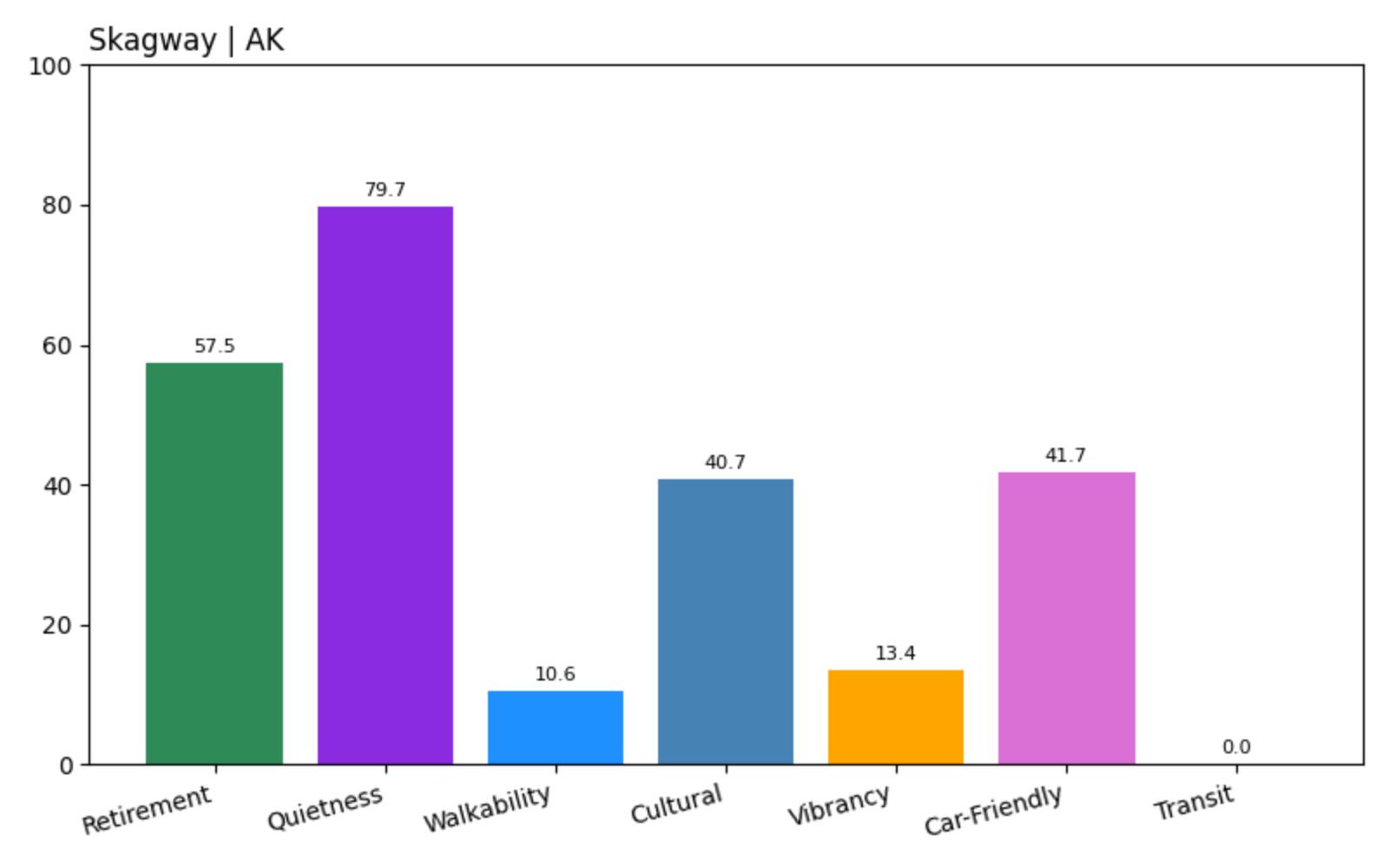
- Overall Retirement Score: 57.49
- Quietness: 79.66
- Walkability: 10.55
- Cultural amenities: 40.66
- Vibrancy: 13.40
- Car‑Friendliness: 41.74
- Transit‑Friendliness: 0.00
Skagway’s ORS of 57.49 reflects its seasonal swings: quiet winters and bustling summers. The modest walkability of Main Street makes errands easy on foot, but no public transit means a car or shuttle is essential most of the year. Retirees who relish living history and don’t mind planning around cruise‑ship timetables will find Skagway uniquely rewarding.
34. Kenai — Riverbanks and Borough Services in Harmony
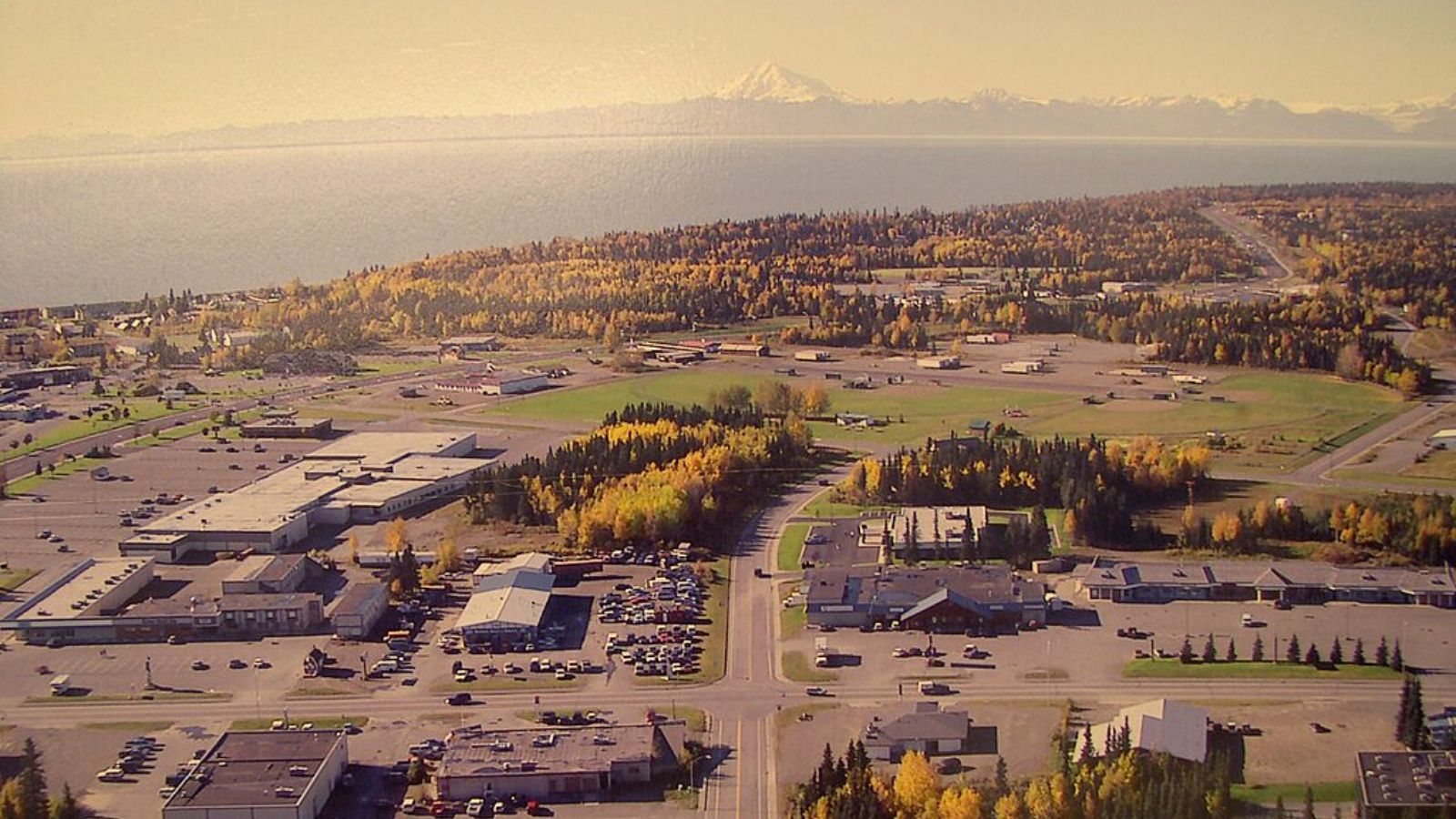
Kenai sits where the mighty Kenai River meets Cook Inlet, creating a magnet for anglers and bird watchers alike. Retirees benefit from a full hospital campus, a winter hockey rink, and community college courses just off main streets lined with bakeries and eateries. Each spring brings world‑class king salmon runs, drawing both locals and visiting fishermen.
Median homes list near $400,000 as of June 2025, with many featuring river views or wooded lots. The city’s two grocery stores, library, and veterans’ clinic provide daily conveniences, while a small arts pavilion hosts seasonal craft fairs. For those wanting robust services without big‑city bustle, Kenai strikes a comfortable balance.
Kenai — ORS 57.59
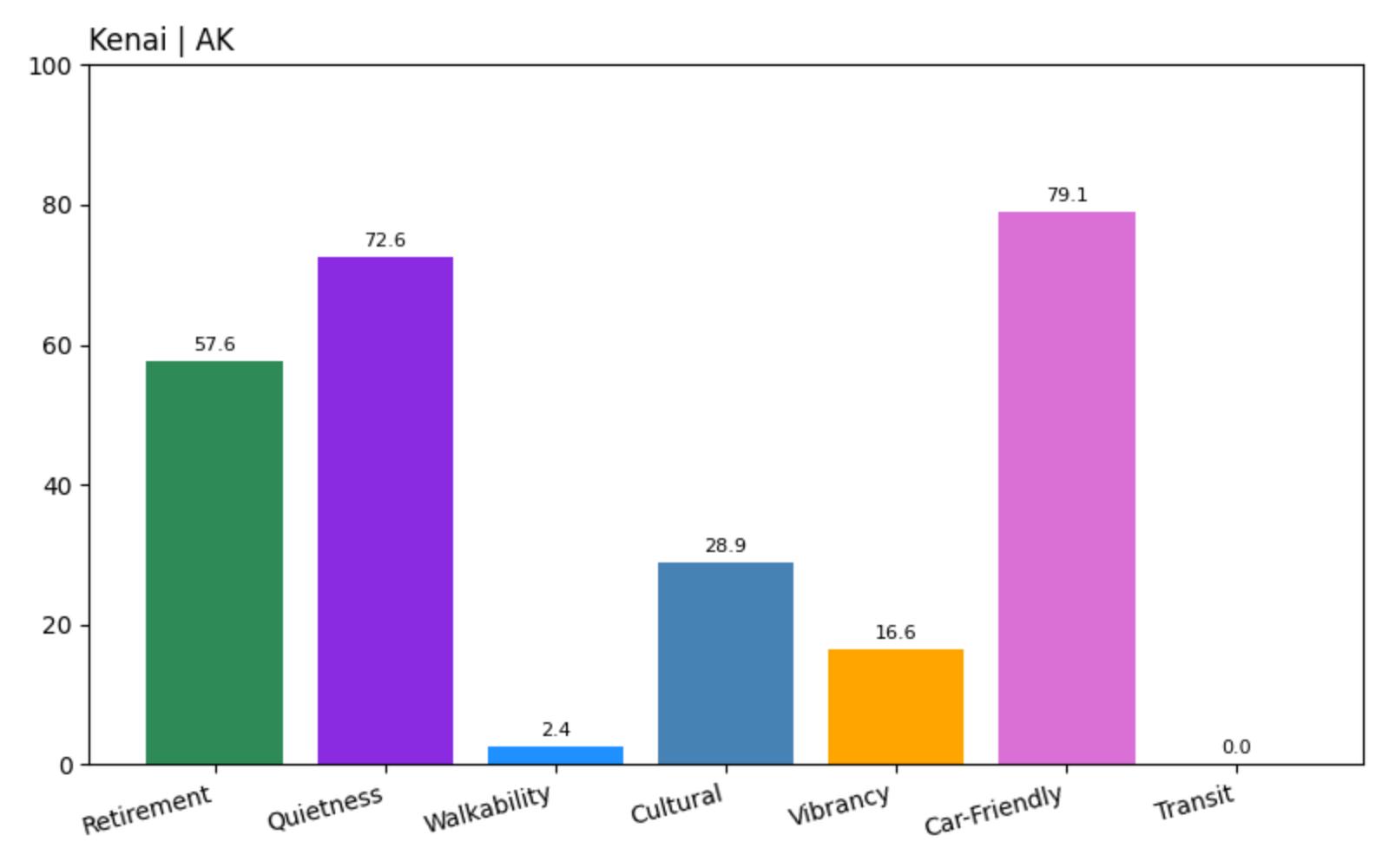
- Overall Retirement Score: 57.59
- Quietness: 72.61
- Walkability: 2.44
- Cultural amenities: 28.91
- Vibrancy: 16.56
- Car‑Friendliness: 79.08
- Transit‑Friendliness: 0.00
With an ORS of 57.59, Kenai delivers steady community life with moderate traffic noise. Walkability is limited to a few blocks downtown, so a vehicle remains key for errands. The cultural and vibrancy scores reflect seasonal festivals and river events, ideal for retirees who value activity balanced by accessible services.
33. Old Harbor — Rustic Island Living off Kodiak
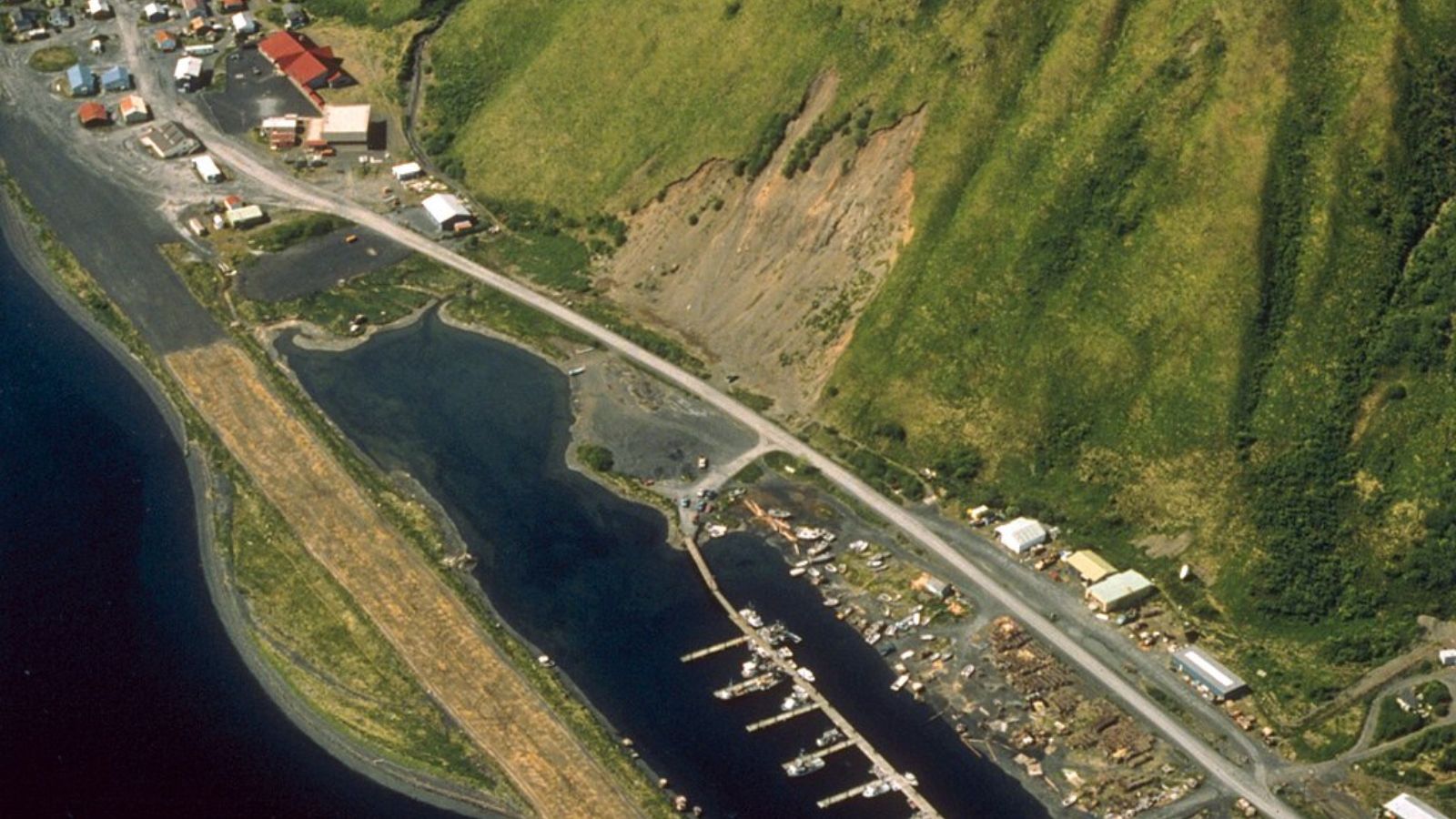
Old Harbor clings to Kodiak Island’s eastern shore, where wooden boardwalks replace streets and the sounds of drying racks echo tales of generations past. Retirees here share daily life with harbor seals and eagles, and they gather at the co‑op store for essentials and neighborhood news. Access is by boat or plane, making each supply trip a small adventure.
Median listings hover around $250,000 as of June 2025, often tucked among spruce trees or overlooking tide pools. A small health clinic and tribal offices cover basic needs, while community potlucks and subsistence fishing keep traditions alive. For those ready to embrace self‑sufficient island life, Old Harbor offers a quiet retreat.
Old Harbor — ORS 58.69
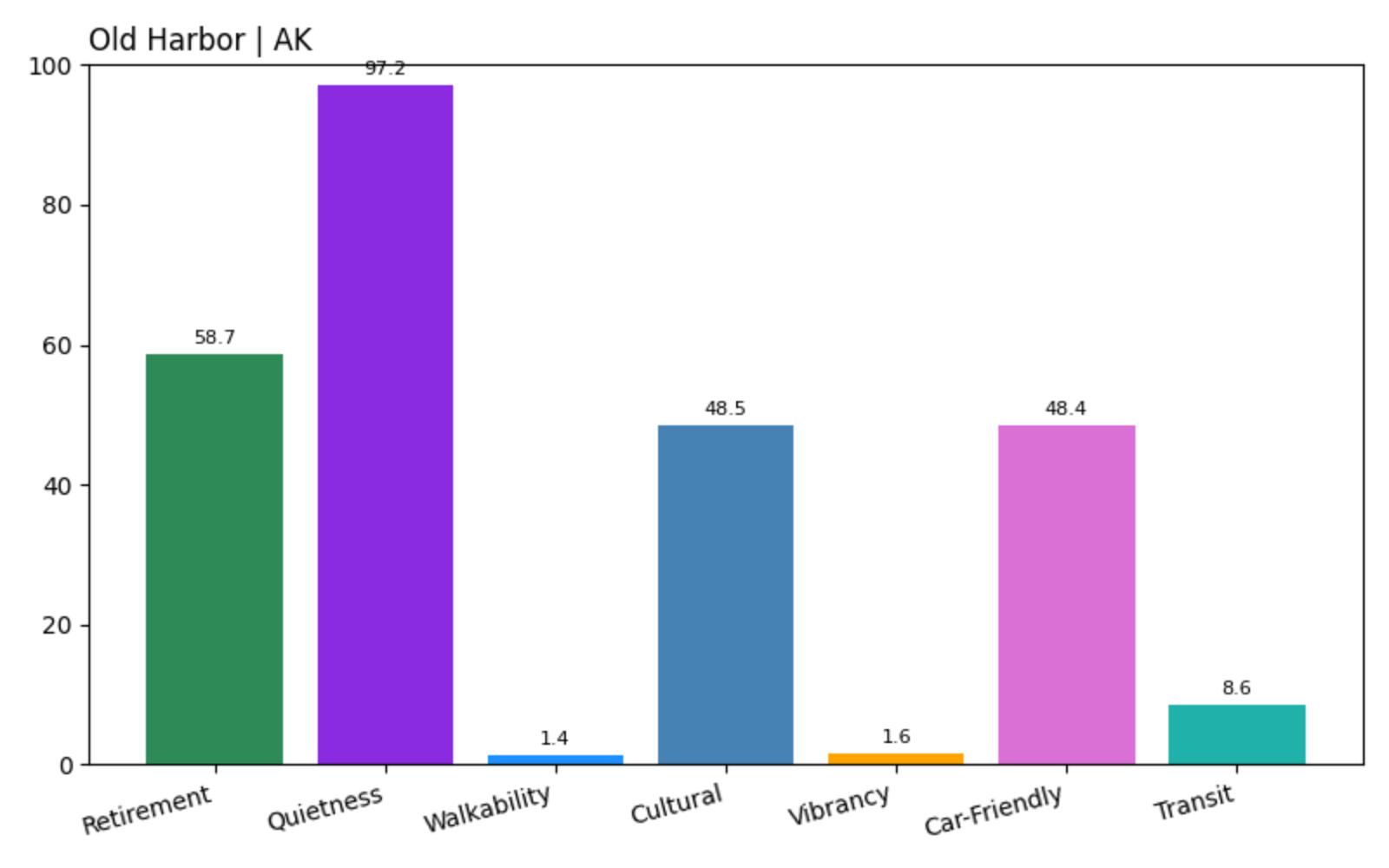
- Overall Retirement Score: 58.69
- Quietness: 97.22
- Walkability: 1.39
- Cultural amenities: 48.53
- Vibrancy: 1.61
- Car‑Friendliness: 48.43
- Transit‑Friendliness: 8.62
Old Harbor’s ORS of 58.69 underscores its peaceful isolation and cultural connection to native heritage. Limited walkability means you’ll rely on footpaths and small boats, with no formal transit. Retirees keen on living history and wildlife immersion will find Old Harbor richly rewarding.
32. Juneau — Capital City with Glacier Views

Juneau’s steepside streets climb from Gastineau Channel to the looming Mendenhall Glacier, marrying urban comforts with wild panoramas. Retirees can catch a show at the Perseverance Theatre, join senior swims at the aquatics center, and grab fresh salmon tacos downtown. Even local buses offer glimpse‑filled rides along fjord‑lined routes.
Median homes list near $600,000 as of June 2025, reflecting limited land availability and strong demand. Hospitals, specialty clinics, and a university campus all lie within easy reach of historic downtown sidewalks. For those who want cultural depth without mainland roads, Juneau’s ferry and airport links keep you connected.
Juneau — ORS 62.03
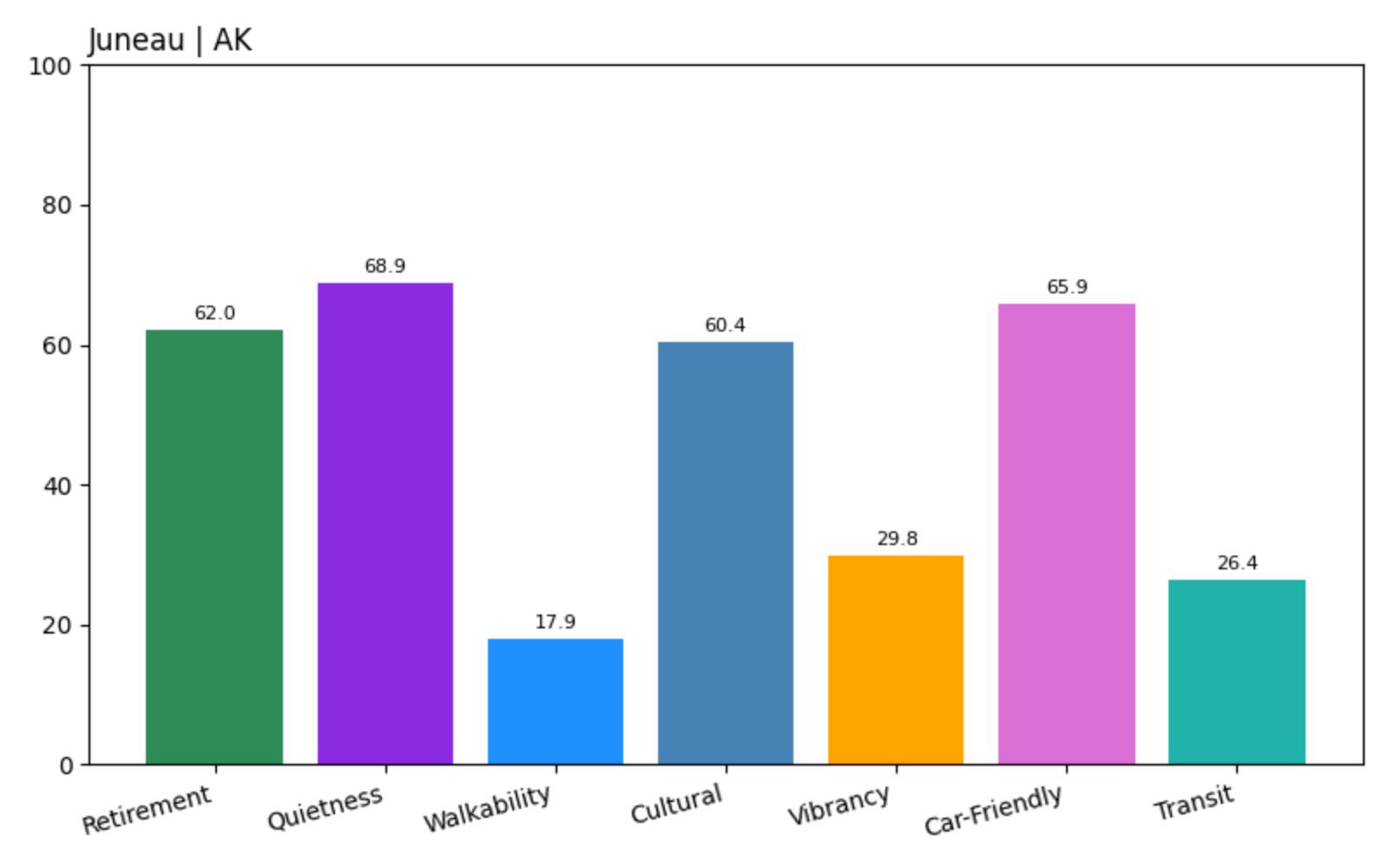
- Overall Retirement Score: 62.03
- Quietness: 68.88
- Walkability: 17.88
- Cultural amenities: 60.38
- Vibrancy: 29.84
- Car‑Friendliness: 65.93
- Transit‑Friendliness: 26.44
At 62.03, Juneau ranks above many smaller towns thanks to strong cultural and transit options. Its downtown walkability and bus network help retirees navigate without a car. The trade‑offs are higher housing costs and ferry scheduling—but the glacier‑framed arts and services make it worthwhile.
31. Sand Point — Aleutian Island Port Life
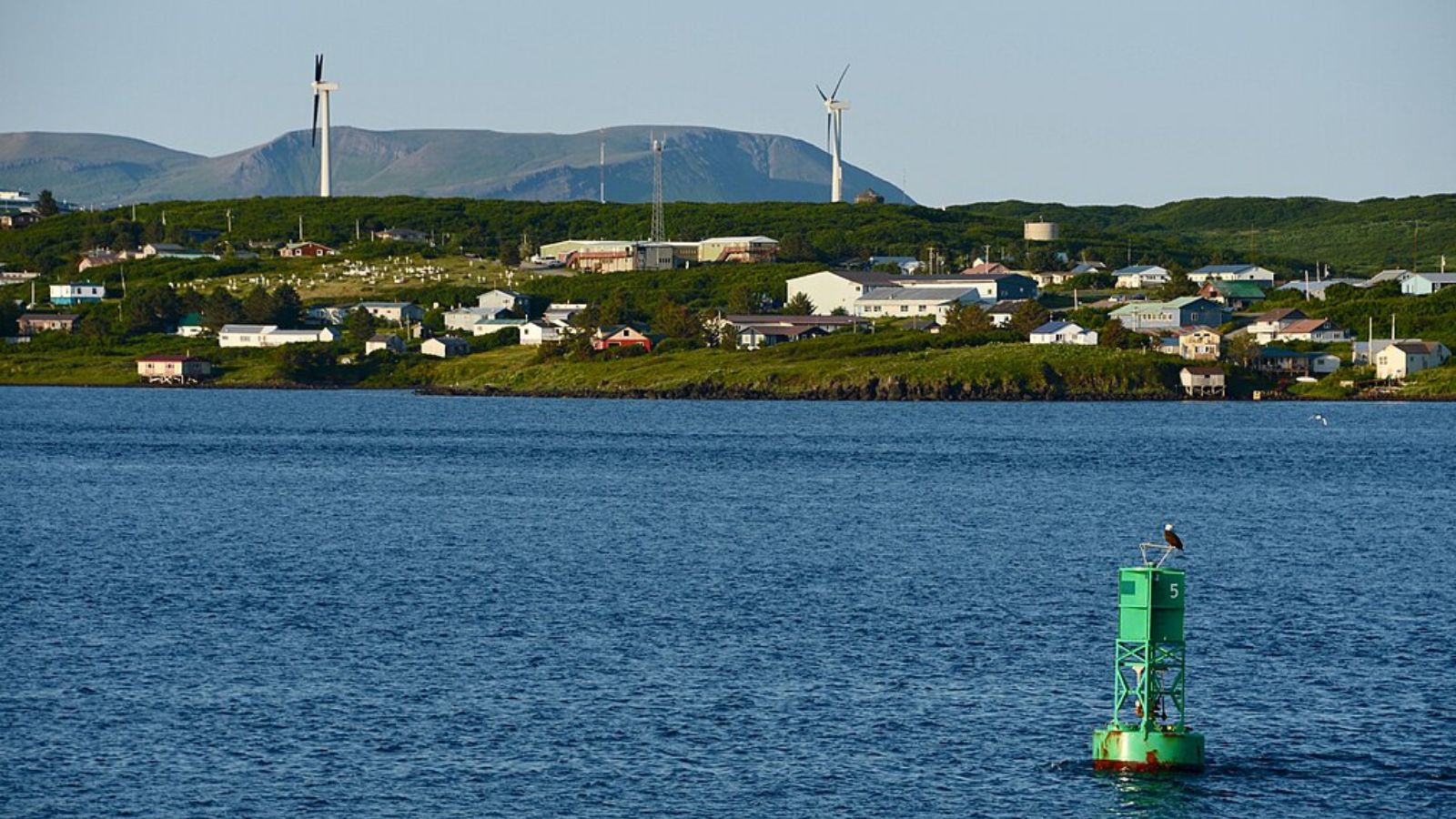
Sand Point’s docks teem with fishing vessels that define life on Popof Island, where retirees watch the sun glint off catch‑filled nets each morning. A clinic, elementary school, and co‑op store form the town’s backbone, while cedar‑lined beaches offer quiet strolls after workboats return. Flights and ferries tie the community to the mainland.
Median listings hover around $280,000 as of June 2025, many within easy reach of the town dock. Community fish fries, Legion Hall dances, and library events add local flavor to rugged island days. For retirees drawn to working ports and salt‑air living, Sand Point delivers an authentic maritime pace.
Sand Point — ORS 65.23
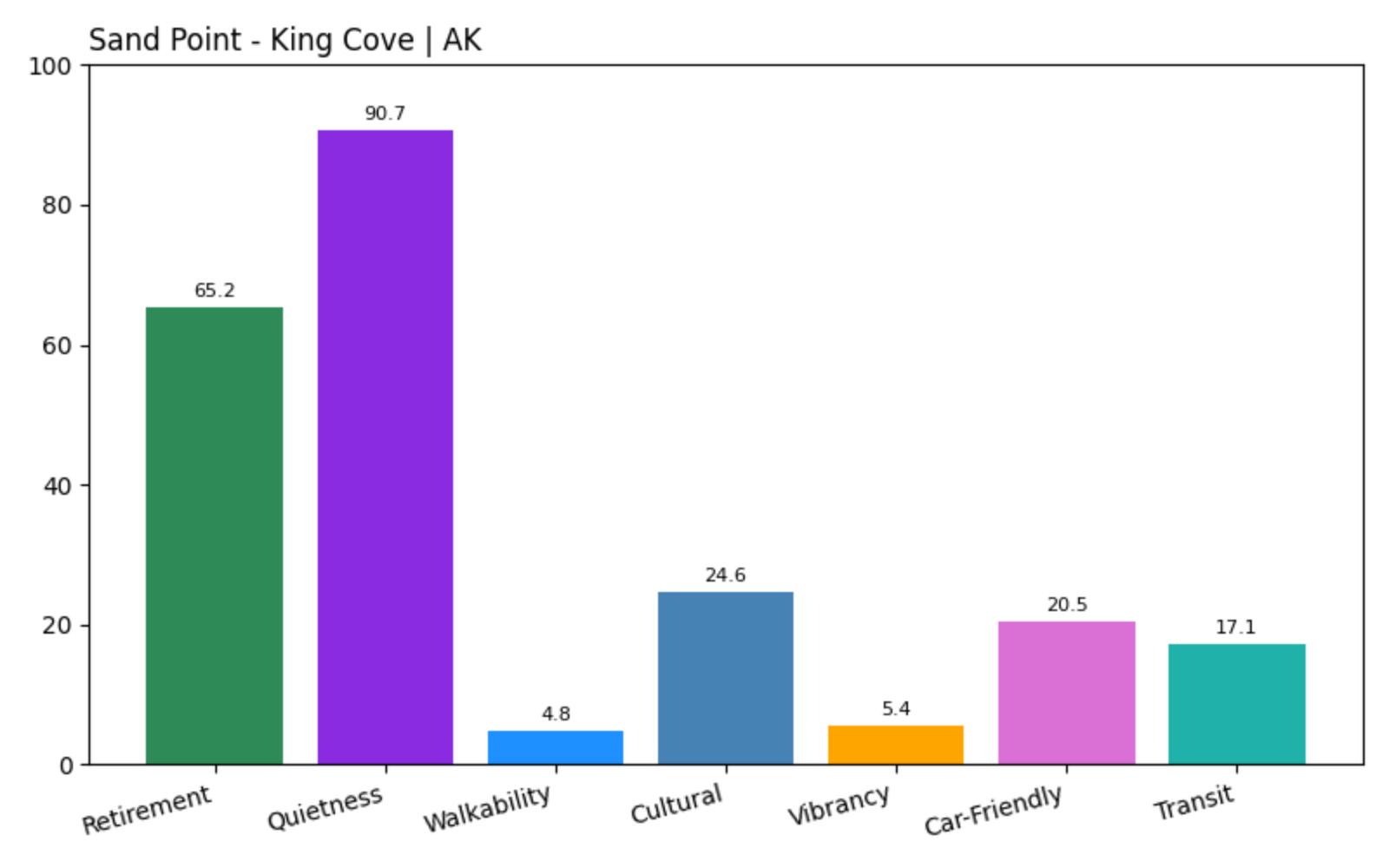
- Overall Retirement Score: 65.23
- Quietness: 90.73
- Walkability: 4.81
- Cultural amenities: 24.60
- Vibrancy: 5.42
- Car‑Friendliness: 20.50
- Transit‑Friendliness: 17.09
Sand Point’s ORS of 65.23 shows its strong quiet and fair transit by shuttle or boat. With low walkability, you’ll depend on local transport or a vehicle—but the reward is genuine Aleutian‑island living and close‑knit community ties.
30. Delta Junction — Where the Highway Ends and the Wilderness Begins

At the official endpoint of the Alaska Highway, Delta Junction feels like the edge of the world—wide open skies stretch above endless fields, and the Tanana River winds past with a steady, patient flow. Retirees here find a community bonded by its frontier spirit: neighbors gather at the Finley Community Center for potlucks, local fairs celebrate harvest season, and winter nights light up with northern‑lights displays. It’s a place where the highway’s hum gives way to bird song and snow‑covered silence.
Homes in Delta Junction list at about $357,000 as of June 2025, offering modest ranchers and cozy cabins on sprawling lots. A small museum shares the town’s WWII airfield history, and a handful of cafés serve up hearty stews when temperatures dip below zero. Medical basics are covered locally, but specialists are a two‑hour drive away in Fairbanks—ideal if you relish the trade‑off of remoteness for wide‑open living.
Delta Junction — ORS 69.12
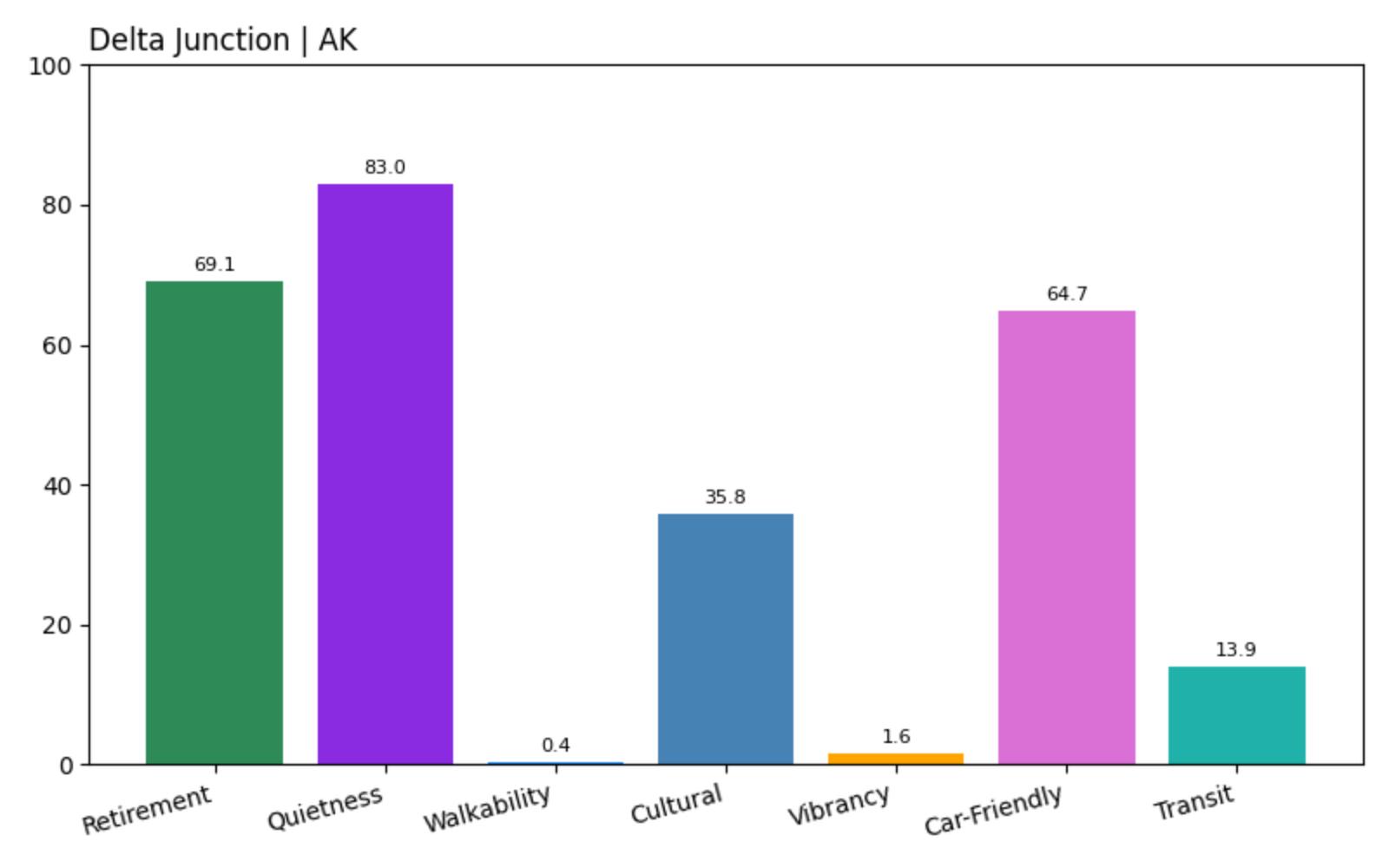
- Overall Retirement Score: 69.12
- Quietness: 82.95
- Walkability: 0.38
- Cultural amenities: 35.81
- Vibrancy: 1.62
- Car‑Friendliness: 64.73
- Transit‑Friendliness: 13.89
An ORS of 69.12 shows Delta Junction’s strength in peace and self‑reliance, balanced by minimal transit and very low walkability. Retirees here trade sidewalks for scenic drives and quiet nights, finding community in shared outdoor pursuits and small‑town gatherings.
29. Dillingham — Salmon Runs and Tidal Flats
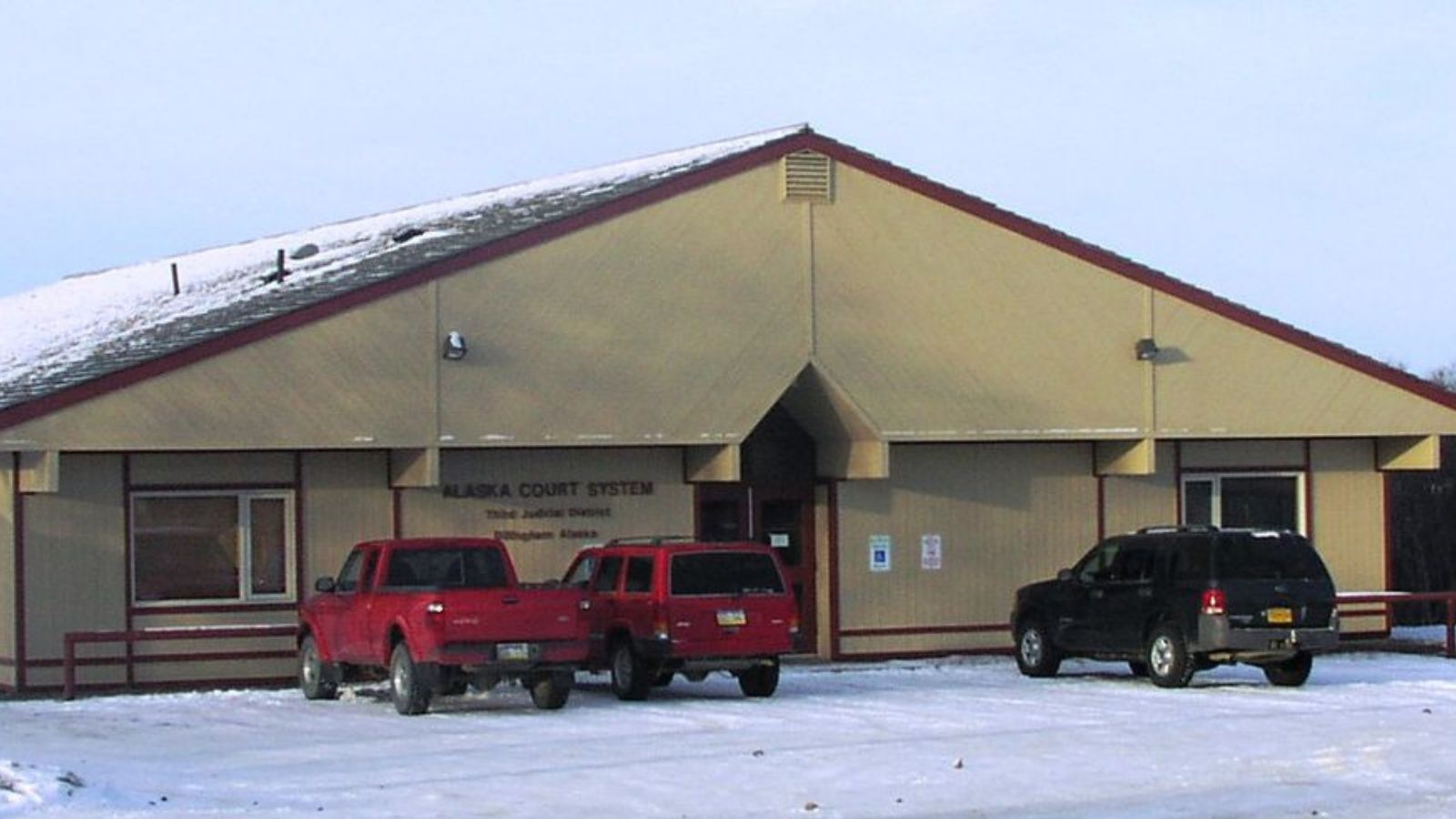
On the shores of Nushagak Bay, Dillingham pulsates with the rhythms of Bristol Bay’s legendary fishery. Retirees can join early‑morning salmon derbies, scan tidal flats for shorebirds, or swap stories in the cozy co‑op store over cups of strong coffee. The call of seabirds and the sight of cranes in flight set the soundtrack for daily life here.
With median home prices near $65,000 in June 2025, Dillingham offers one of Alaska’s most affordable retirements—though medical specialists still mean flights to Anchorage. A regional clinic, public library, and tribal culture center anchor the town, while freight planes deliver supplies that fuel the local economy. For those drawn to seabreezes and subsistence traditions, Dillingham feels like living at the edge of wilderness.
Dillingham — ORS 69.62
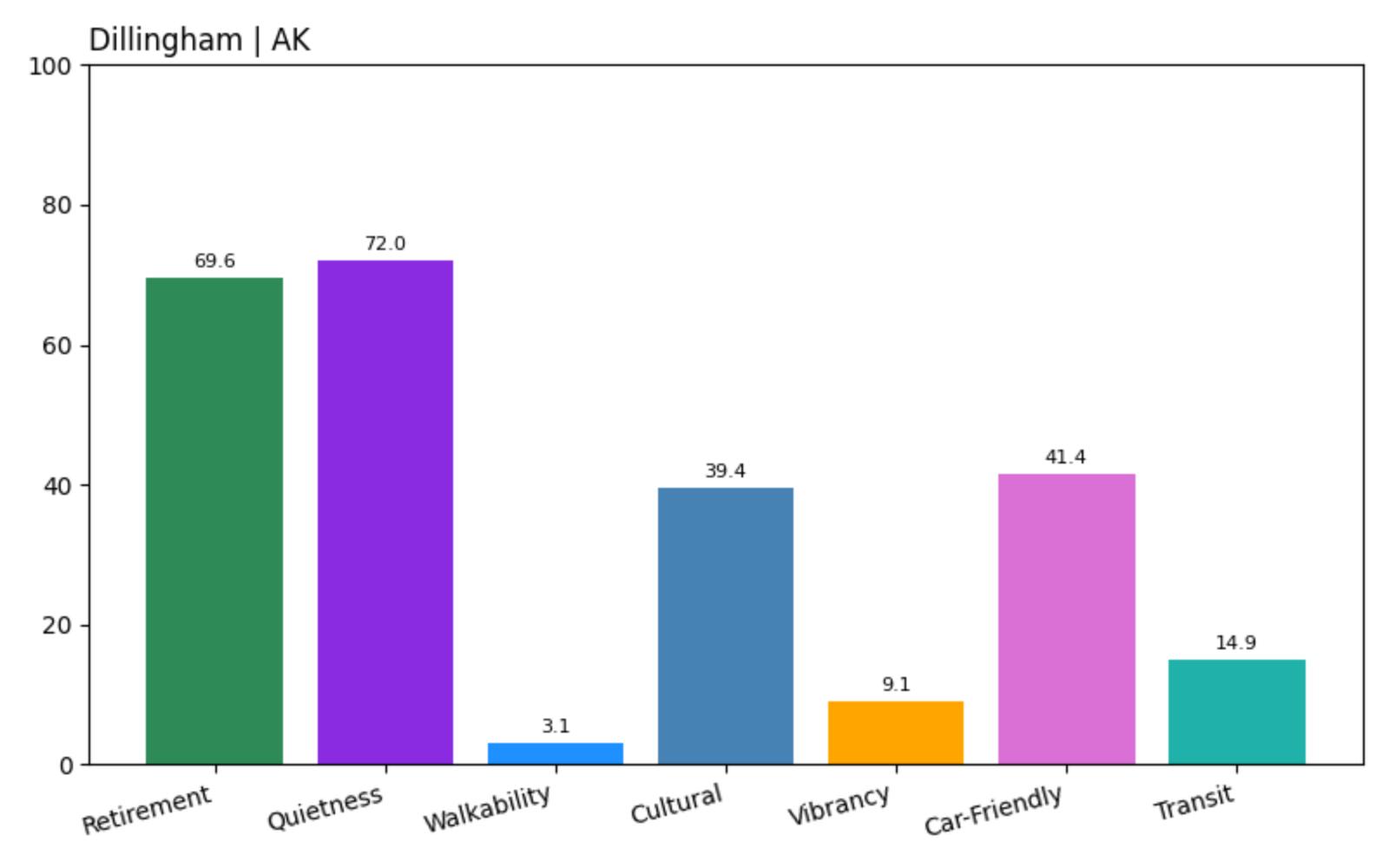
- Overall Retirement Score: 69.62
- Quietness: 72.04
- Walkability: 3.10
- Cultural amenities: 39.42
- Vibrancy: 9.05
- Car‑Friendliness: 41.40
- Transit‑Friendliness: 14.93
With an ORS of 69.62, Dillingham’s appeal lies in its seafood heritage and remote serenity, balanced by basic transit shuttles and low walkability. Retirees trade city comforts for community spirit and bayfront tranquility.
28. Craig – Klawock — Forest Trails Meet Totem Traditions
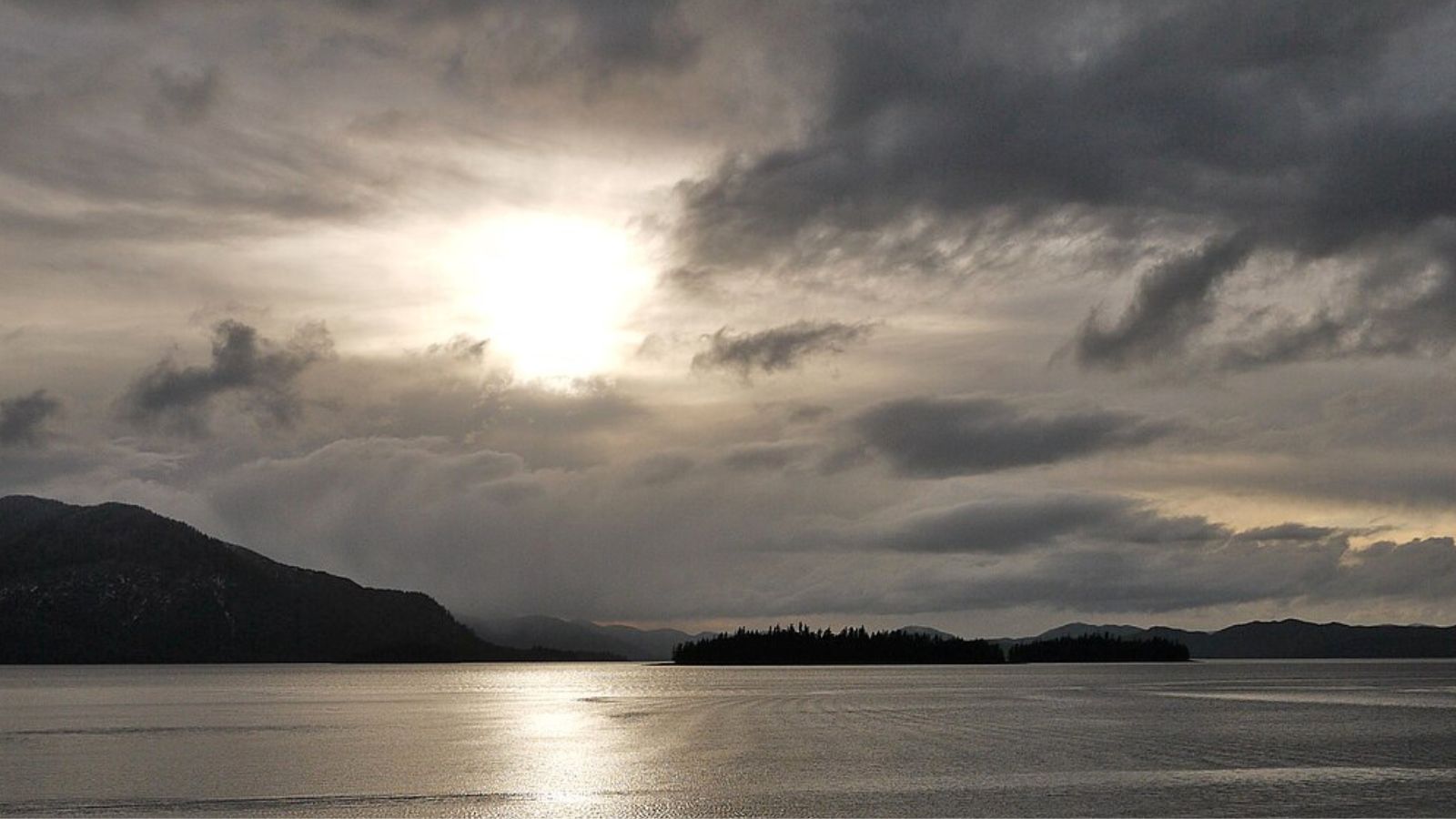
Joseph from Cabin On The Road, USA, CC BY-SA 2.0, via Wikimedia Commons
On Prince of Wales Island, Craig’s quiet gravel roads wind into Klawock’s totem‑pole‑lined streets, creating a twin‑town tapestry of fishing camps and native art. Retirees can hike moss‑covered forest trails by day, then gather around clan houses for storytelling and dance demonstrations at night. The scent of spruce and cedar drifts through the air, punctuated by the hum of fishing boats returning to harbor.
Median homes in Craig list near $299,000 as of June 2025, while Klawock’s historic wooden homes reflect centuries of Tlingit craftsmanship. A shared clinic, community center, and library serve daily needs, but ferry schedules and forest roads demand advance planning. For retirees who seek cultural immersion and woodland solitude, these twin communities blend tradition with tranquility.
Craig – Klawock — ORS 70.31
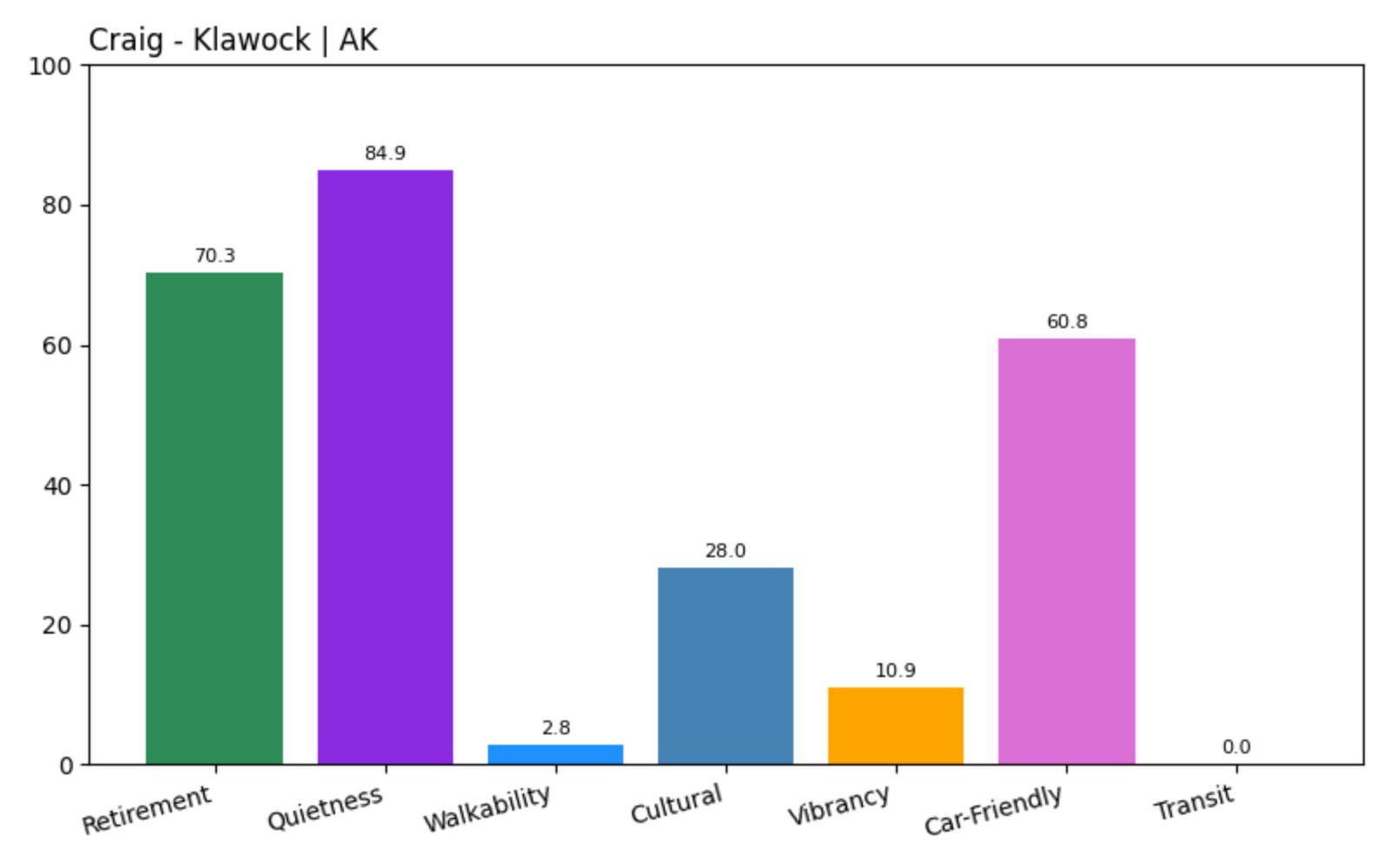
- Overall Retirement Score: 70.31
- Quietness: 84.86
- Walkability: 2.84
- Cultural amenities: 28.04
- Vibrancy: 10.91
- Car‑Friendliness: 60.84
- Transit‑Friendliness: 0.00
An ORS of 70.31 underscores Craig–Klawock’s quiet charm and strong car‑friendliness, tempered by low walkability and no formal transit. Retirees here embrace forested seclusion and cultural heritage over bustling streets.
27. Ketchikan — Totem Poles and Rainforest Showers

Under a canopy of Sitka spruce, Ketchikan drips with coastal rainforest, where totem poles rise beside rain‑slick boardwalks. Retirees can explore the Tongass Historical Museum one day and catch salmon‑tipped sunsets over Tongass Narrows the next. Even the rain feels like part of the rhythm, nourishing lush ferns and carving hidden waterfalls just off the main street.
With median listing prices near $422,000 in June 2025, Ketchikan offers services—hospitals, grocery stores, a community college—wrapped in a wet‑weather tapestry. A modest bus network and fair walkability downtown help residents get around, while daily ferry service links island communities. Retirees who love art, museums, and emerald‑green forests will find Ketchikan’s rain a small price for unmatched natural beauty.
Ketchikan — ORS 71.06
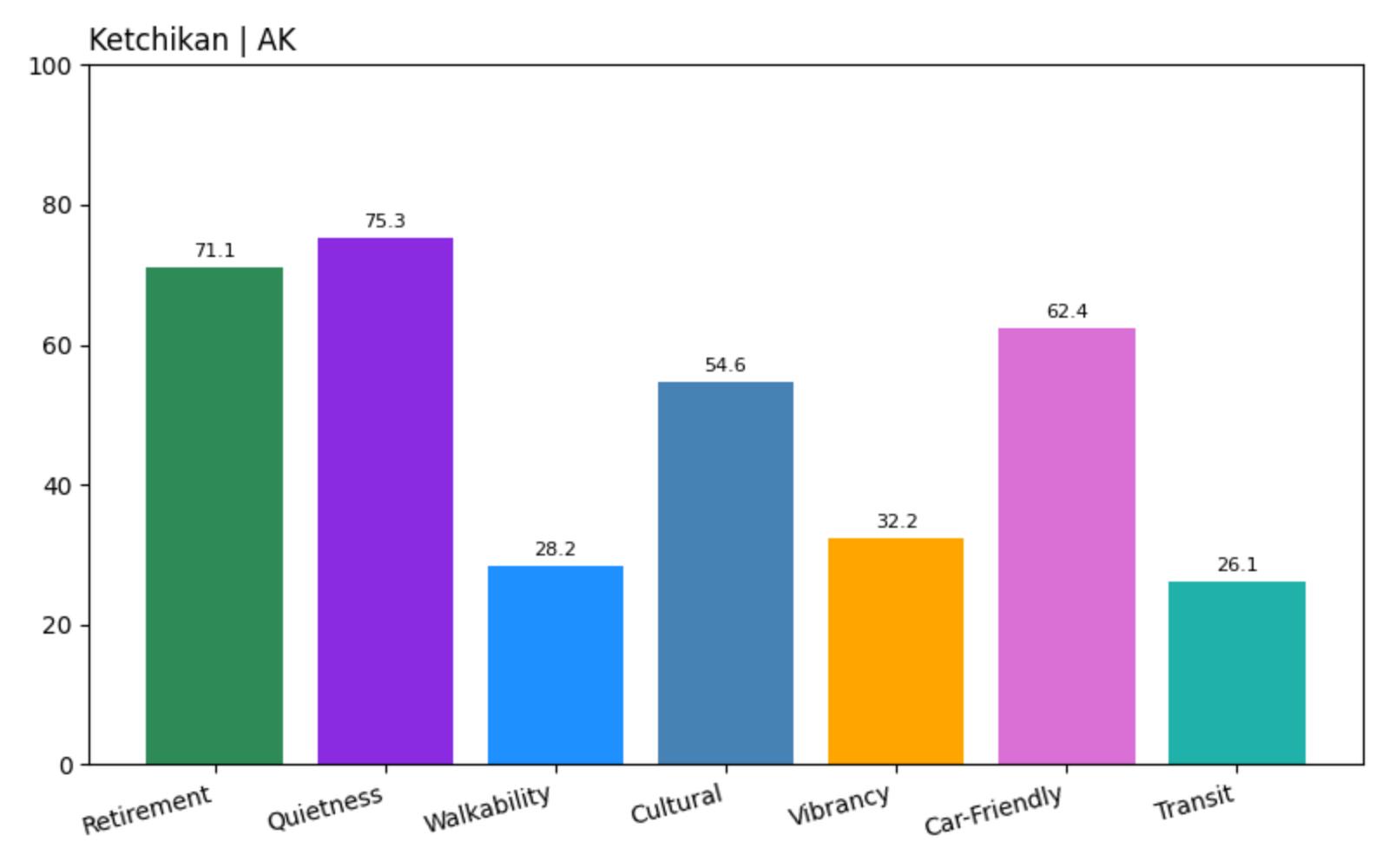
- Overall Retirement Score: 71.06
- Quietness: 75.33
- Walkability: 28.24
- Cultural amenities: 54.59
- Vibrancy: 32.24
- Car‑Friendliness: 62.38
- Transit‑Friendliness: 26.13
Ketchikan’s 71.06 ORS reflects its balance of cultural depth and rainforest calm, with decent downtown walkability and bus routes. Retirees here find hospitals, galleries, and ferry hops at their doorstep—if they don’t mind the rain.
26. Talkeetna — Flightseeing Hubs and Mountain Mornings

At the mouth of three rivers, Talkeetna greets retirees with jet‑driven planes streaking past Denali’s snowy peak at dawn. This railroad town turned adventure gateway hosts eclectic coffee shops, art studios, and flight decks where glacier tours lift off hourly. After a morning flightseeing run, you might browse local bakeries or join an impromptu music jam at the historic Fairview Inn.
Median homes list around $389,400 as of June 2025, blending railroad‑era cabins with modern chalet‑style retreats. A small clinic and community library cover basics, but car travel remains essential for larger stores in Wasilla. For retirees drawn to mountain vistas and aerial expeditions, Talkeetna offers the perfect mix of eccentric charm and Alaska’s grandest scenery.
Talkeetna — ORS 71.17
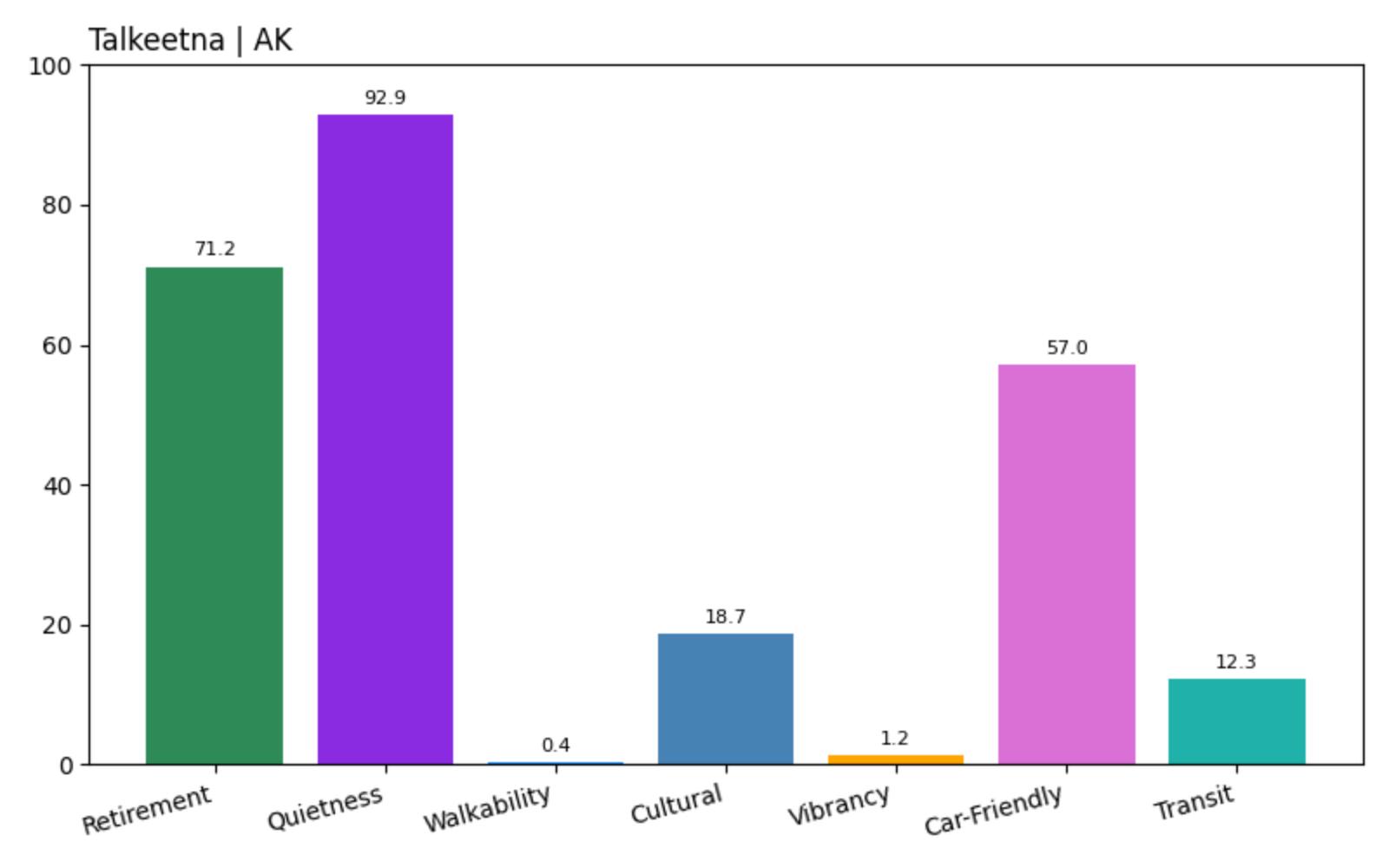
- Overall Retirement Score: 71.17
- Quietness: 92.93
- Walkability: 0.37
- Cultural amenities: 18.72
- Vibrancy: 1.23
- Car‑Friendliness: 57.03
- Transit‑Friendliness: 12.32
A 71.17 ORS highlights Talkeetna’s serene mornings and sky‑high adventures, balanced by tiny‑town walkability and limited transit. Retirees here mix frontier flair with mountain‑view comfort, trading sidewalks for ski trails and runway views.
25. Willow — Snow‑dusted Trails and Frontier Spirit

Willow feels like stepping into a postcard of winter wonder: endless snowmobile routes thread through spruce forests, and log‑cabin storefronts roast fresh coffee for early‑morning dog‑sled teams. In summer, the Iditarod’s ceremonial start brings local excitement, with craft fairs and live music spilling onto sunlit streets. Retirees here swap city hustle for ice‑lined rivers and community potlucks under midnight sun.
Homes hover around $375,000 as of June 2025, often set on generous lots with mountain views. A volunteer fire station and tiny health clinic cover essentials, while bigger stores and specialists await down the highway in Palmer. For those who crave snow‑packed silence and a tight‑knit group of neighbors, Willow delivers front‑row seats to Alaska’s seasonal show.
Willow — ORS 73.76
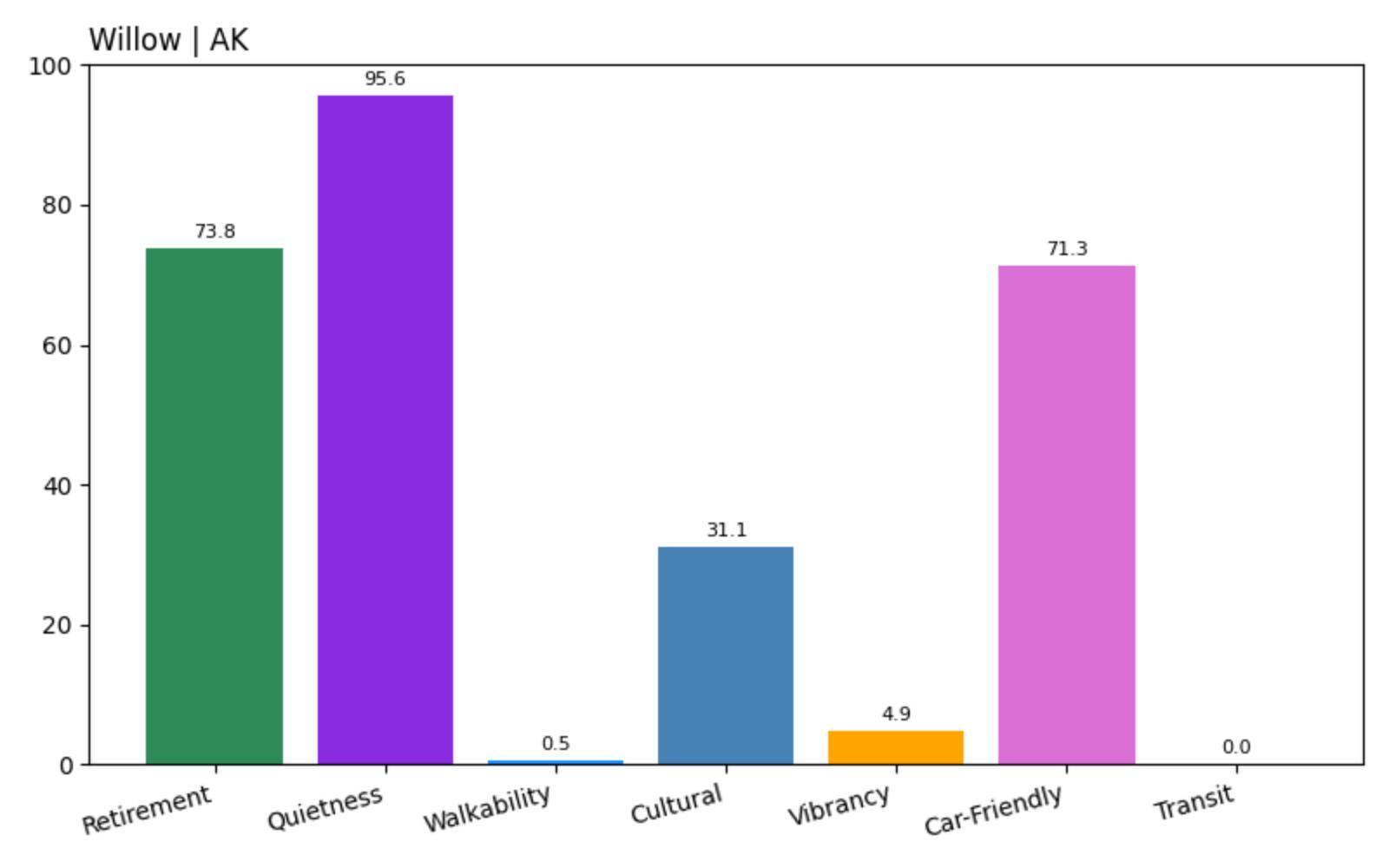
- Overall Retirement Score: 73.76
- Quietness: 95.59
- Walkability: 0.49
- Cultural amenities: 31.14
- Vibrancy: 4.88
- Car‑Friendliness: 71.31
- Transit‑Friendliness: 0.00
With an ORS of 73.76, Willow shines for peace but demands a car for groceries and doctor visits. Cultural life centers on outdoor festivals and sled‑dog events, so you won’t find many museums or theaters. If you’re aiming for crisp air, open skies, and a small‑town vibe, Willow checks every box.
24. Anchor Point — Coastal Breezes and Coffee Lore

Anchor Point earns its nickname “Northernmost Coffee Shop in the U.S.” with a lone café perched above tide‑pools that glint under Cook Inlet’s sweeping skies. Here, retirees wander rocky beaches hunting for driftwood, then share tales of salmon runs at the annual Beachcomber Days festival each August. Between seafood shacks and gift shops, the town holds fast to its fishing‑village roots.
Median home prices rest near $299,000 as of June 2025, many with views across to Mount Iliamna. A small health clinic and volunteer fire crew handle day‑to‑day needs; supermarkets and hospitals lie a scenic drive away in Homer or Kenai. For retirees drawn to ocean mists and occasional tourists, Anchor Point offers a laid‑back pace by the waves.
Anchor Point — ORS 77.18
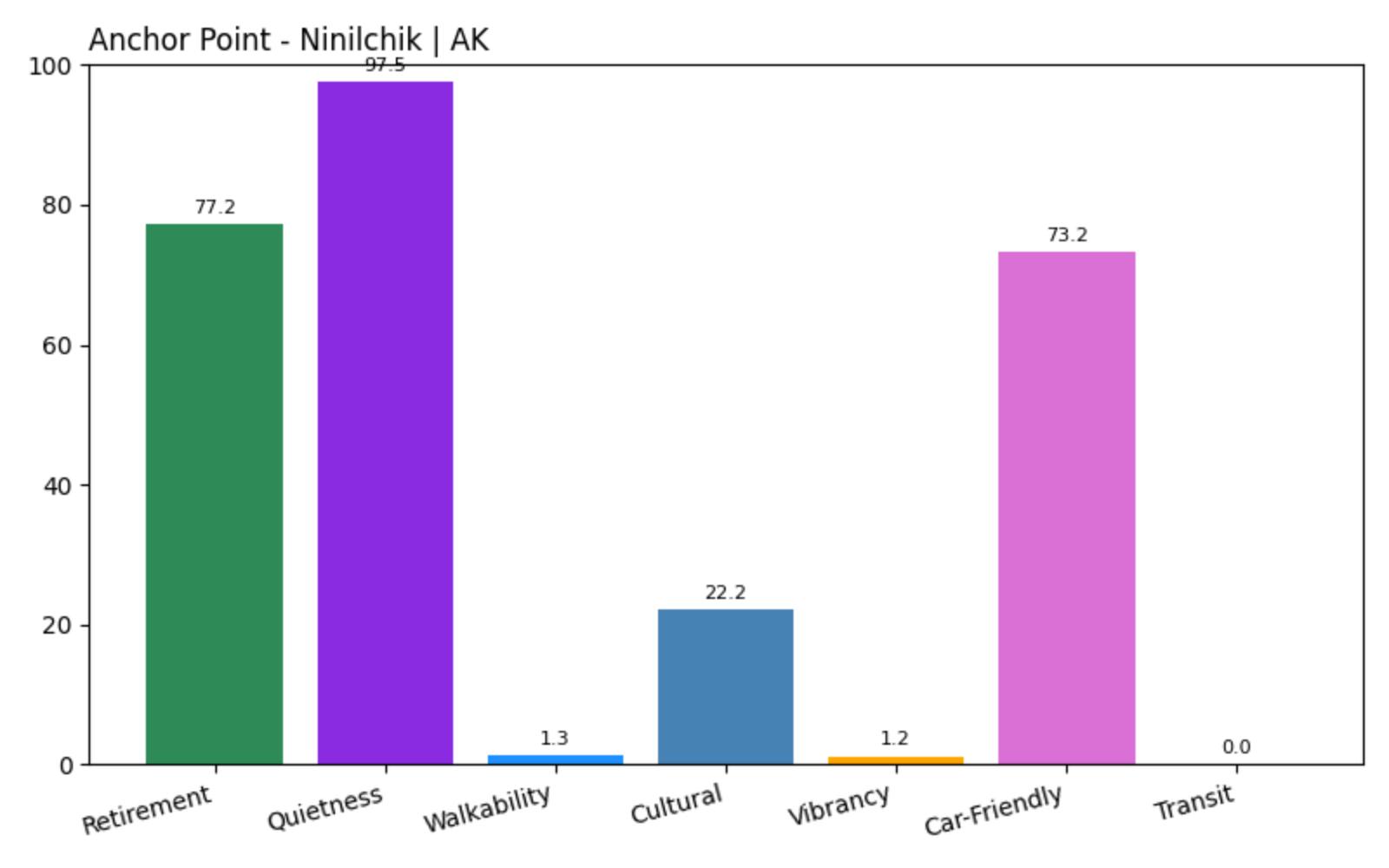
- Overall Retirement Score: 77.18
- Quietness: 97.48
- Walkability: 1.32
- Cultural amenities: 22.23
- Vibrancy: 1.18
- Car‑Friendliness: 73.24
- Transit‑Friendliness: 0.00
An ORS of 77.18 reflects Anchor Point’s top‑tier serenity and easy driving, balanced by almost no public transit or downtown walkways. Cultural spots are few, so most gatherings happen outdoors or at the café. Retirees who prize solitude and seaside sunrises will feel right at home.
23. Glennallen — Crossroads of Wild Beauty
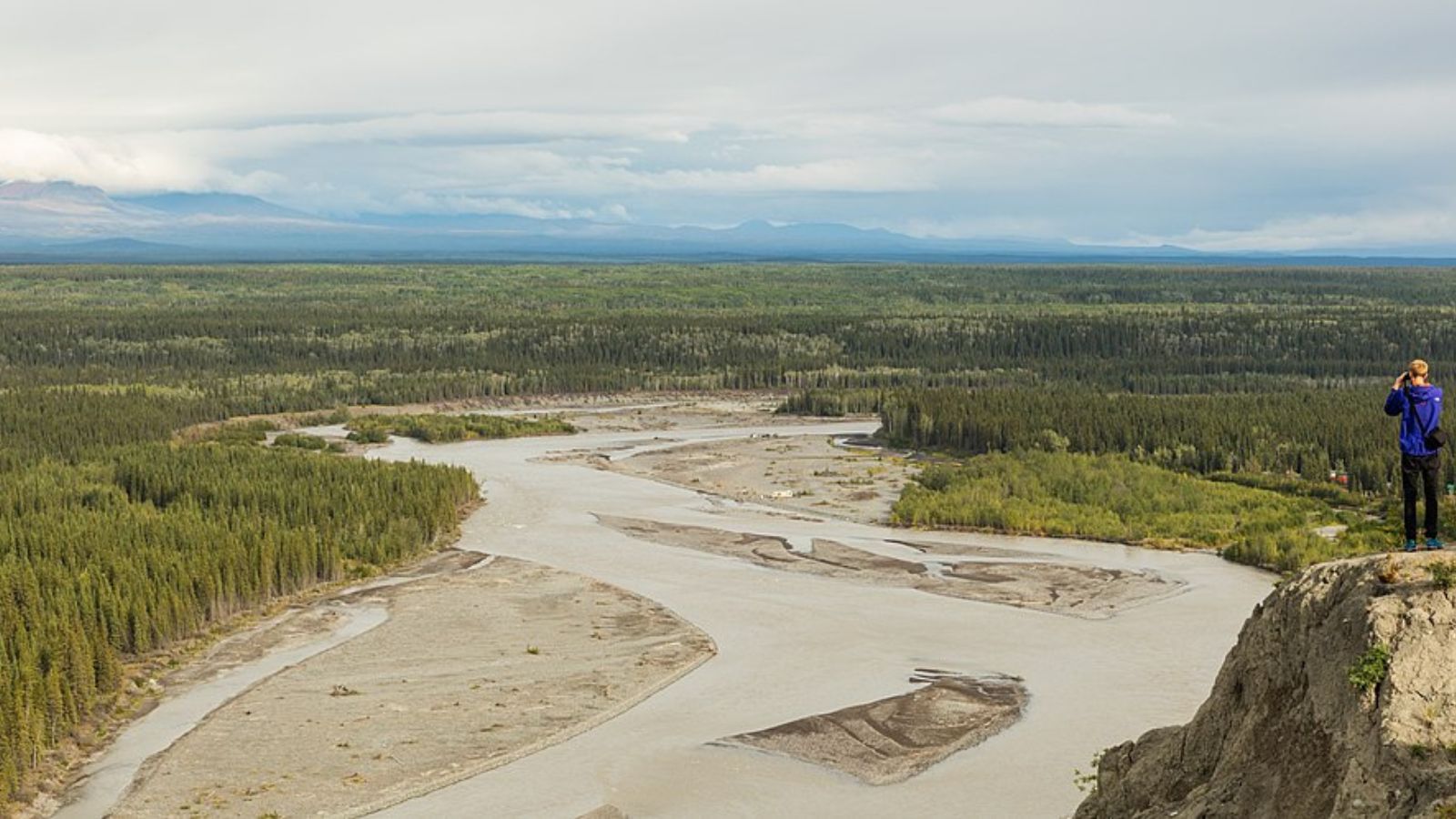
Perched where the Glenn and Richardson Highways meet, Glennallen feels like Alaska’s front door to Wrangell–St. Elias National Park. Retirees can catch ranger‑led glacier talks at a cozy visitor center, then grab a cup of coffee at the café overlooking rugged peaks. Each fall, the valley’s gold‑rush legacy shines through interpretive exhibits and local craft fairs.
Homes average $285,000 as of June 2025, with many set on sweeping acres of boreal forest. A small library, clinic, and community museum cover essentials, while Fairbanks’ bigger hospitals sit two hours away. For retirees drawn to mountain vistas and wildlife corridors, Glennallen offers untamed charm right off the highway.
Glennallen — ORS 77.32
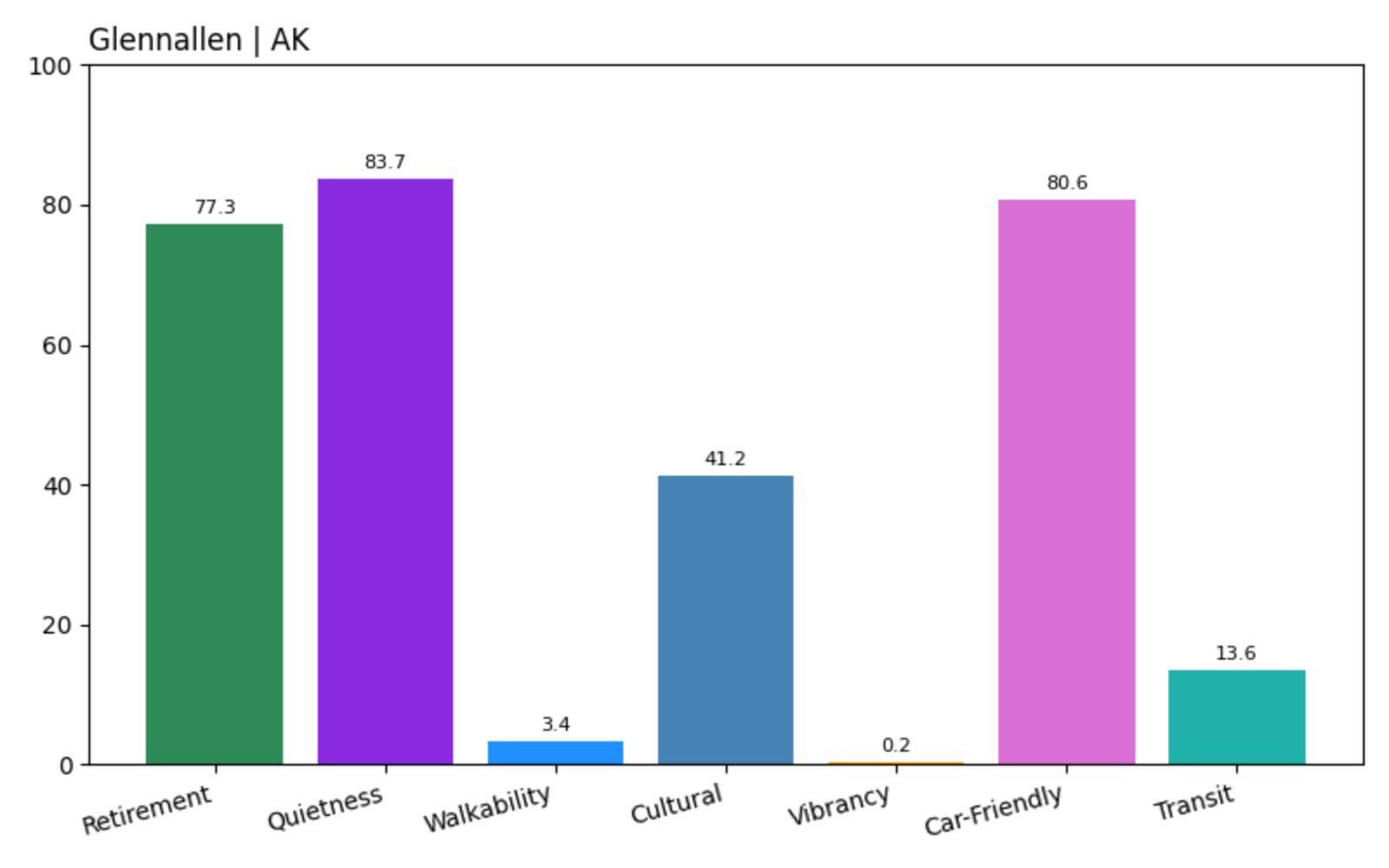
- Overall Retirement Score: 77.32
- Quietness: 83.73
- Walkability: 3.36
- Cultural amenities: 41.20
- Vibrancy: 0.24
- Car‑Friendliness: 80.64
- Transit‑Friendliness: 13.58
With an ORS of 77.32, Glennallen stands out for car‑friendly roads and moderate quiet, but limited transit and sidewalks. Cultural events center on park programs and local history, leaving nightlife almost nonexistent. Retirees who love rugged solitude with a dash of community history will find this junction town compelling.
22. Sutton — Forest Paths and Hidden Campfires

Hidden along the Parks Highway, Sutton is a tapestry of spruce forests and gravel lanes where retirees gather around campfires sharing homemade jams and berry recipes. Snowmobile and ATV trails fan out from town, inviting year‑round adventure. Even the general store doubles as a local hub, where neighbors swap trail reports and craft fair dates.
Median listings sit around $320,000 as of June 2025 on cleared lots amid tall trees. A tiny schoolhouse, volunteer fire department, and one café meet daily needs. For retirees who prefer woodland whispers over city sirens, Sutton offers a true back‑to‑nature lifestyle.
Sutton — ORS 78.30
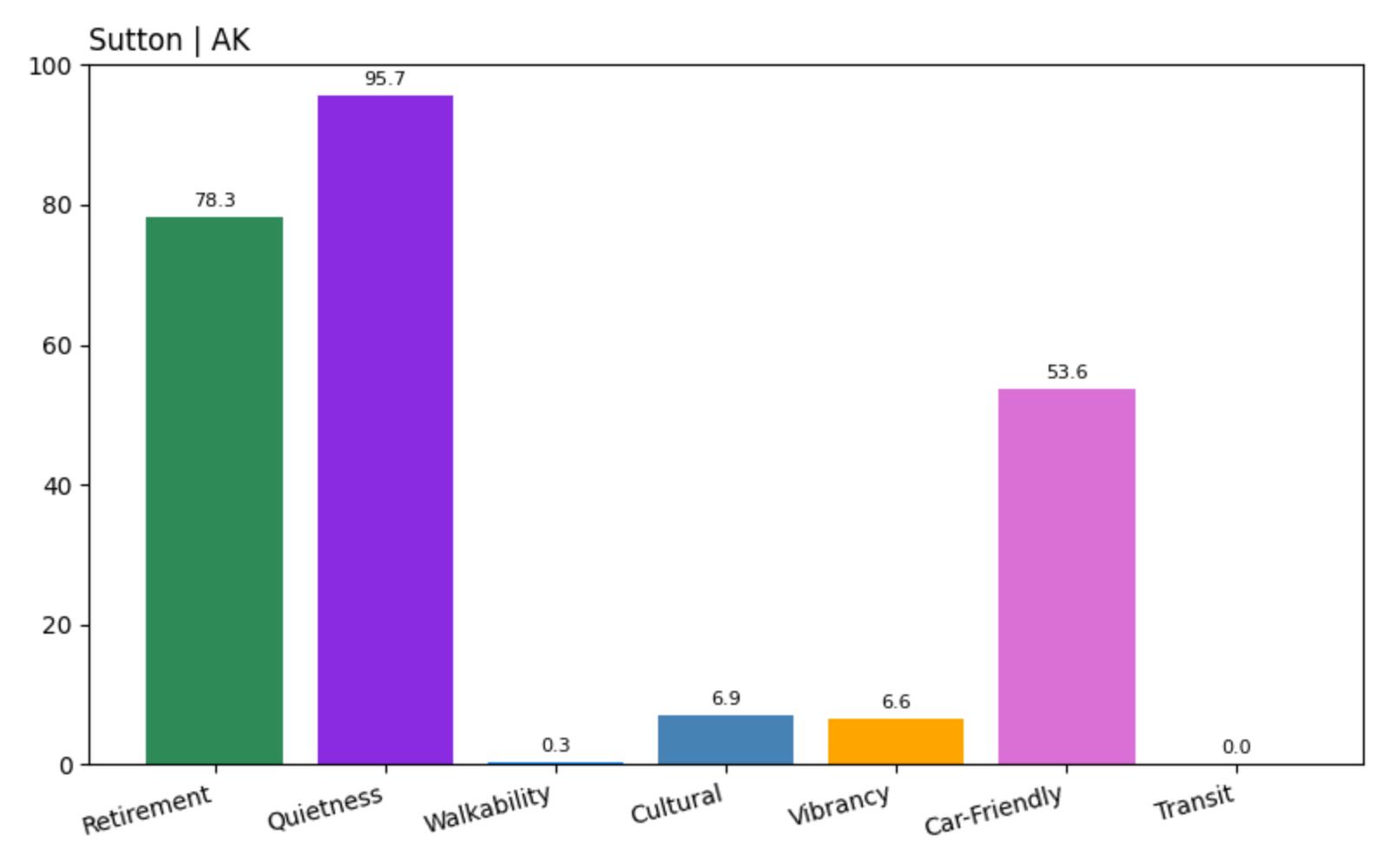
- Overall Retirement Score: 78.30
- Quietness: 95.68
- Walkability: 0.35
- Cultural amenities: 6.91
- Vibrancy: 6.60
- Car‑Friendliness: 53.58
- Transit‑Friendliness: 0.00
A 78.30 ORS underscores Sutton’s tranquil forests and reliance on personal vehicles. Cultural spots are rare, so expect potlucks and trail gatherings rather than concerts or galleries. For retirees ready to trade sidewalks for pine‑scented paths, Sutton delivers pure Alaskan atmosphere.
21. Trapper Creek — Mountains Beckon Beyond the River
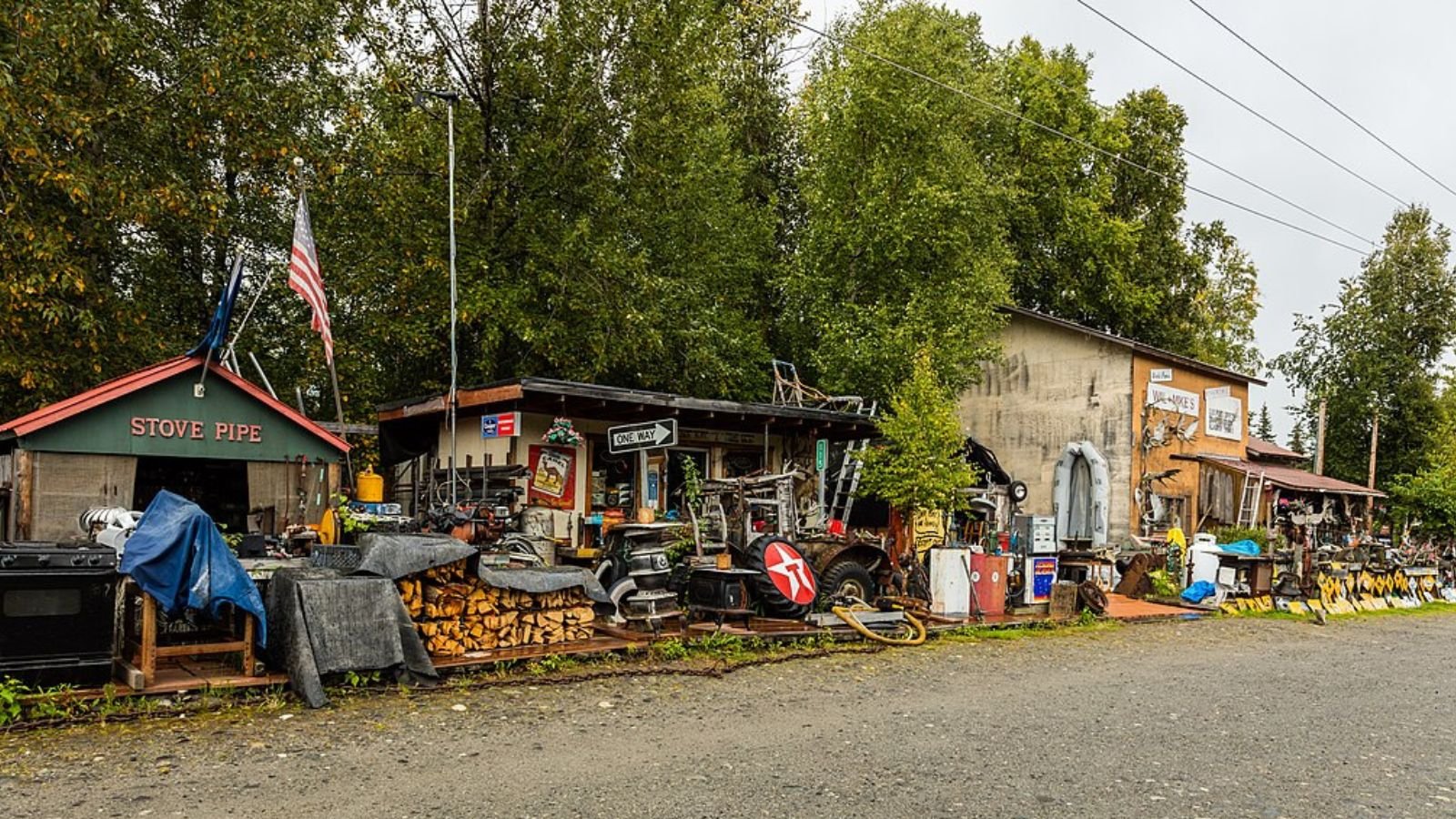
Trapper Creek is the gateway to Denali State Park, where retirees can launch river floats one morning and set out on glacier hikes the next. Its riverside inn, built from logs and stone, offers potluck dinners and park‑ranger storytelling under starlit skies. This tiny town pulses with outdoor possibility.
Homes list near $240,000 as of June 2025, mostly rustic cabins tucked into spruce groves. Services are basic—a post office, café, and small clinic—while Fairbanks lies two hours down the highway. For retirees drawn to mountain air and glacier‑tipped mornings, Trapper Creek feels like a front‑row seat to Alaska’s grandest show.
Trapper Creek — ORS 79.38
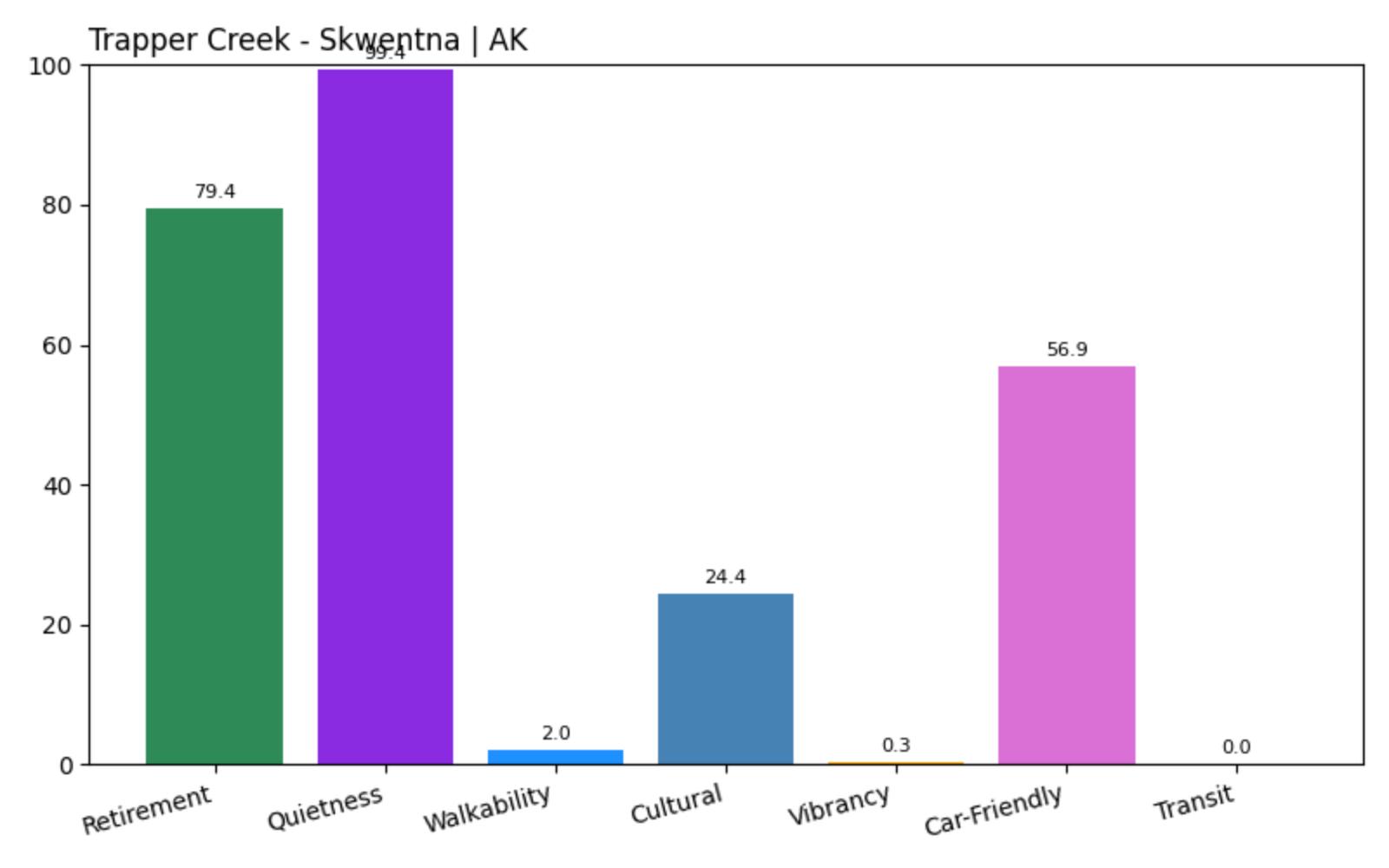
- Overall Retirement Score: 79.38
- Quietness: 99.40
- Walkability: 2.05
- Cultural amenities: 24.38
- Vibrancy: 0.32
- Car‑Friendliness: 56.86
- Transit‑Friendliness: 0.00
Trapper Creek’s ORS of 79.38 highlights unrivaled quiet and easy driving, with minimal transit or downtown strolls. Cultural life revolves around park programs and lodge gatherings. Retirees seeking solitude and glacier views will find every day here an adventure.
20. Nenana — Ice Cutters and Pioneer Spirit on the Tanana
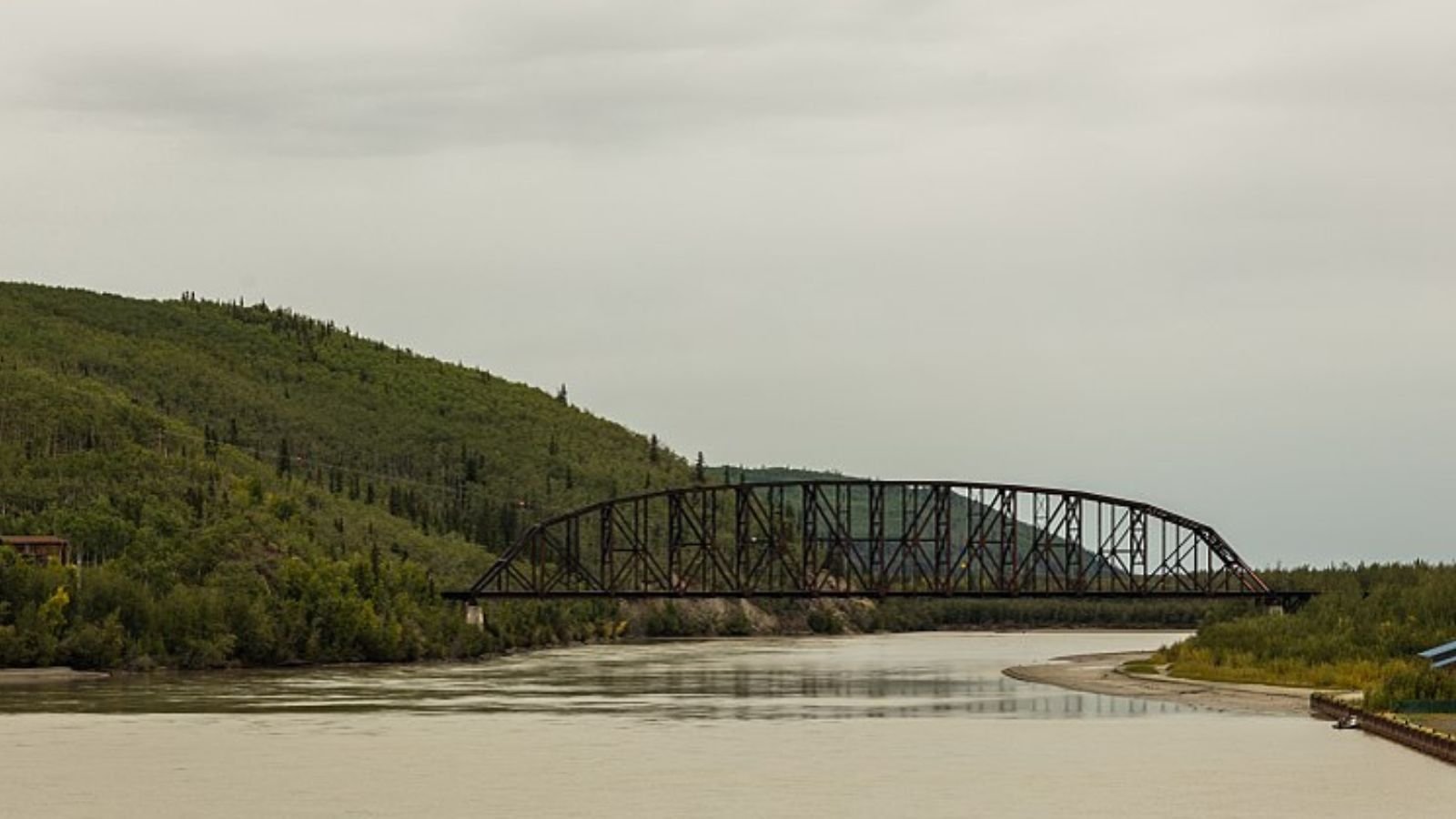
Long before modern highways, Nenana marked a crossing where wooden ice cutters carved through the frozen Tanana River each spring. Today, retirees gather on riverbank benches to watch tugboats push ice floes downstream and celebrate the Nenana Ice Classic’s lottery thrill. Seasonal festivals bring live music and craft booths to the community park, keeping pioneer traditions alive.
Homes in Nenana list for about $195,000 as of June 2025, with log cabins and historic houses tucked among birch groves. A small clinic and general store provide daily essentials, while a local museum recounts the gold-dredge era. With Fairbanks just a 90‑minute drive away, retirees balance pioneer solitude with city resources whenever they need them.
Nenana — ORS 79.70
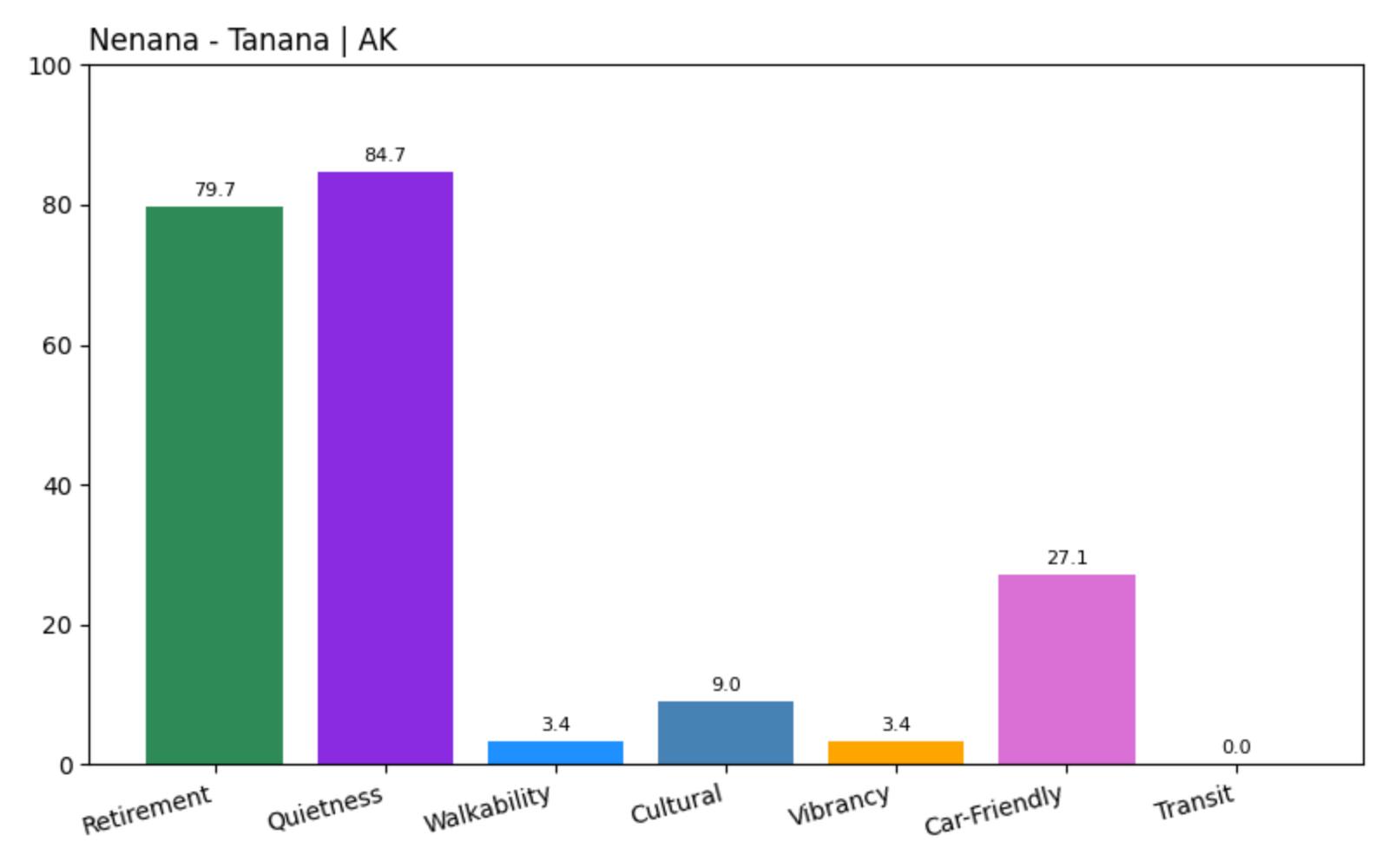
- Overall Retirement Score: 79.70
- Quietness: 84.72
- Walkability: 3.41
- Cultural amenities: 8.99
- Vibrancy: 3.37
- Car‑Friendliness: 27.14
- Transit‑Friendliness: 0.00
An ORS of 79.70 highlights Nenana’s peaceful riverside rhythms and tight‑knit community, balanced by limited sidewalks and no public transit. Errands call for a car, but the trade‑off is front-row seats to dramatic ice movements and hometown festivals that stir pioneer pride.
19. Naknek‑King Salmon — Where the Water Runs with Wealth
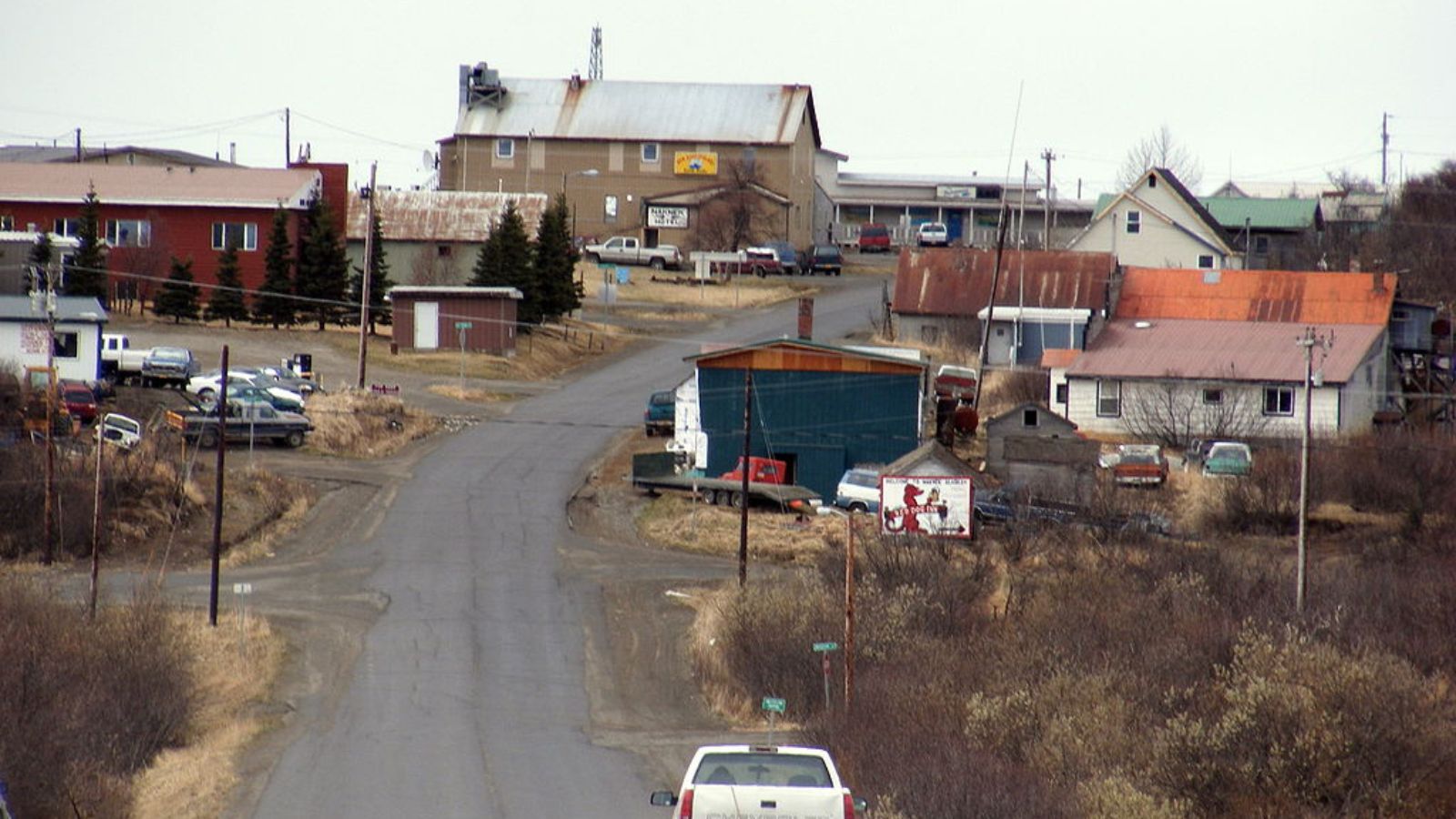
Arlo, Todd, Public domain, via Wikimedia Commons
When the tide sweeps in, Naknek and King Salmon transform into bustling hubs of fish processing, where retirees witness conveyor belts loaded with shimmering salmon or join dockside potlucks celebrating each season’s first catch. Tucked into Bristol Bay, these twin villages share a clinic, a co‑op market, and birdwatching trails that track migratory flocks overhead.
Median home listings near $120,000 as of June 2025 make Naknek‑King Salmon among Alaska’s most affordable retiree options. A small airstrip hums daily with supply planes, while local charters offer halibut excursions. For those who see adventure in every salmon run, this community delivers nature’s bounty next door.
Naknek‑King Salmon — ORS 79.85
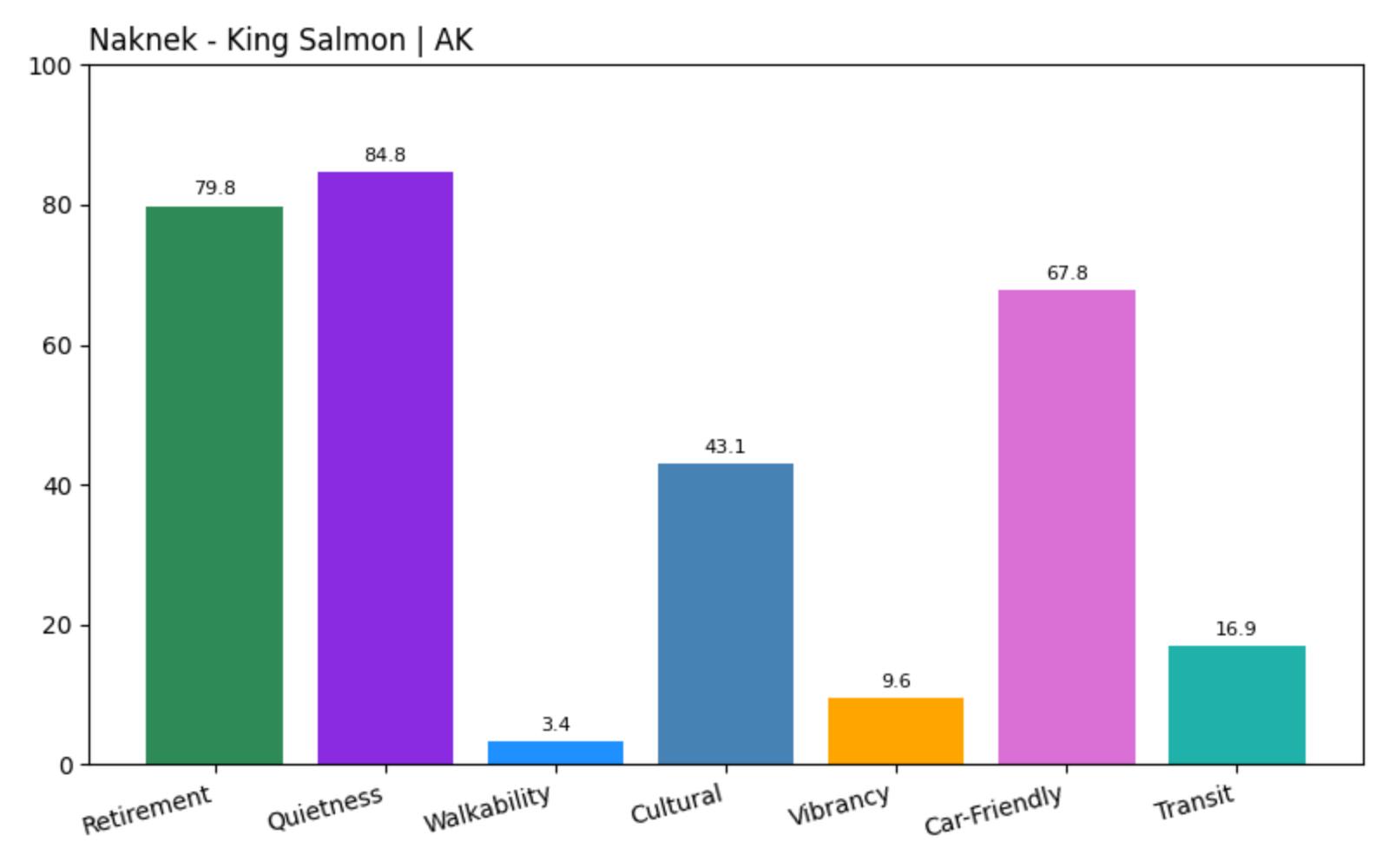
- Overall Retirement Score: 79.85
- Quietness: 84.78
- Walkability: 3.37
- Cultural amenities: 43.11
- Vibrancy: 9.59
- Car‑Friendliness: 67.81
- Transit‑Friendliness: 16.95
With an ORS of 79.85, Naknek‑King Salmon scores high on tranquility and cultural ties to fishing traditions, offset by minimal sidewalks and basic shuttle service. Retirees rely on cars for errands, but the payoff is daily festival‑worthy fish feasts and bayfront serenity.
18. Yakutat — Rainforest Mists and Glacier Whispers
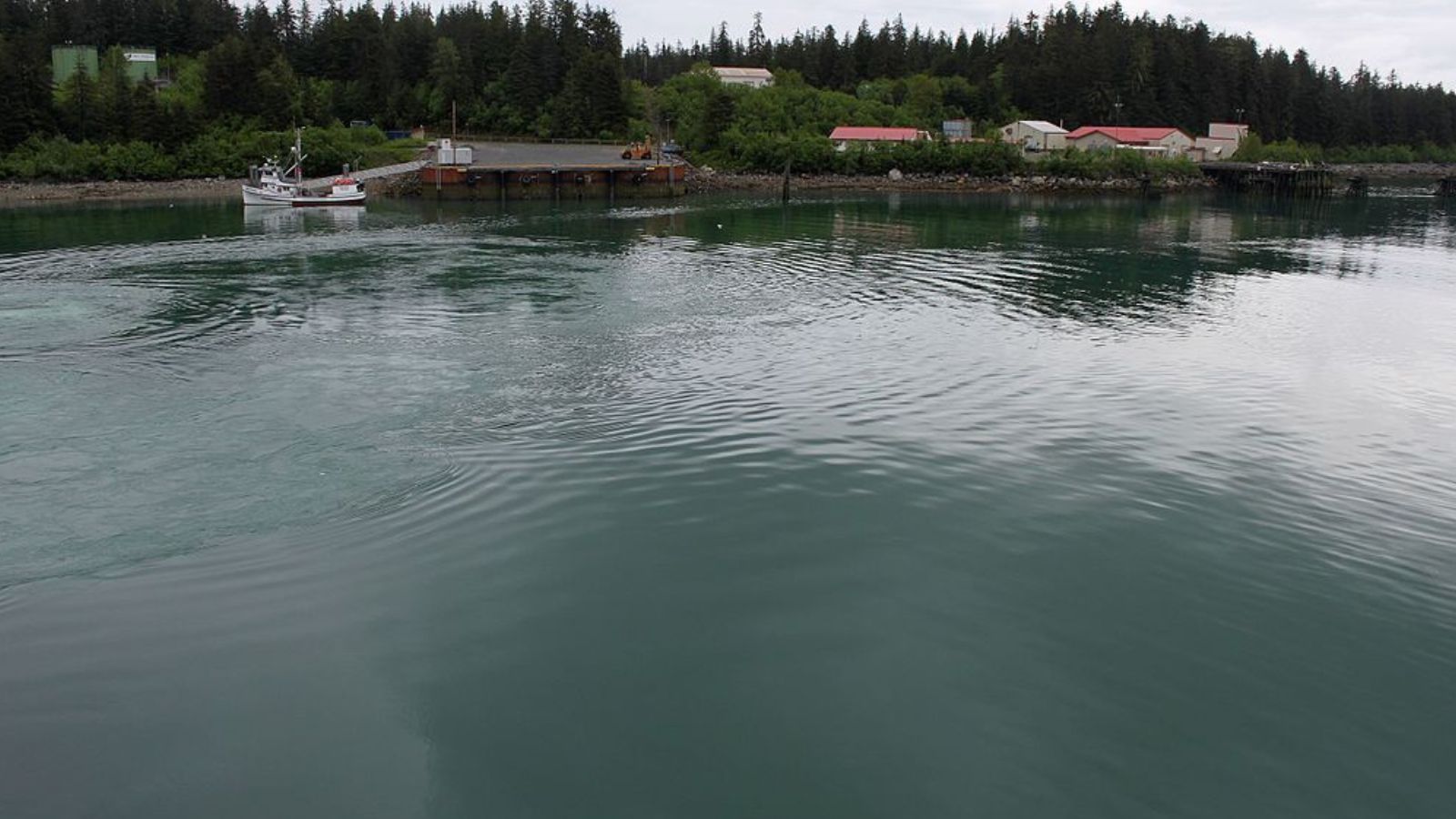
On the edge of a temperate rainforest, Yakutat dazzles retirees with dripping moss, thunderous waterfalls, and the distant rumble of Hubbard Glacier. Few places combine rainforest canopies with icy fjord views, making morning walks here feel like stepping into a living postcard. A local art collective hosts log‑carving workshops, and the café serves grilled halibut sandwiches overlooking the bay.
Median home prices near $280,000 as of June 2025 reflect Yakutat’s rare blend of scenery and seclusion. A small clinic, library, and coffee shop anchor the town, while floatplanes fly in supplies and visitors. For retirees who thrive on mist‑laden paths and glacier‑fueled horizons, Yakutat offers nature’s full chorus at your doorstep.
Yakutat — ORS 85.97
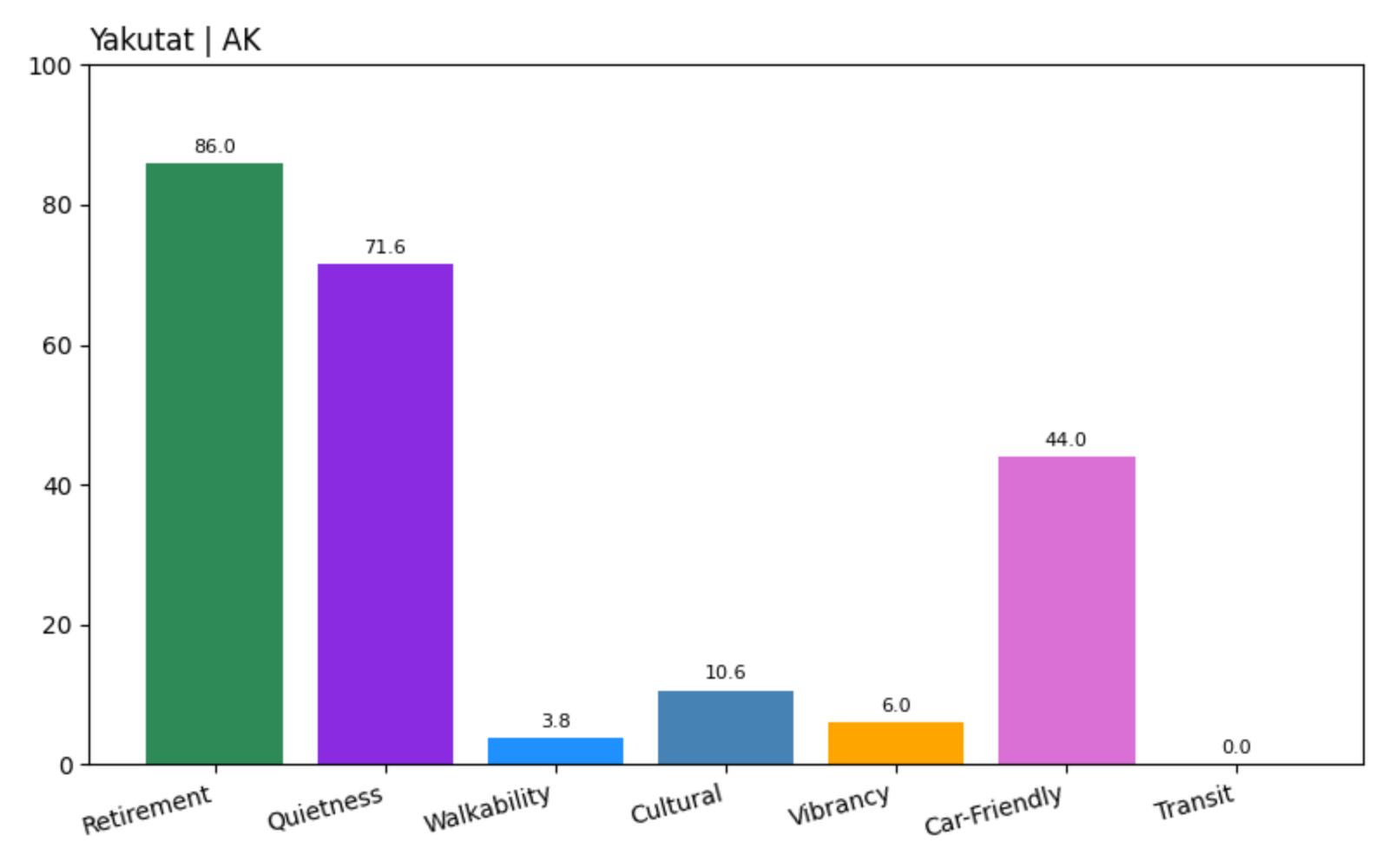
- Overall Retirement Score: 85.97
- Quietness: 71.64
- Walkability: 3.78
- Cultural amenities: 10.61
- Vibrancy: 6.02
- Car‑Friendliness: 44.03
- Transit‑Friendliness: 0.00
An ORS of 85.97 underlines Yakutat’s blend of natural drama and calm, balanced by limited roads and no public transit. Errands require a vehicle, but daily views of rainforest and glacier make every drive a pilgrimage into wild beauty.
17. Valdez‑Whittier — Tunnel Thrills and Fjordfront Living

Valdez’s harbor basks in summer sunshine, framed by snow‑patched mountains and pierced by the Anton Anderson Memorial Tunnel—North America’s longest highway tunnel. Retirees emerge into Whittier’s seaside enclave, where seafood markets hum and ferry decks beckon to glacier tours. The pipeline visitor center offers an engineering marvel by day and star‑lit fjord glimmers by night.
June 2025 median home prices near $350,000 match this region’s blend of access and adventure. A full hospital, maritime museum, and seasonal festivals support daily life, while avalanche seasons remind residents to plan ahead. For retirees seeking a touch of adrenaline with their sea breeze, Valdez‑Whittier delivers on both counts.
Valdez – Whittier — ORS 87.94
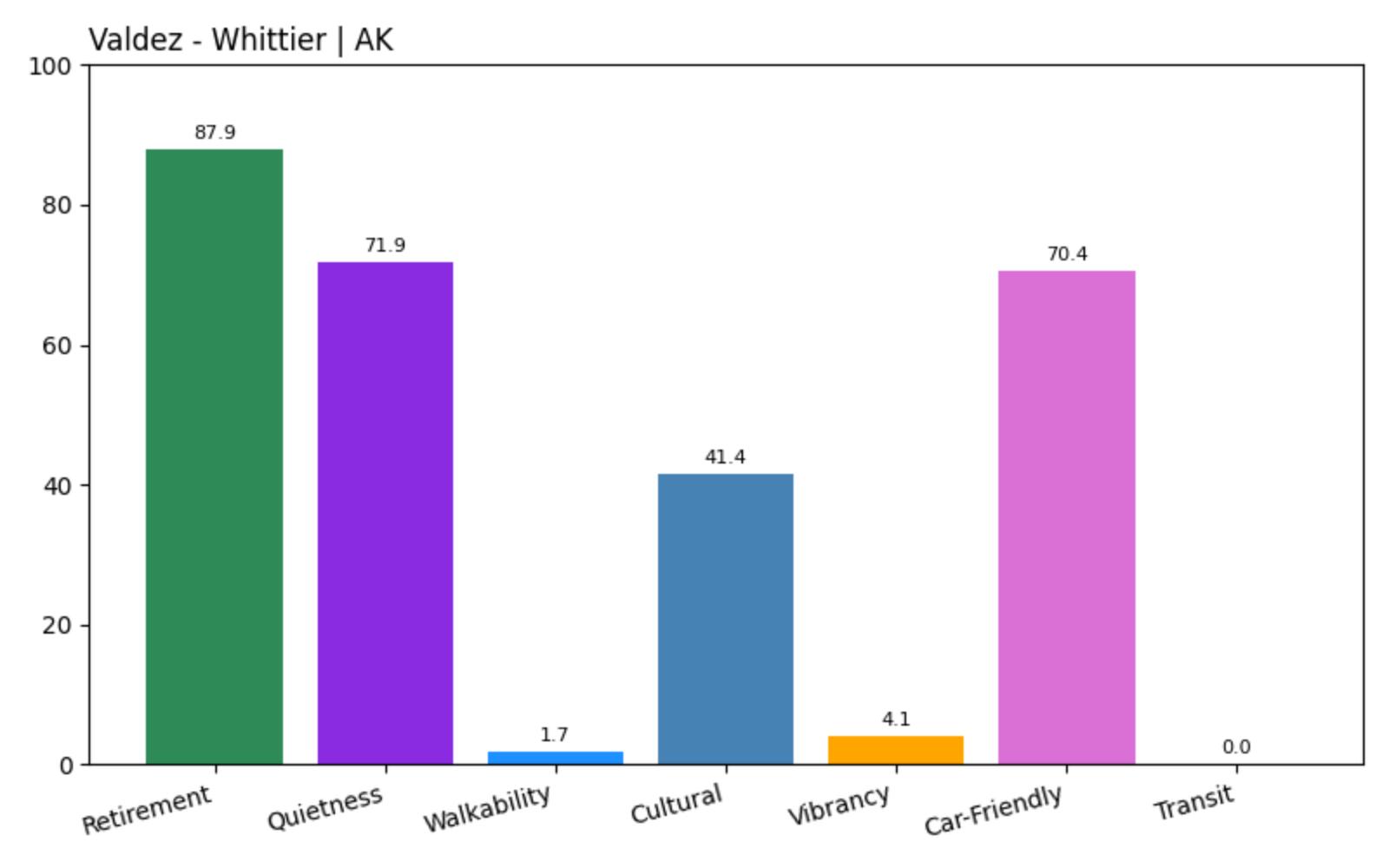
- Overall Retirement Score: 87.94
- Quietness: 71.86
- Walkability: 1.72
- Cultural amenities: 41.42
- Vibrancy: 4.13
- Car‑Friendliness: 70.43
- Transit‑Friendliness: 0.00
An ORS of 87.94 highlights Valdez‑Whittier’s balance of tunnel‑enabled connectivity and coastal calm, tempered by limited sidewalks and seasonal road closures. Retirees find hospitals and museums close at hand, with waterways doubling as their front yard.
16. Sitka — Totems and Tides on Baranof Island

Sitka’s totem poles stand sentinel against northern seas, each carved face narrating centuries of Tlingit and Russian history. Retirees sip lattes beneath Sitka spruce canopies, then wander boardwalks to the Sheldon Jackson Museum or join whale‑watching cruises at dawn. This island city weaves art, heritage, and salt air into everyday life.
Median listings around $450,000 as of June 2025 reflect Sitka’s mix of galleries, hospitals, and ferry connections. Chief Andrew Isaac Health Center and a community college branch lie within a few blocks of waterfront trails. For retirees who seek cultural depth paired with ocean breezes, Sitka offers an enriched island retirement.
Sitka — ORS 88.01
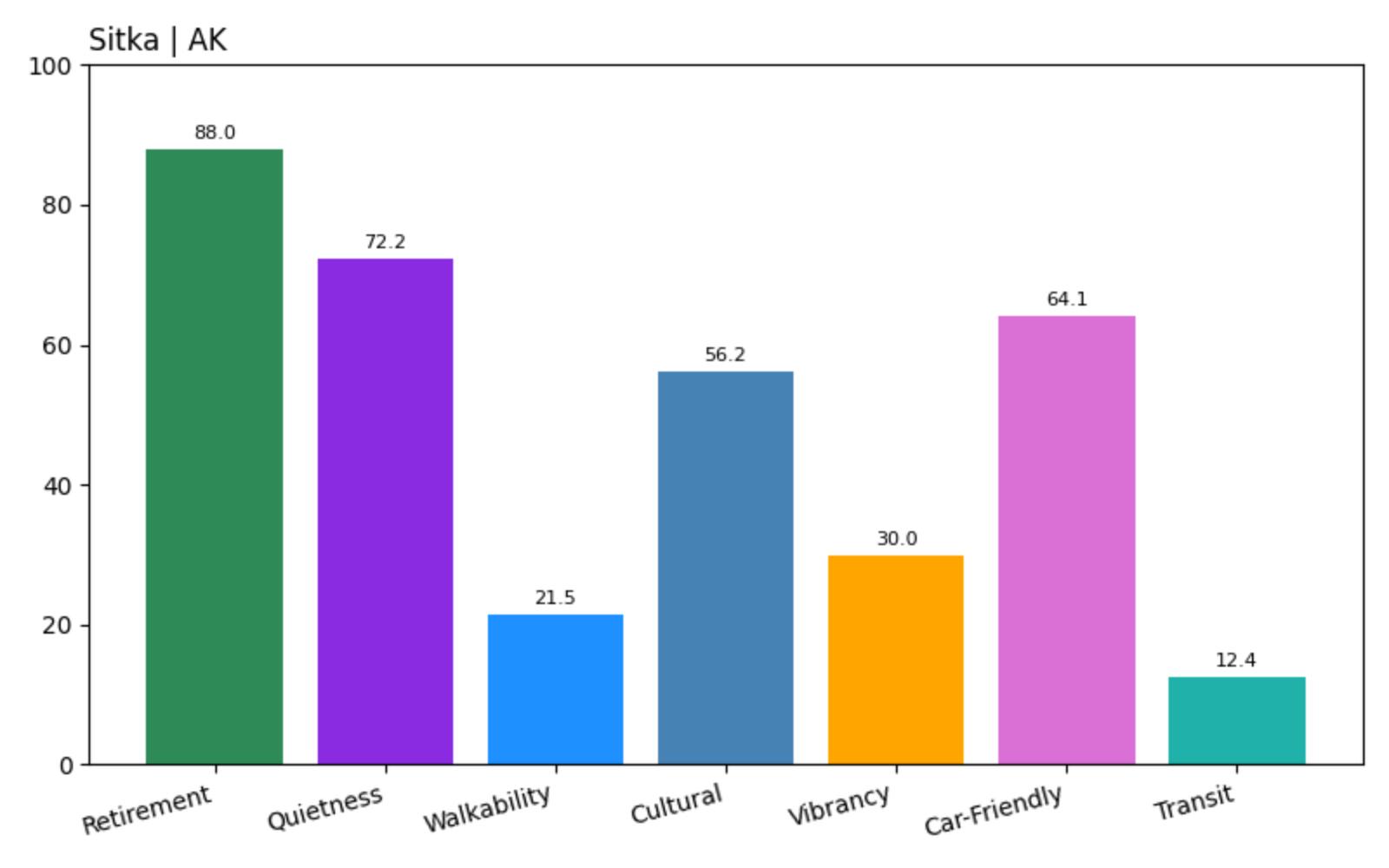
- Overall Retirement Score: 88.01
- Quietness: 72.23
- Walkability: 21.51
- Cultural amenities: 56.24
- Vibrancy: 29.96
- Car‑Friendliness: 64.12
- Transit‑Friendliness: 12.41
An ORS of 88.01 underscores Sitka’s vibrant arts and maritime tapestry, with solid walkability downtown and ferry lifelines. Retirees enjoy hospitals, galleries, and seafood shacks all within reach of salt‑sprayed promenades.
15. Ester — Rolling Hills and Creative Hearths
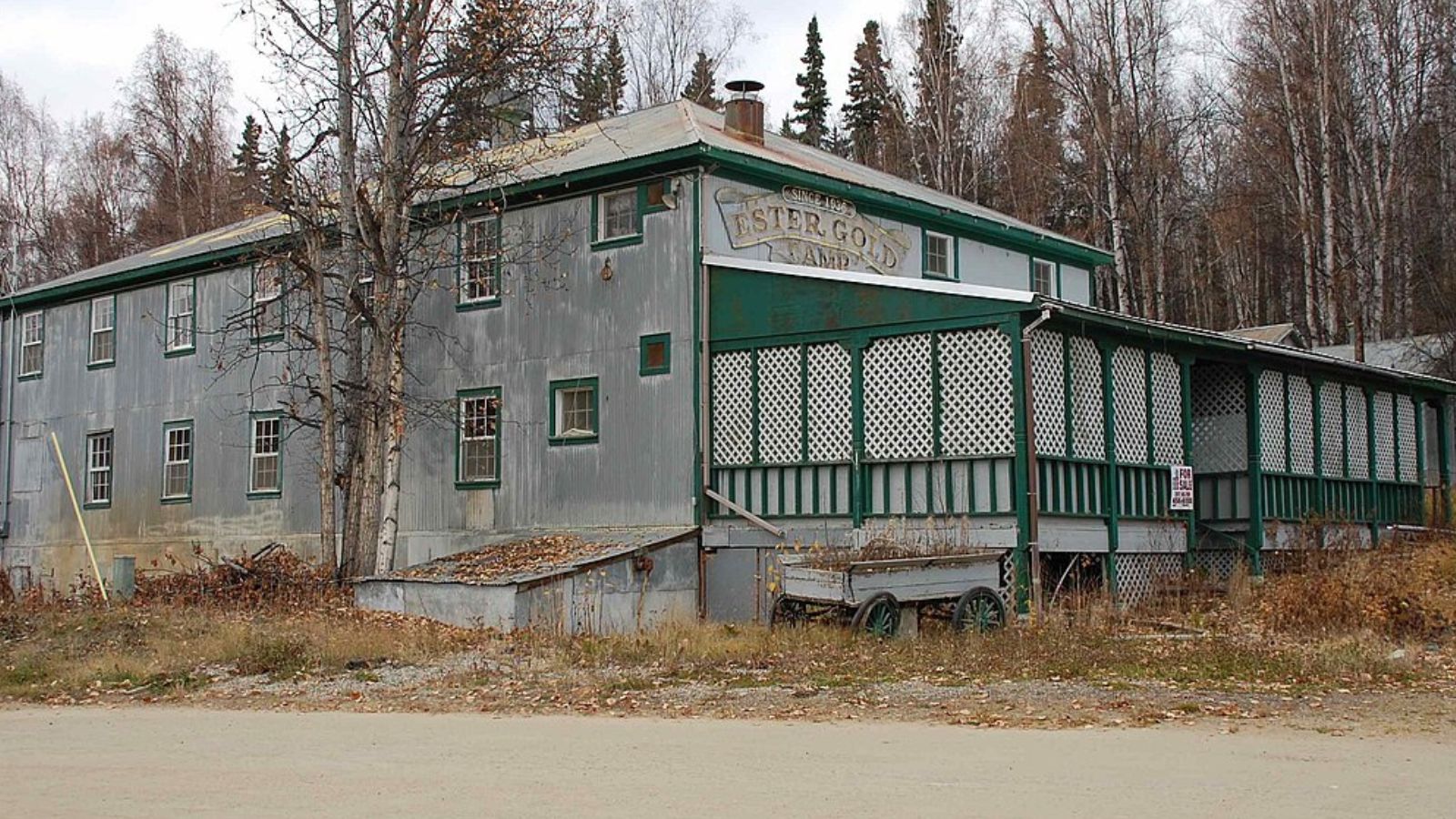
In Ester, the old gold‑mining cabins have sprouted into art studios, where retirees swap metal pans for paintbrushes under open‑air workshop tents. Mornings here might find you browsing handcrafted pottery at the weekly co‑op market or catching folk‑music sets in a converted bunkhouse. Summers sparkle with outdoor film screenings on grassy knolls, and winters glow around bonfires fed by local firewood crews.
Median homes list around $350,000 as of June 2025, many perched on gentle slopes overlooking Fairbanks’ distant glow. A volunteer fire station doubles as a community hub, and the tiny library hosts author talks in living‑room style. With no formal bus lines, residents count on friendly ride‑shares and shared snow‑plows—but no one minds when evening potlucks fill the air with homemade pies.
Ester — ORS 88.47
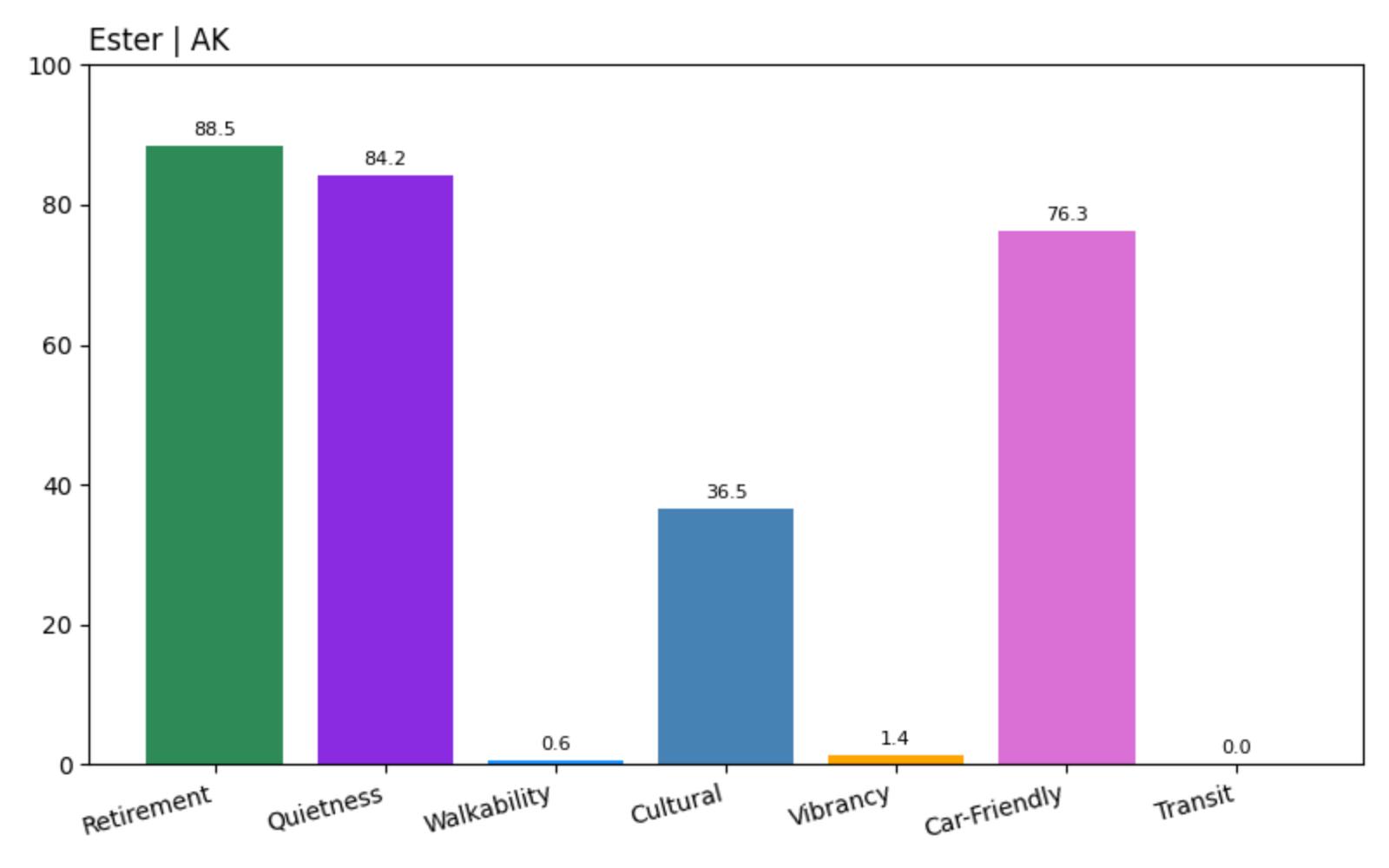
- Overall Retirement Score: 88.47
- Quietness: 84.17
- Walkability: 0.61
- Cultural amenities: 36.53
- Vibrancy: 1.38
- Car‑Friendliness: 76.29
- Transit‑Friendliness: 0.00
Ester’s ORS of 88.47 shows its creative spark and calm roads, balanced by the need for a car and scarce transit. Cultural life here is vivid but small‑scale—perfect if you value workshops and gallery openings over city museums.
14. Sterling — Riverbank Cabins and Aurora Nights

Sterling sprawls alongside the Kenai River, where retired anglers sip coffee in log‑cabin cafés as salmon leap past dawn’s pink haze. Summer days blur into berry‑picking outings and guided wildlife tours, while winter nights draw viewers to frozen riverbanks under dancing auroras. Outdoor adventure feels woven into the town’s very timber frames.
June 2025 listings average about $375,000, many featuring riverside decks and spacious fire‑pit yards. A single grocery store and volunteer firehouse handle essentials, and a local art fair paints the town hall with quilts and woodcarvings each August. Without buses or sidewalks, residents lean into car‑pool carpools and snow‑machine convoys when snowstorms roll in.
Sterling — ORS 88.58
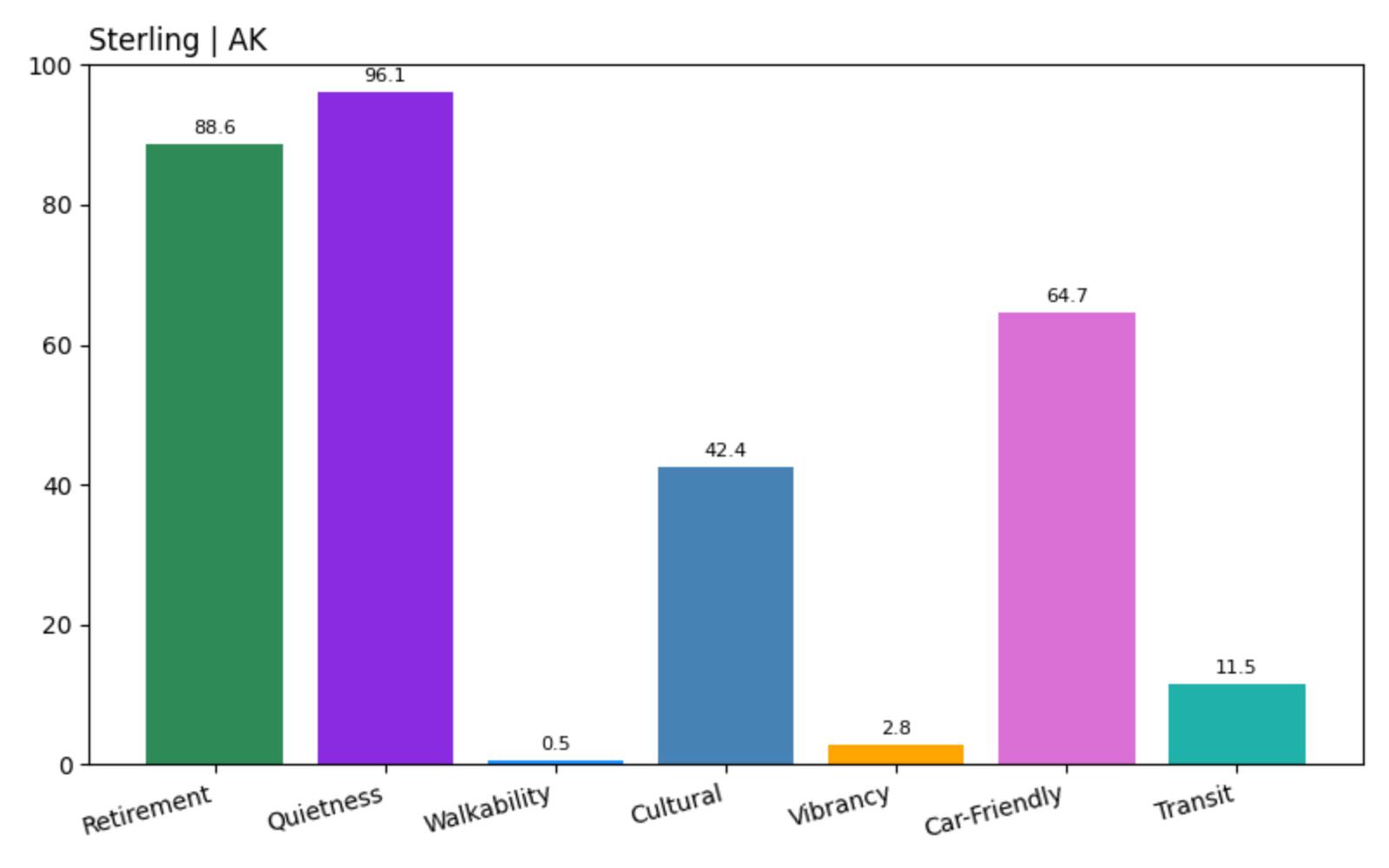
- Overall Retirement Score: 88.58
- Quietness: 96.13
- Walkability: 0.51
- Cultural amenities: 42.41
- Vibrancy: 2.77
- Car‑Friendliness: 64.67
- Transit‑Friendliness: 11.52
With an ORS of 88.58, Sterling excels in tranquility and scenic drives, but you’ll need a vehicle for every errand. Its cultural flair blooms at seasonal festivals—ideal if you love river‑focused gatherings rather than everyday bustle.
13. Salcha — Riverside Hideaway under Northern Skies

Salcha feels like a well‑kept secret on the Tanana River, where retirees wander bird‑filled sloughs at dawn and listen to quiet river currents long into starlit nights. The annual Pioneer Picnic turns the town park into a sea of straw hats and homemade pies, while heritage talks at the local hall recall Tlingit legends and homestead tales. Solitude reigns between these cherished gatherings.
Median homes sell near $315,000 as of June 2025, most surrounded by spruce groves and rustic trails. A volunteer fire unit and tiny general store keep essentials close, and Fairbanks’ specialists are a scenic drive away. With no public transit, Salcha’s rhythms are set by seasonal river flows and community potlucks beneath the Big Dipper.
Salcha — ORS 89.33
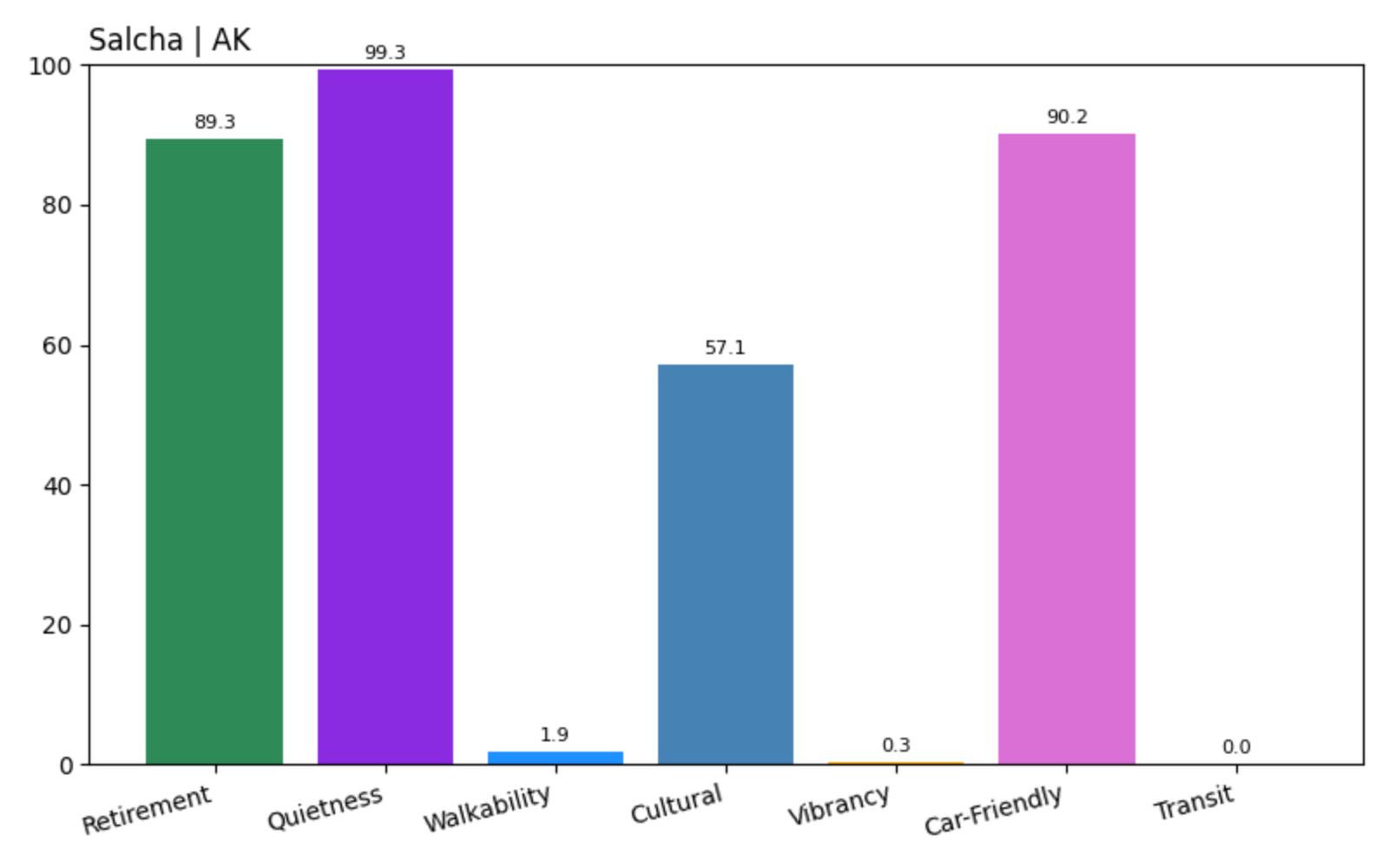
- Overall Retirement Score: 89.33
- Quietness: 99.35
- Walkability: 1.85
- Cultural amenities: 57.08
- Vibrancy: 0.30
- Car‑Friendliness: 90.16
- Transit‑Friendliness: 0.00
Salcha’s ORS of 89.33 underscores its near‑perfect calm and strong cultural ties to heritage events, balanced by minimal sidewalks and no transit. It’s a dream for retirees who trade busy streets for riverside reflections.
12. Cordova — Seismic Shores and Seafood Rituals

Cordova rises where Prince William Sound’s tidal surges meet echoes of the 1964 earthquake, now measured at a lively maritime museum. Retirees can tour the harbor’s seafood plants at dawn, sampling fresh catches at the boardwalk market, then join tide‑pool explorations under rugged cliff faces. Each evening, foghorns lull the town to a peaceful hush.
Homes list around $395,000 as of June 2025, many within walking distance of clinics and art galleries. Without road links, Cordova relies on ferries and flights—turning each supply run into a coastal voyage. For retirees drawn to island logistics and daily seafood spectacles, Cordova’s shores deliver both challenge and charm.
Cordova — ORS 90.15
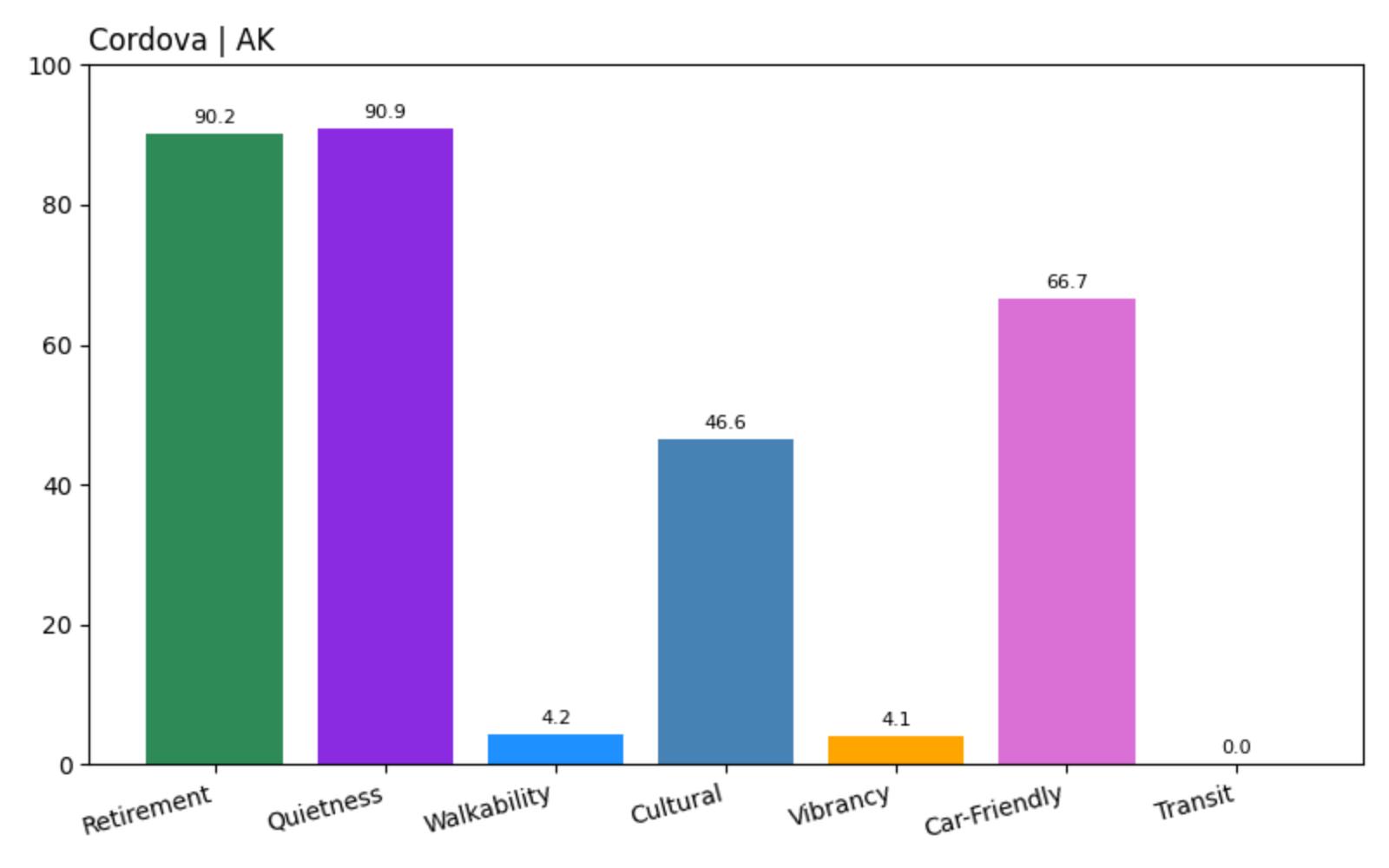
- Overall Retirement Score: 90.15
- Quietness: 90.88
- Walkability: 4.21
- Cultural amenities: 46.58
- Vibrancy: 4.10
- Car‑Friendliness: 66.67
- Transit‑Friendliness: 0.00
With an ORS of 90.15, Cordova balances strong serenity and cultural rites with the quirks of ferry‑only access. Retirees embrace planning ahead for supplies in exchange for daily views of seafood harvests and sound‑scoured cliffs.
11. Seldovia — Boardwalks and Gallery Windows

Seldovia’s single main street floats on a wooden boardwalk above Kachemak Bay’s tide‑tossed waters, where retirees peek into art galleries displaying driftwood sculptures and local photography. Mornings might find you sampling freshly baked scones at the café, then hiking forest trails dotted with hidden coves. The sound of harbor seals echoes beneath a canopy of sailboat masts.
Median homes near $425,000 as of June 2025 offer cozy porches and private docks. With no roads linking to the peninsula, Seldovia depends on the ferry schedule—turning each trip into a shoreline adventure. A volunteer fire brigade and tiny general store cover basics, while summer potlucks and art walks fill the evenings with community warmth.
Seldovia — ORS 90.62
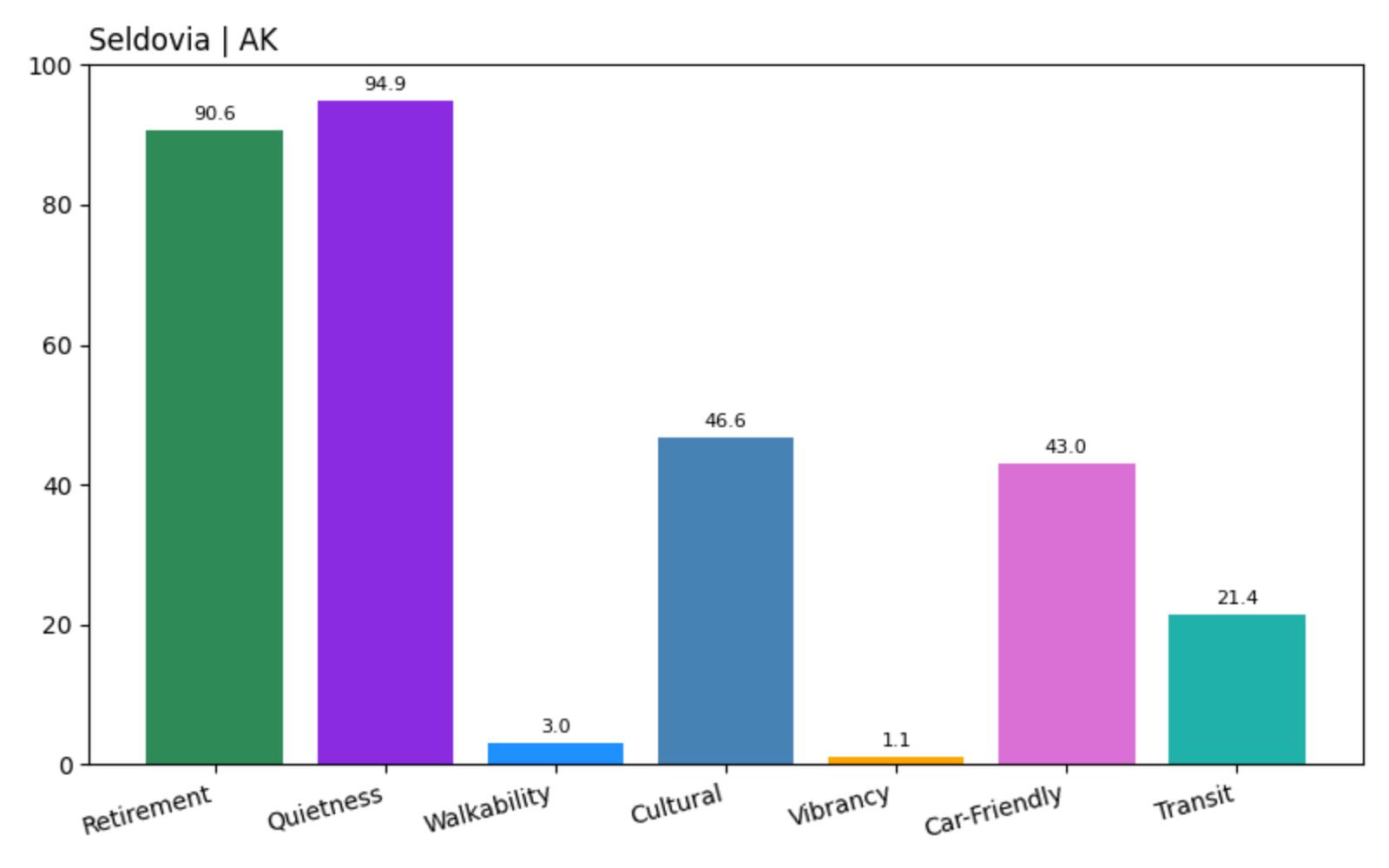
- Overall Retirement Score: 90.62
- Quietness: 94.89
- Walkability: 2.96
- Cultural amenities: 46.65
- Vibrancy: 1.06
- Car‑Friendliness: 43.01
- Transit‑Friendliness: 21.40
An ORS of 90.62 highlights Seldovia’s peace and artistic heartbeat, balanced by minimal walkways and ferry timetables. Retirees treasure the island’s boardwalk pace and gallery gatherings above all else.
10. Homer — Spitside Studios and Bayfront Breezes

Homer’s famous Spit stretches into Kachemak Bay like a natural boardwalk, where retirees browse art galleries and settle into seaside cafés for smoked salmon breakfasts. Tide pools reveal starfish at low water, while the Downtown Rotary Park hosts summer music and food truck gatherings. Mornings often begin with pelicans diving for fish just offshore, and evenings close out with live theater at the small community playhouse.
As of June 2025, homes in Homer average about $530,000, many with ocean views or easy access to forested trails. The city supports a full hospital, two grocery stores, and an airport with daily flights to Anchorage. Despite its artsy vibe, Homer retains a friendly small‑town feel—perfect for retirees who want cultured days by the water and reliable services close at hand.
Homer — ORS 91.29
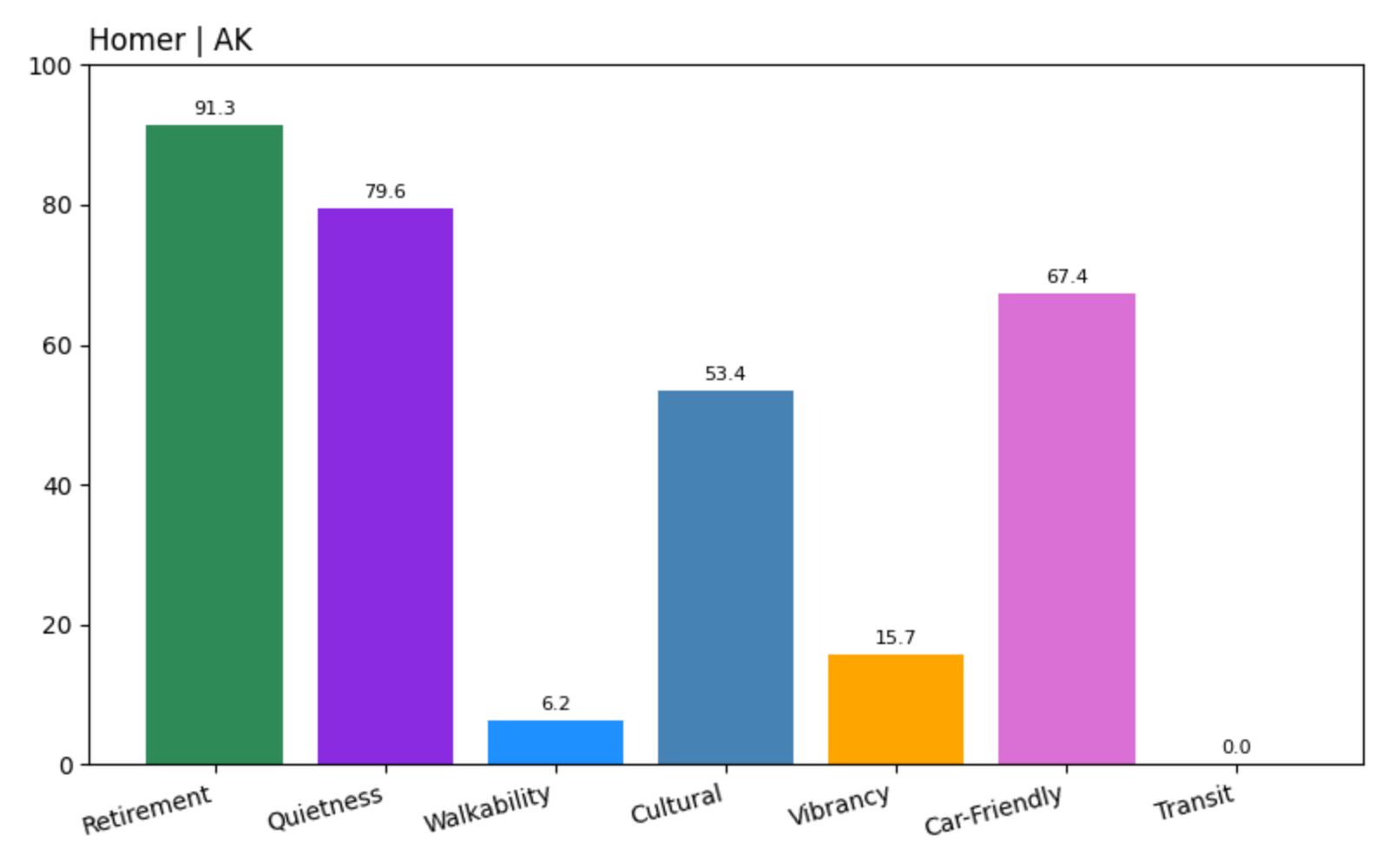
- Overall Retirement Score: 91.29
- Quietness: 79.60
- Walkability: 6.19
- Cultural amenities: 53.36
- Vibrancy: 15.66
- Car‑Friendliness: 67.44
- Transit‑Friendliness: 0.00
An ORS of 91.29 shows Homer balancing coastal calm with lively arts and festivals. Walkability and transit are low, so a car helps—but retirees gain a hospital, galleries, and ocean views in one vibrant package.
9. Seward — Rails, Reefs, and Resilient Seaside Life

Seward sits at the end of the Alaska Railroad, where tracks meet Resurrection Bay’s deep waters. Retirees board vintage railcars for scenic trips to Anchorage or join marine scientists at the Alaska SeaLife Center studying otters and seabirds. Harborfront trails lead past old cannery ruins to tide‑pool coves, and the small downtown clinic keeps essential care within reach.
In June 2025, median home prices hovered in the mid‑$300,000s, with many cabins and cottages tucked behind fjord‑framed streets. A handful of grocery stores, coffee shops, and art galleries line Fourth Avenue, while kayaking and hiking launch points punctuate the town’s edges. Seward suits retirees who want rugged beauty, rail access, and a dose of town‑center convenience.
Seward — ORS 92.13
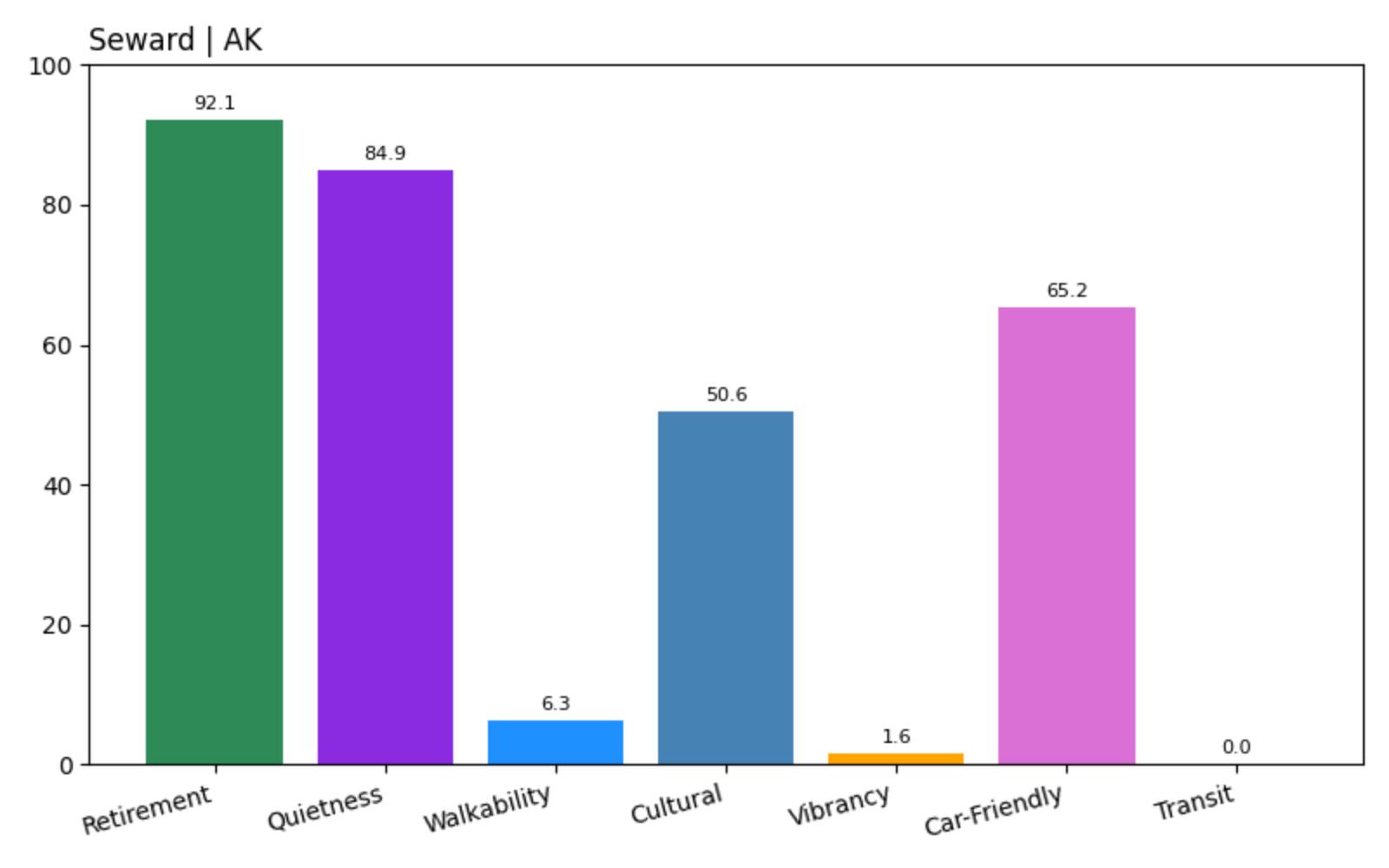
- Overall Retirement Score: 92.13
- Quietness: 84.92
- Walkability: 6.34
- Cultural amenities: 50.56
- Vibrancy: 1.61
- Car‑Friendliness: 65.24
- Transit‑Friendliness: 0.00
With a 92.13 ORS, Seward earns points for cultural draw and scenic rail access, even as nightlife stays subdued. A car makes errands easier, but retirees gain marine research, trailheads, and small‑town services in equal measure.

Known as “Little Norway,” Petersburg blends wooden fish houses and knitted sweaters into a vibrant coastal tapestry. Retirees stroll the icehouse docks to watch fishing boats offload king salmon, then warm up at the knitting festival or sip local brews at the annual beer fest. Totem‑pole parks and a small historical museum add layers of heritage to daily life.
Homes list in the low‑to‑mid $400,000s, many within walking distance of the Petersburg Medical Clinic and community hospital. A public library hosts evening lectures, and a seasonal ferry connects Mitkof Island to neighboring towns. For retirees seeking tight‑knit festivals, ocean breezes, and Balkan‑style hospitality, Petersburg delivers both charm and care.
Petersburg — ORS 92.25
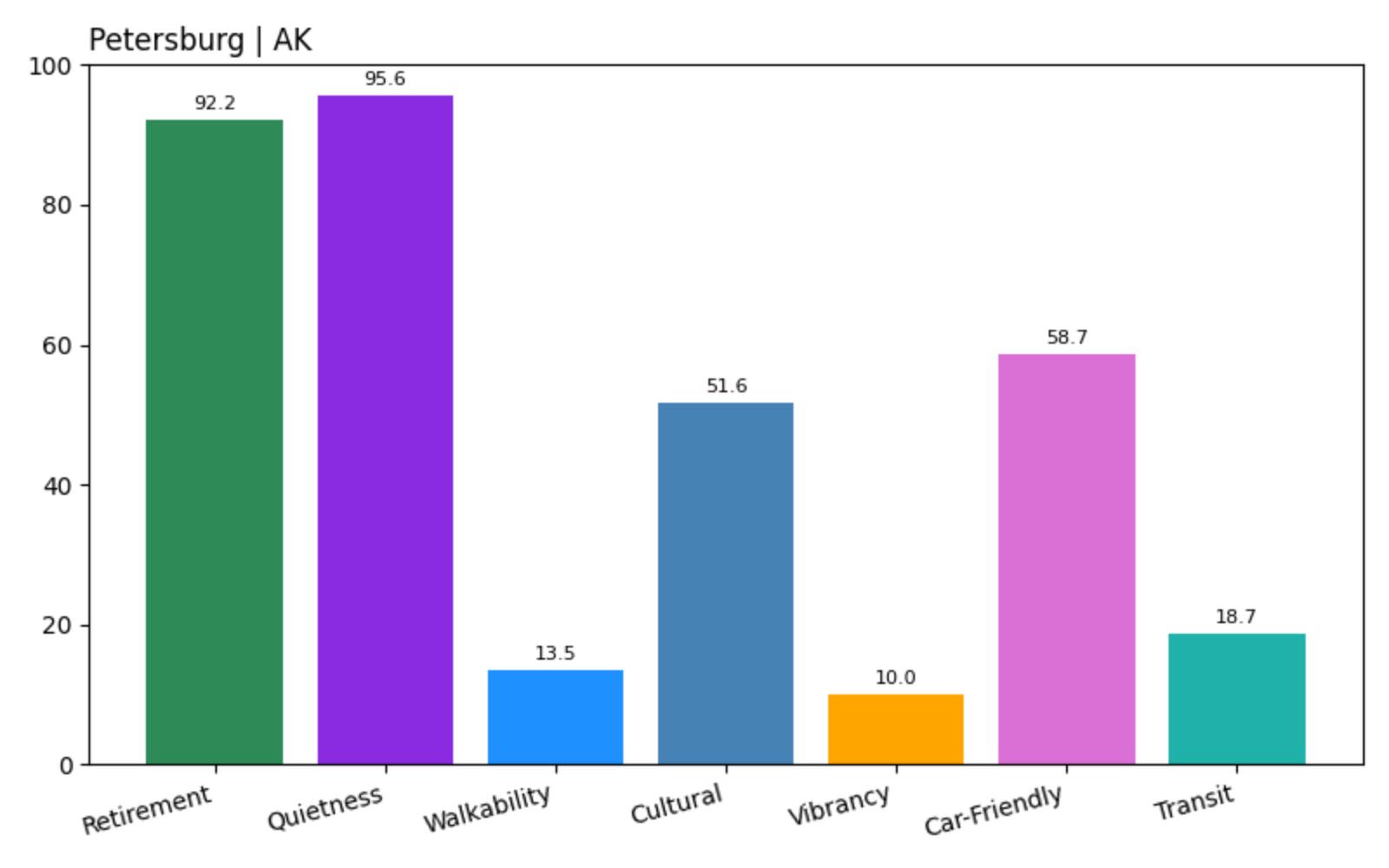
- Overall Retirement Score: 92.25
- Quietness: 95.64
- Walkability: 13.50
- Cultural amenities: 51.64
- Vibrancy: 9.96
- Car‑Friendliness: 58.74
- Transit‑Friendliness: 18.74
Petersburg’s 92.25 ORS reflects its serene streets and lively cultural calendar. Good walkability around the harbor and modest transit keep errands easy—ideal for retirees who love festivals and fish wharves.
7. Gustavus — Glacier Bay’s Quiet Companion
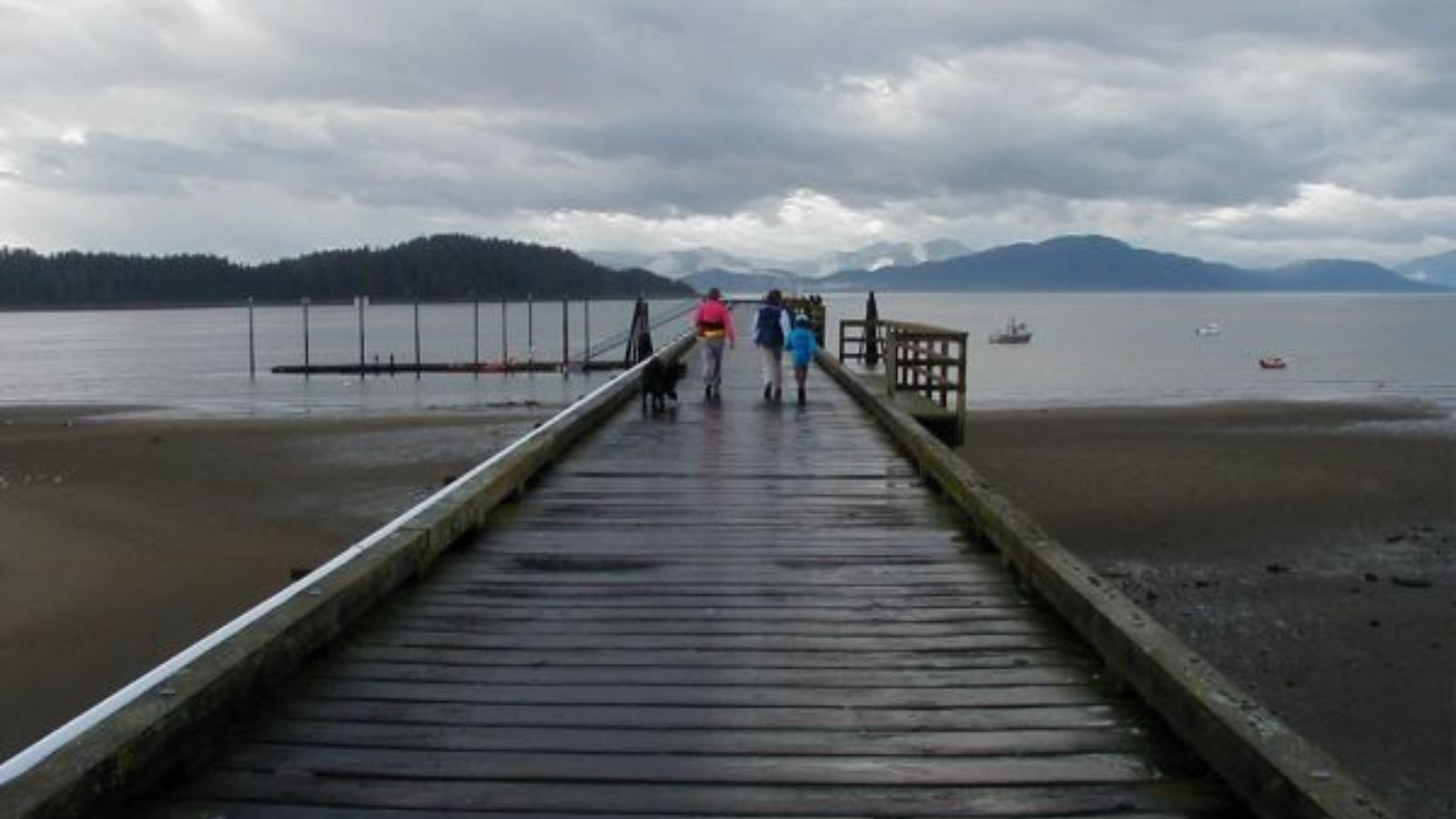
Gustavus unfolds at the edge of Glacier Bay National Park, where retirees can follow boardwalks through tide‑pools by morning and join ranger‑led glacier cruises by afternoon. Local cafés serve fresh seafood beside interpretive panels about humpback whales, while forest trails beckon with wildflower carpets under midnight sun.
As of June 2025, homes in Gustavus average in the high‑$300,000s, often with views of ice‑calved fjords. A small K–12 school, health clinic, and a couple of cafés constitute town life, while no formal transit emphasizes the need for a personal vehicle. Retirees who prize park‑front living and year‑round wilderness access find Gustavus quietly unbeatable.
Gustavus — ORS 93.21
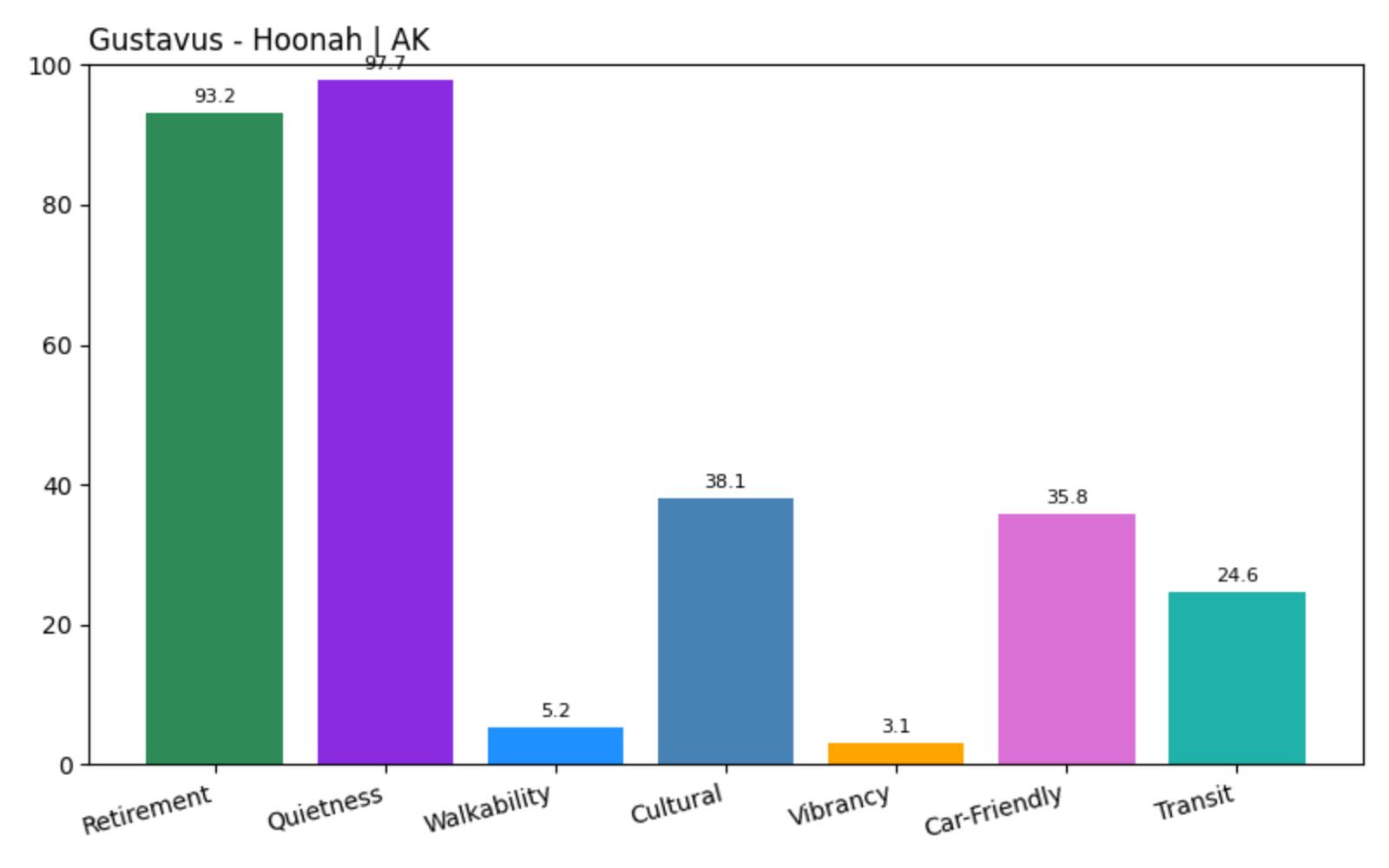
- Overall Retirement Score: 93.21
- Quietness: 97.74
- Walkability: 5.23
- Cultural amenities: 38.08
- Vibrancy: 3.15
- Car‑Friendliness: 35.76
- Transit‑Friendliness: 24.59
Gustavus’s ORS of 93.21 highlights its unmatched peace and park‑driven culture. Limited walkways and no transit mean driving is key, but retirees gain direct gate‑keeper status to one of America’s wildest places.
6. Thorne Bay — Forest Quiet and Fishing Heritage
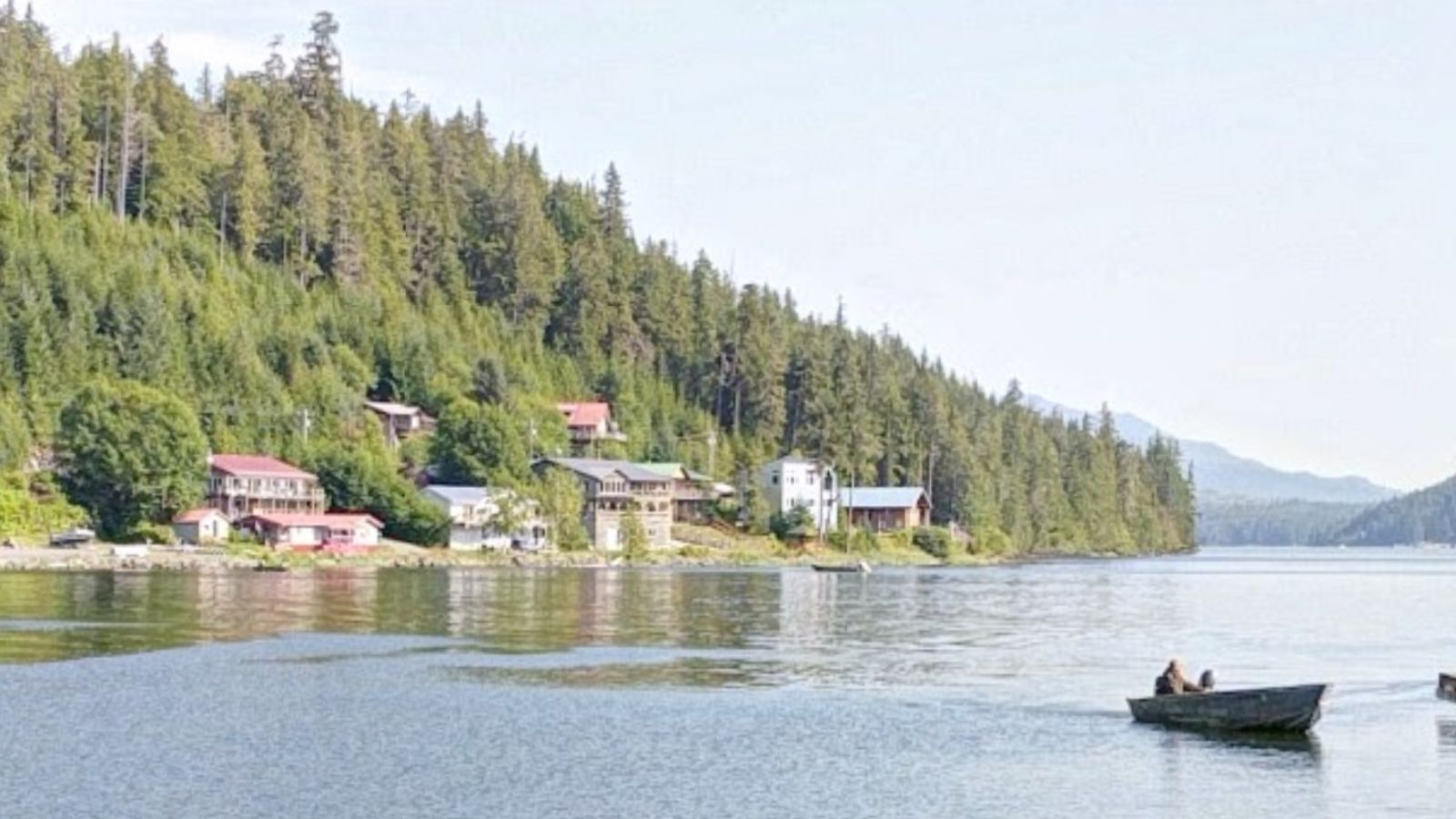
Thorne Bay’s still waters mirror rainforest peaks, creating an almost otherworldly calm for retirees seeking true solitude. Once a bustling logging camp, it now offers forest‑edge cabins and community fish derbies on the bay’s quiet mornings. Berry‑picking harvests and totem‑pole heritage tours fill summer calendars without the rush of bigger towns.
Median home prices sit in the low‑$200,000s as of June 2025, with simple homes and lodges scattered among cedar groves. A single general store, volunteer fire department, and small clinic cover the basics, while a gravel road links the bay to island ferry docks. For retirees drawn to forest trails and fish‑camp camaraderie, Thorne Bay strikes a rare balance of history and hush.
Thorne Bay — ORS 93.41
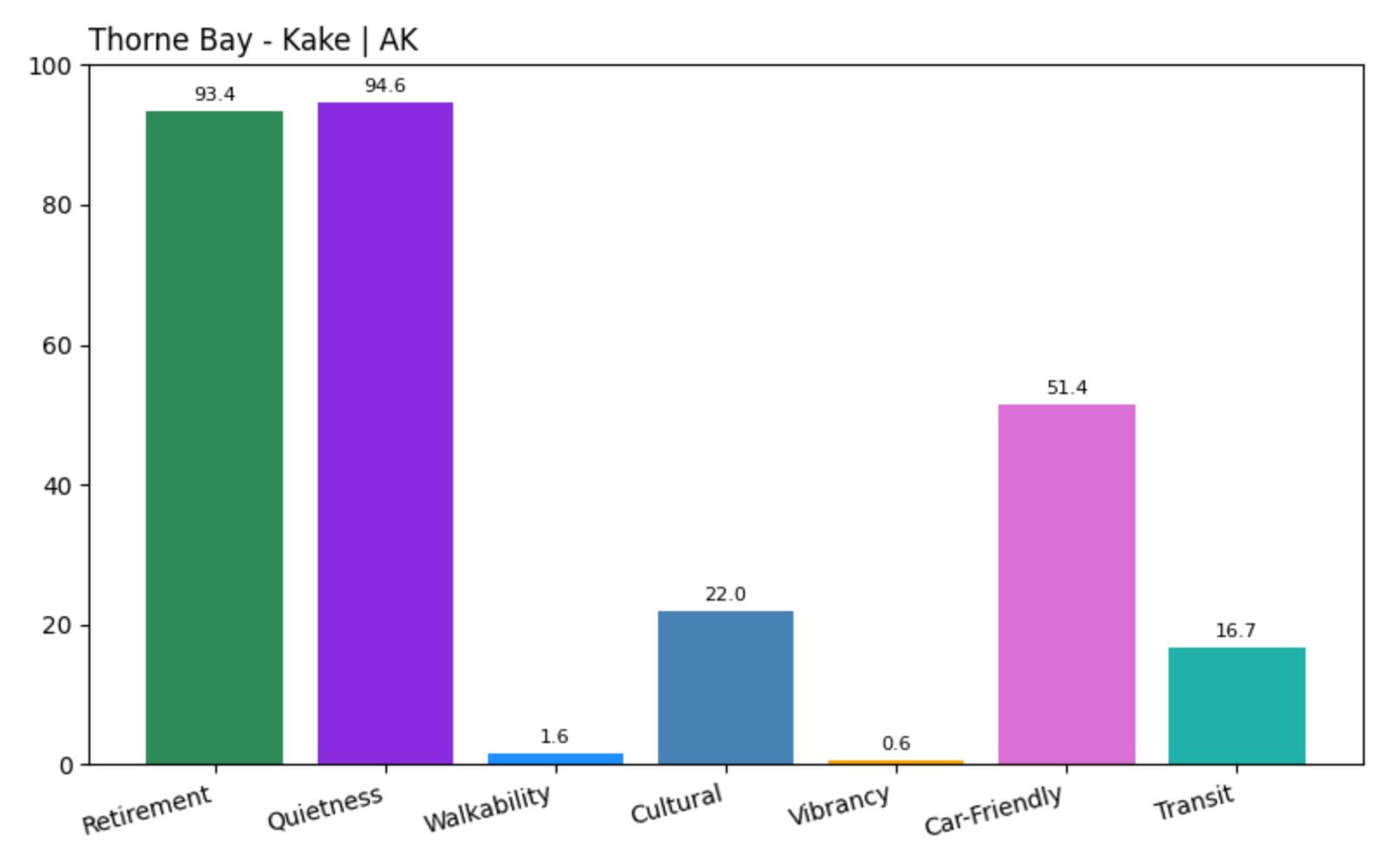
- Overall Retirement Score: 93.41
- Quietness: 94.60
- Walkability: 1.55
- Cultural amenities: 21.97
- Vibrancy: 0.61
- Car‑Friendliness: 51.44
- Transit‑Friendliness: 16.70
With an ORS of 93.41, Thorne Bay combines high tranquility with fishing‑camp culture—but you’ll need a car for errands. Retirees prize winding forest roads and seasonal festivals over city lights and sidewalks.
5. Cooper Landing — River Rhapsody and Mountain Retreat

Where the Kenai River tumbles out of Kenai Lake, Cooper Landing offers retirees a front-row seat to Alaska’s soundtrack: rushing whitewater, singing birds, and wind through spruce tops. Boutique lodges line the highway, inviting vacationers—and retirees—to join guided fly-fishing clinics or sip honey-sweet mead at the local brewery after a day on the river. The mountains stand guard overhead, promising endless trails and glacier views.
As of June 2025, Cooper Landing homes average about $320,000, many with riverfront decks and wooded yards. A small health clinic handles routine care, and charter flights out of the private airstrip whisk visitors away. For retirees drawn to first casts at dawn and cabin evenings by firelight, Cooper Landing feels like a private wilderness clubhouse.
Cooper Landing — ORS 95.37
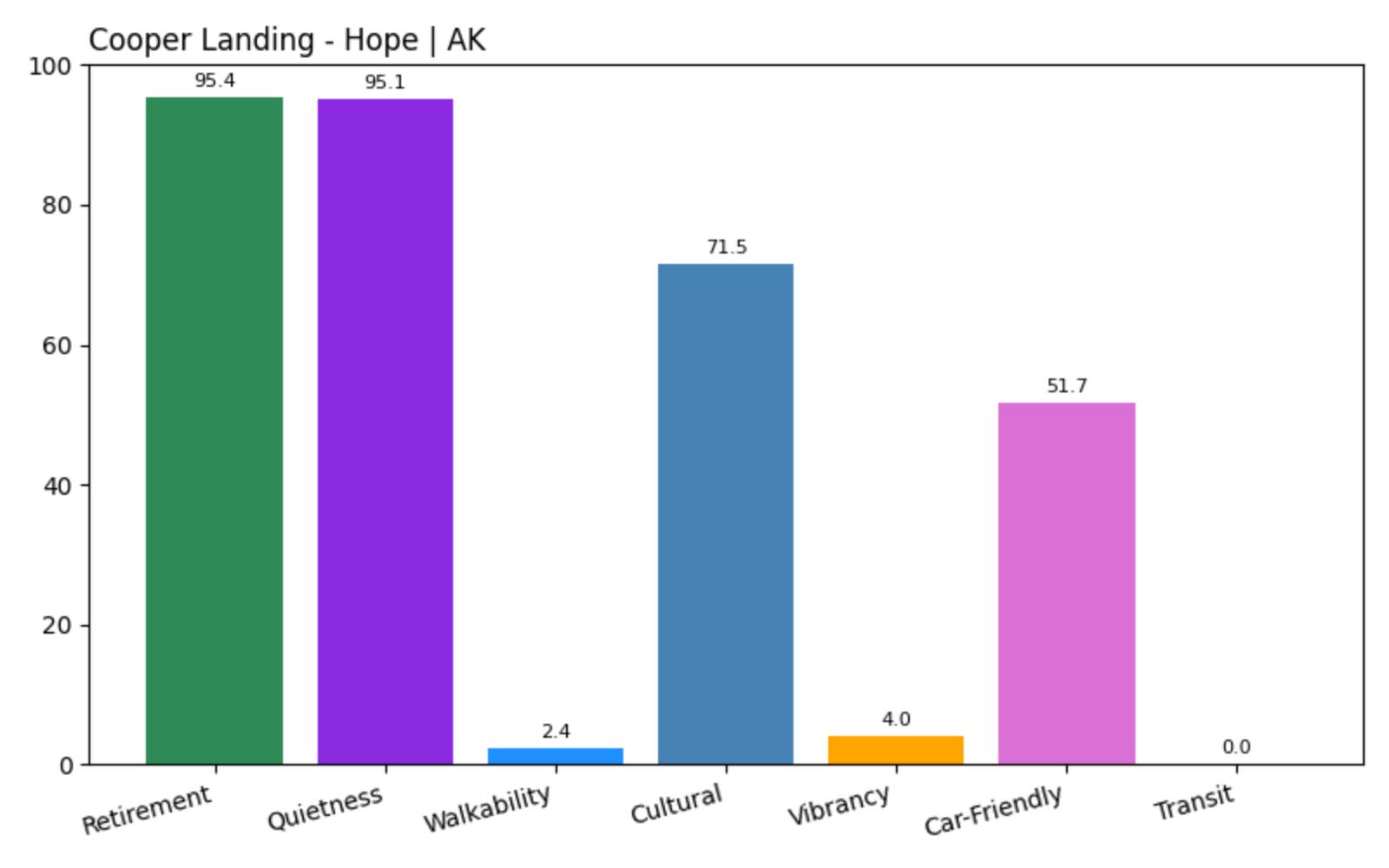
- Overall Retirement Score: 95.37
- Quietness: 95.10
- Walkability: 2.39
- Cultural amenities: 71.45
- Vibrancy: 4.00
- Car‑Friendliness: 51.66
- Transit‑Friendliness: 0.00
With an ORS of 95.37, Cooper Landing scores high for quiet and cultural draw—its river clinics and lodge events give retirees plenty to do. Low walkability and no transit make a car essential, but every drive doubles as a scenic adventure.
4. Healy – Cantwell — Coalfire Evenings and Denali Sunrises

Diego Delso, CC BY-SA 4.0, via Wikimedia Commons
At the edge of Denali National Park, Healy and Cantwell share a coiled energy: by day, hikers head into tundra meadows and mountain trails; by night, retirees gather at the Coal Miners’ Saloon for live music and craft brews. Historic mine tours reveal gray ruins lit by lantern glow, while Cantwell’s art booths and potluck suppers foster tight-knit friendship.
Median home prices sit near $260,000 as of June 2025, pairing rustic cabins with modern energy-efficiency. Healy’s health clinic and Cantwell’s general store cover basics, and Fairbanks is a two-hour dash down the highway. For retirees who want Denali’s grandeur in their backyard and coal-vein history at their doorstep, this duo delivers unmatched frontier flair.
Healy – Cantwell — ORS 95.53
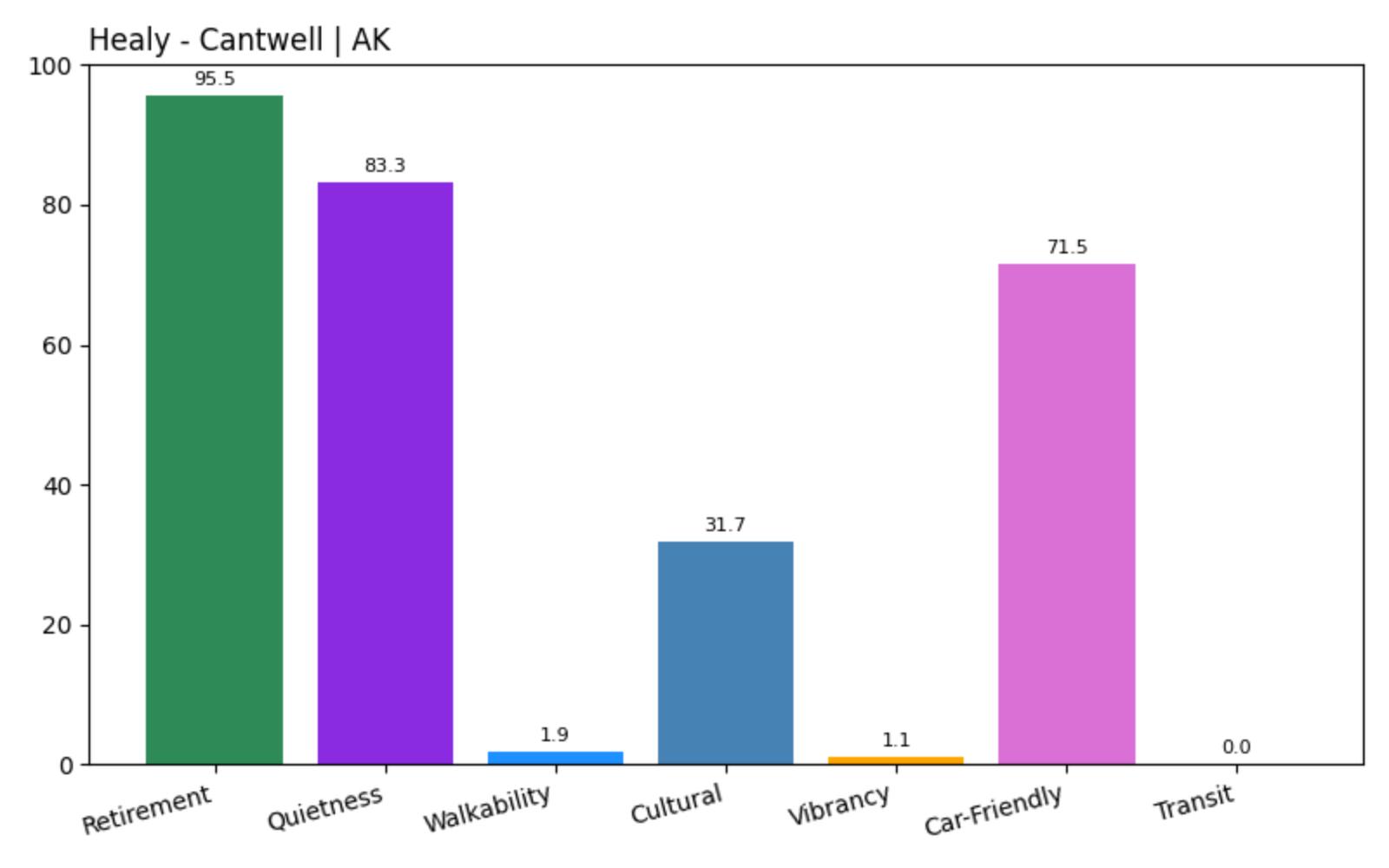
- Overall Retirement Score: 95.53
- Quietness: 83.27
- Walkability: 1.88
- Cultural amenities: 31.74
- Vibrancy: 1.08
- Car‑Friendliness: 71.51
- Transit‑Friendliness: 0.00
A 95.53 ORS highlights high quiet and the allure of park-edge living, balanced by sparse sidewalks and no transit. Retirees here lean on cars for errands but gain direct access to Denali’s epic sunrise scenes and coal-country heritage.
3. Hyder — Border Whispers and Bear-Viewing Flights
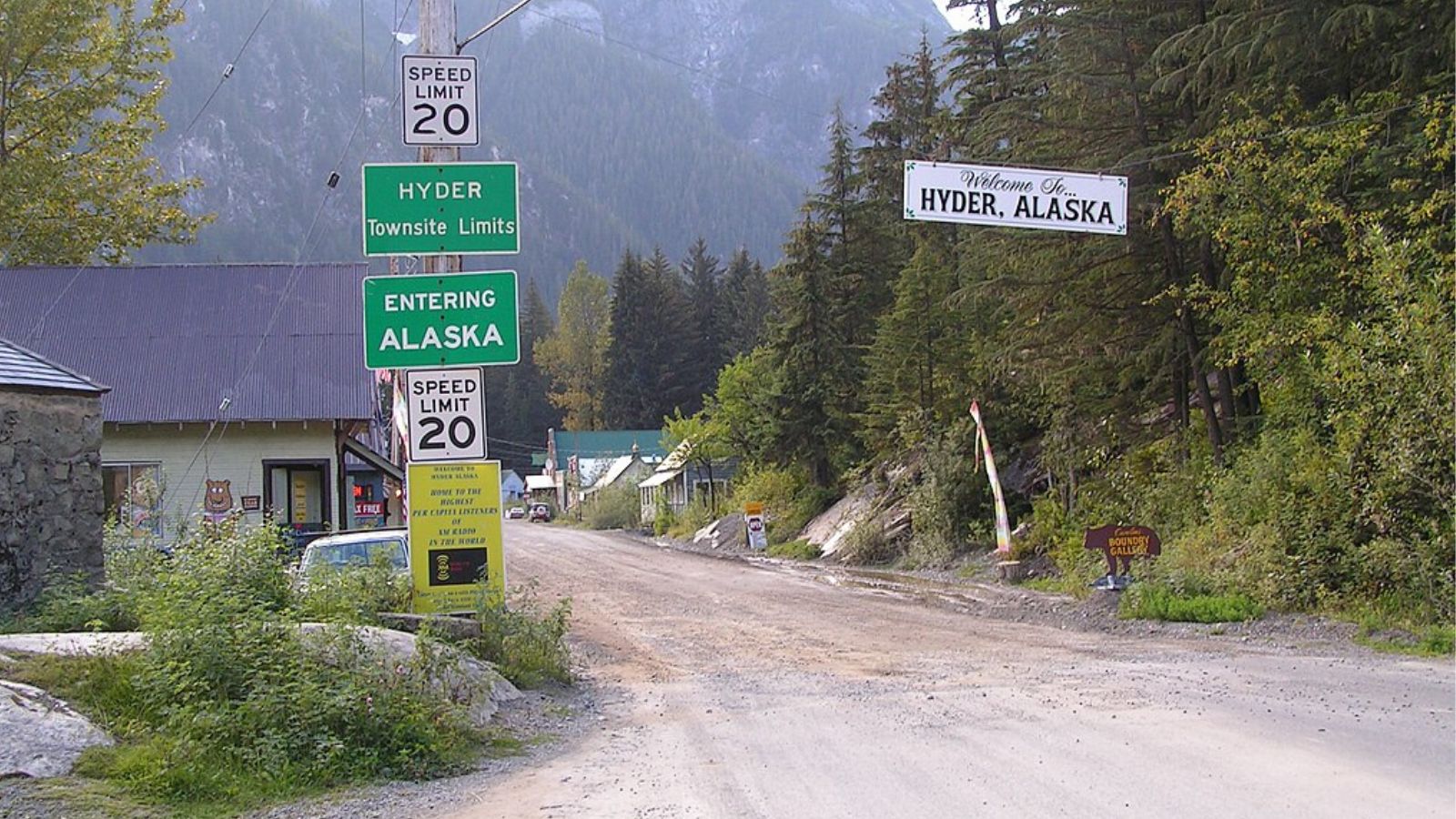
Hyder hangs on the U.S.–Canada border like a best-kept secret: beyond the chain-link fence lies Stewart’s shops, while on the Alaska side, retirees sip tea in blink-and-you’ll-miss-it cafés. Nearby, bears dine at the Salmon Glacier overlook, drawing wildlife photographers and retirees eager for front-row nature seats—often shared by moose and peregrine falcons.
Homes list around $250,000 as of June 2025, many in clustered neighborhoods just steps from international crosswalks. A volunteer fire crew and tiny clinic offer basics, while Stewart’s small stores fill in any gaps. For retirees who relish everyday life straddling two countries and wildlife shows on their doorstep, Hyder feels like an exclusive nature sanctuary.
Hyder — ORS 95.83
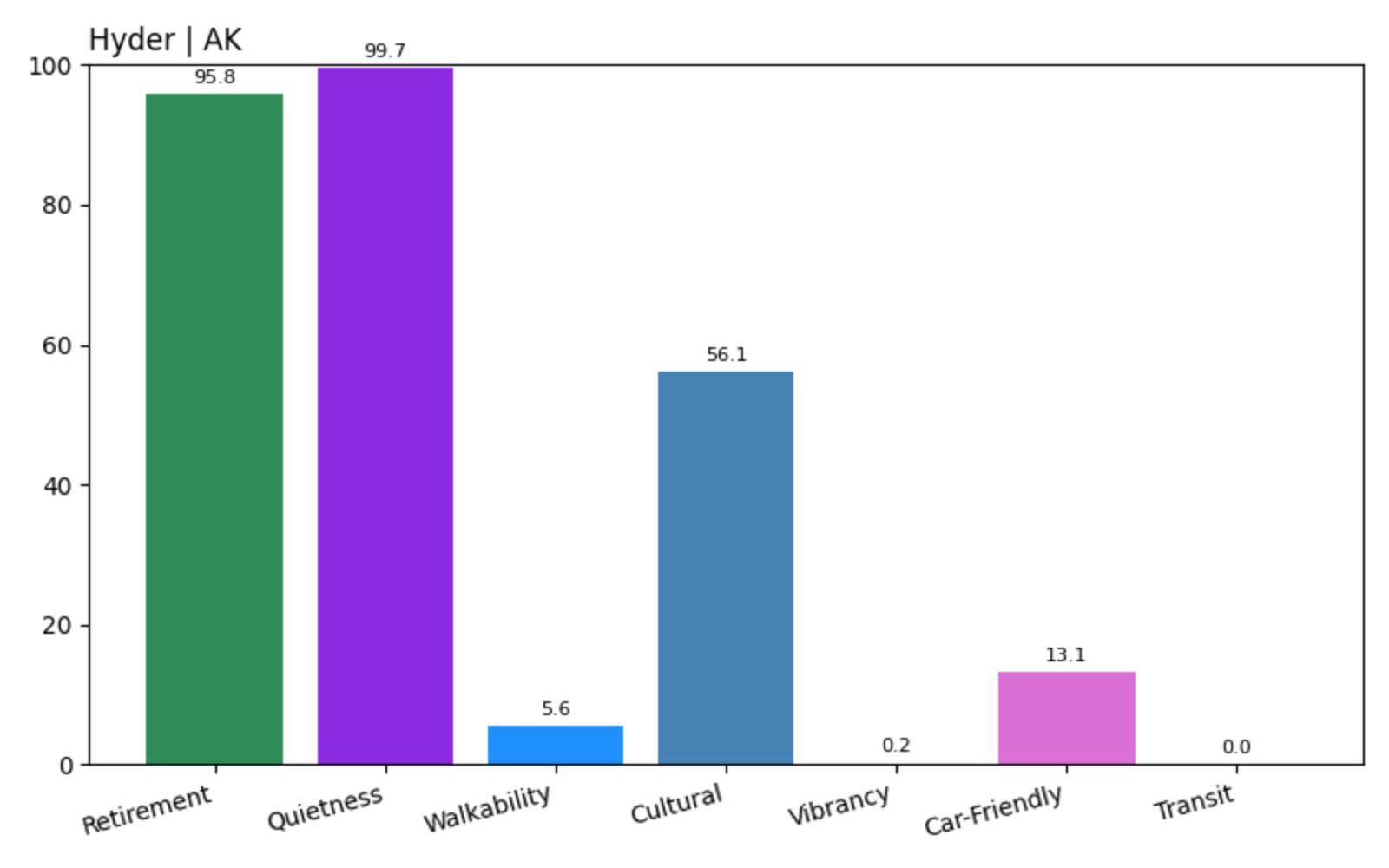
- Overall Retirement Score: 95.83
- Quietness: 99.67
- Walkability: 5.60
- Cultural amenities: 56.15
- Vibrancy: 0.19
- Car‑Friendliness: 13.14
- Transit‑Friendliness: 0.00
Hyder’s ORS of 95.83 underscores near-total tranquility and easy cross-border access, offset by minimal roads. Retirees here trade city noise for bear serenades and international convenience at a walking pace.
2. Wrangell — Totem Guardians and Tidal Calm

On Wrangell Island’s emerald shores, retirees wander totem parks where ancestral carvings loom over tidal flats. Small fishing boats slip in at dawn, unloading fresh catch that finds its way to waterfront cafés by noon. Museums and artisan markets recall Tlingit heritage, while sunsets paint the inlet in calm lavender hues.
Median home prices hover near $370,000 as of June 2025, many within walking distance of the borough’s clinic and grocery. Seasonal ferry service links island communities, and local art workshops keep cultural life vibrant. For retirees seeking deep-rooted tradition, coastal serenity, and friendly neighbors, Wrangell strikes a perfect chord.
Wrangell — ORS 97.21
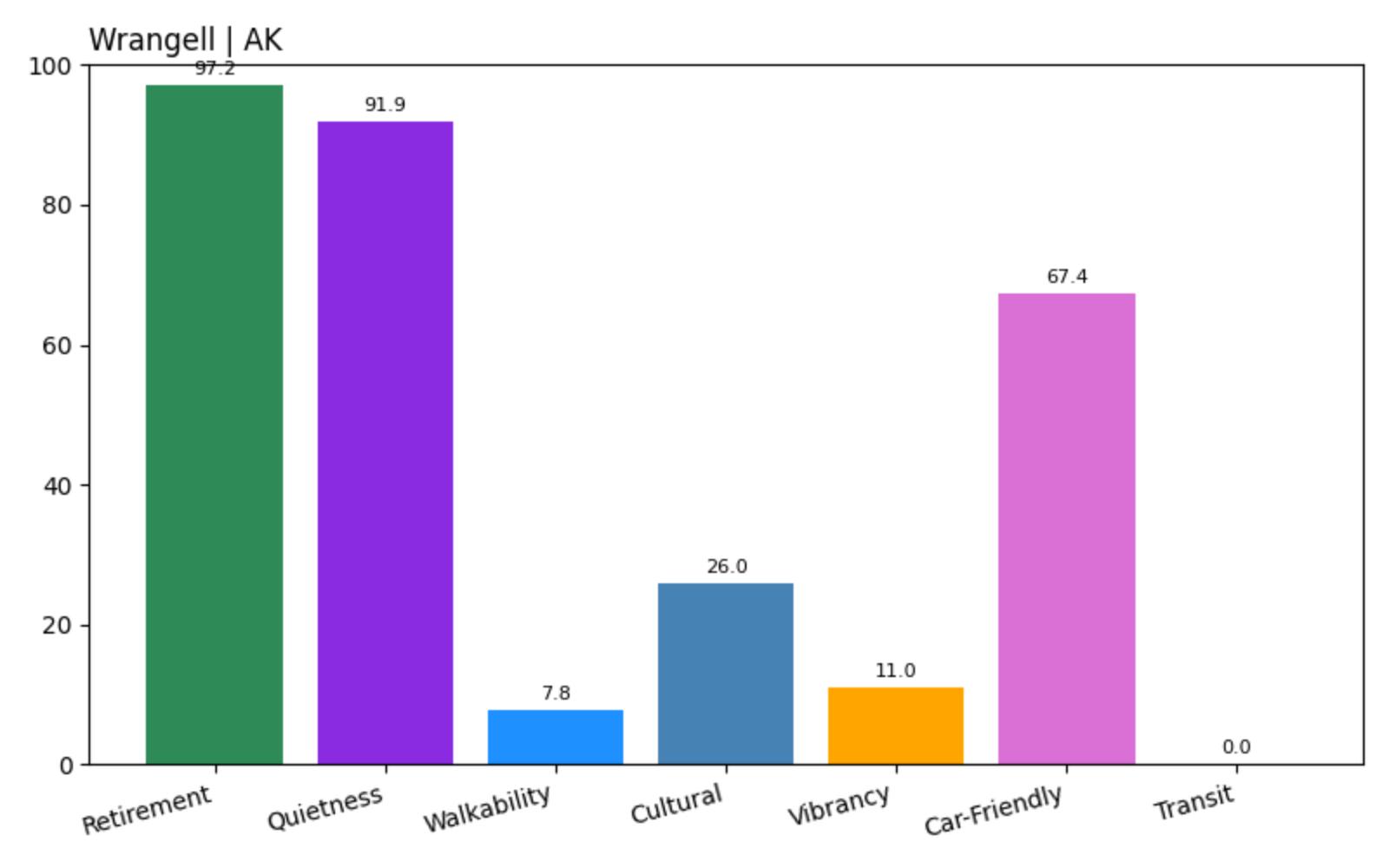
- Overall Retirement Score: 97.21
- Quietness: 91.92
- Walkability: 7.78
- Cultural amenities: 25.96
- Vibrancy: 11.00
- Car‑Friendliness: 67.42
- Transit‑Friendliness: 0.00
Wrangell’s ORS of 97.21 highlights strong quiet and cultural roots, with fair walkability and island calm. Retirees enjoy totem tales, museum digs, and fjord reflections just steps from their door.
1. Haines — Fjordfront Festivals and Glacier Gazing

Haines crowns the list with mountain-draped fjords and a cultural pulse that hums beneath endless skies. Retirees kayak alongside eagles at dawn, then join Chilkat Valley artists for weaving workshops in cedar-scented studios. Fall’s Chilkat Bald Eagle Festival brings international visitors, while summer’s Mariachi Fest adds festive brass and dance to the waterfront.
Median homes list near $450,000 as of June 2025, many perched above harbor vistas. A full hospital, arts center, and ferry terminal make daily life smooth, even as mountain roads remind residents they’ve escaped the ordinary. For retirees craving panoramic glaciers, vibrant festivals, and fjordfront peace, Haines delivers Alaska’s ultimate retirement panorama.
Haines — ORS 98.98
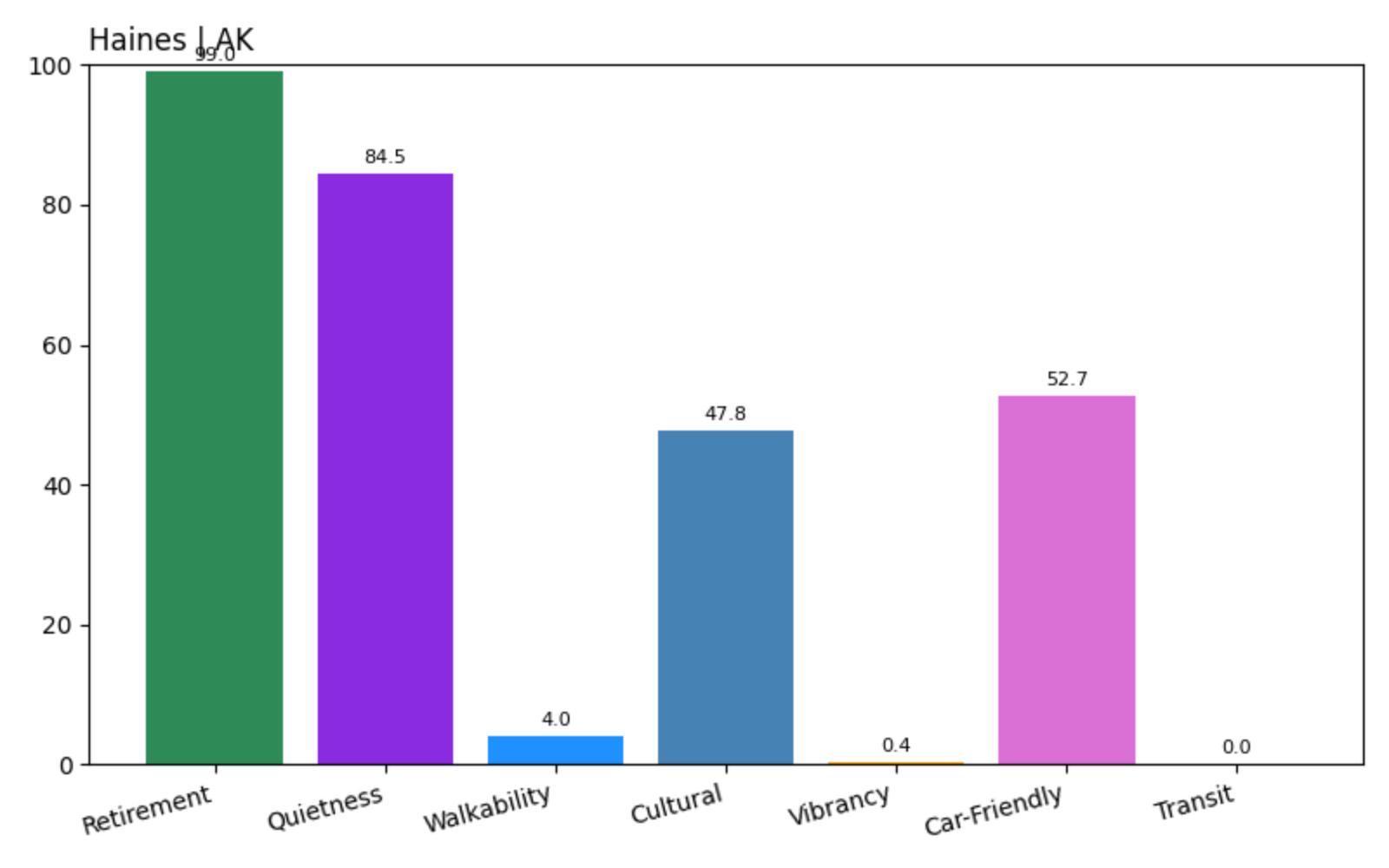
- Overall Retirement Score: 98.98
- Quietness: 84.52
- Walkability: 4.05
- Cultural amenities: 47.78
- Vibrancy: 0.42
- Car‑Friendliness: 52.72
- Transit‑Friendliness: 0.00
With an ORS of 98.98, Haines stands as Alaska’s retirement pinnacle: festival flair meets glacier glory. Sidewalks are spare, and a car helps—but every journey unfolds across breathtaking fjords and mountain canopies.


